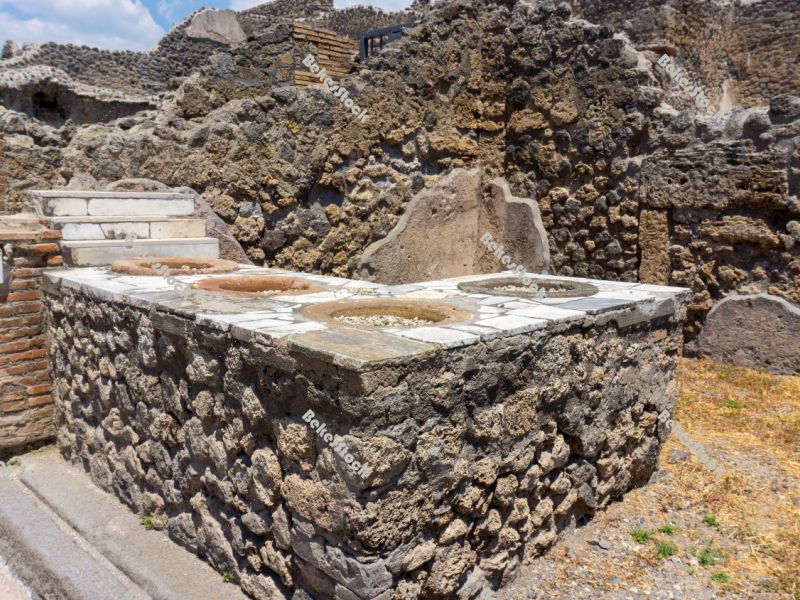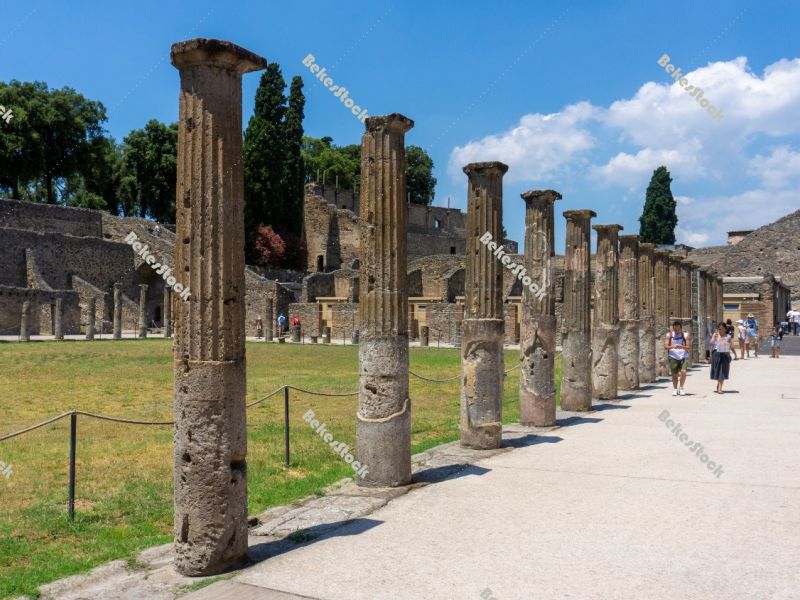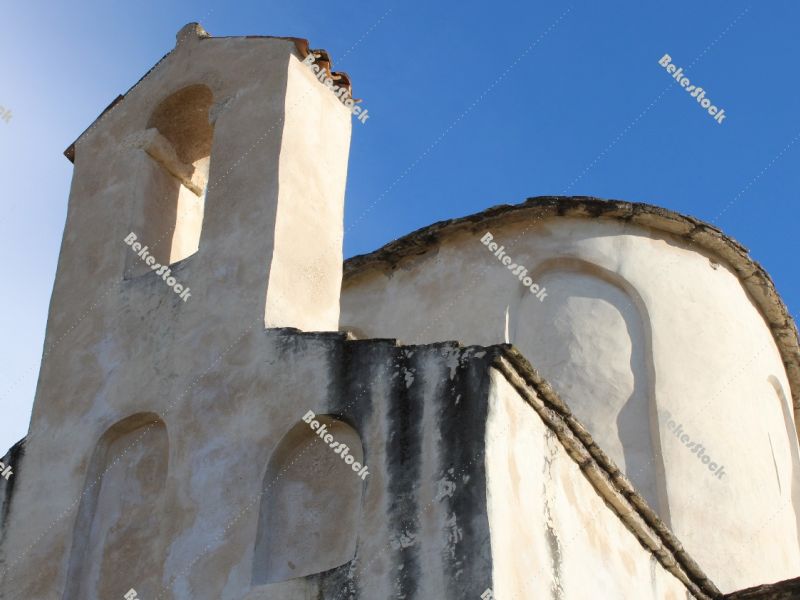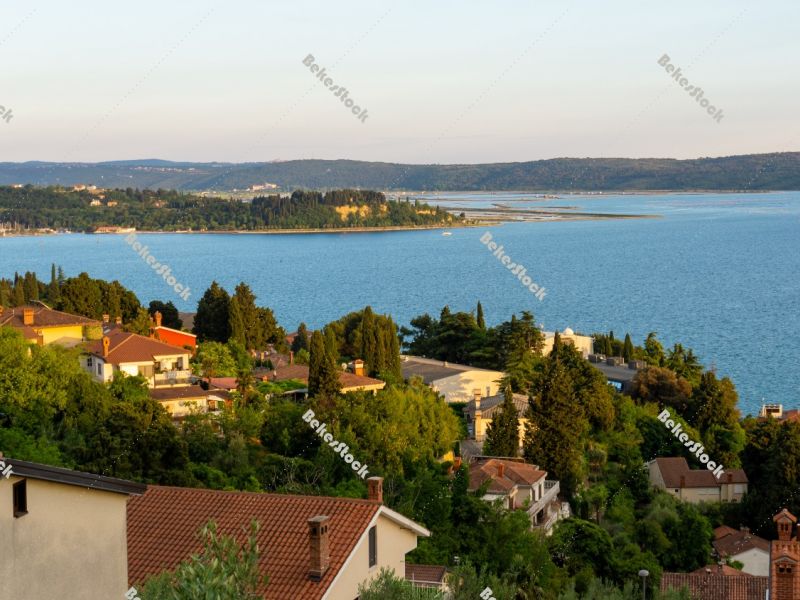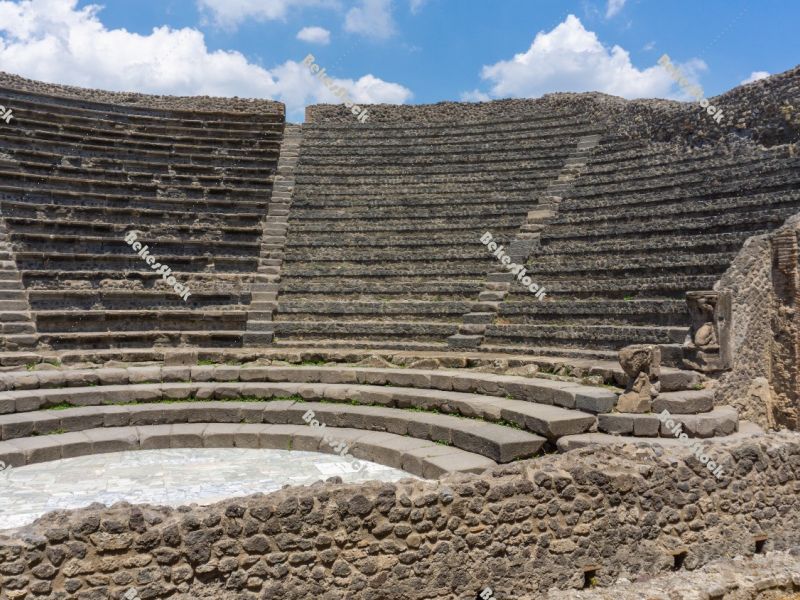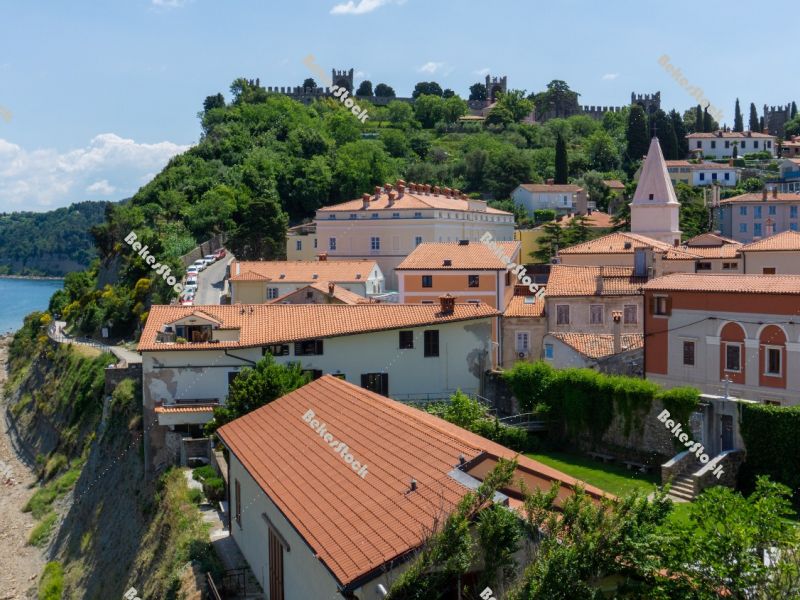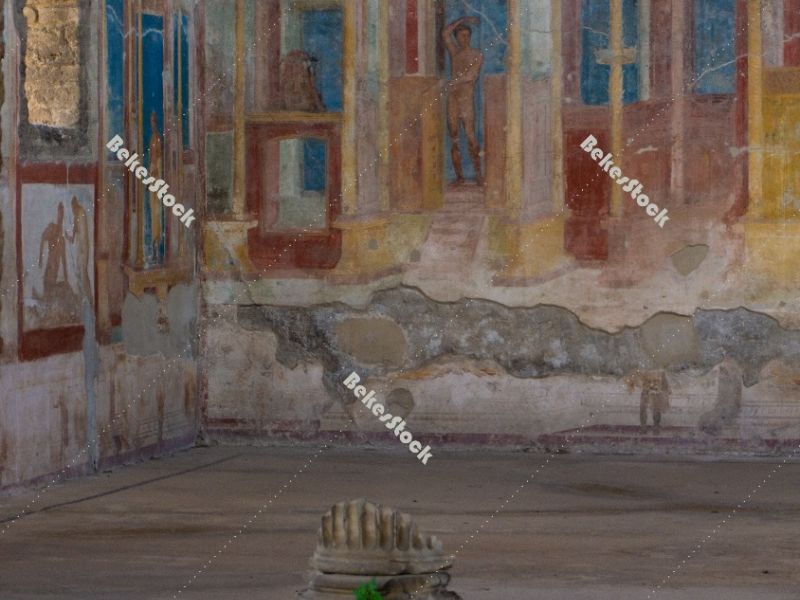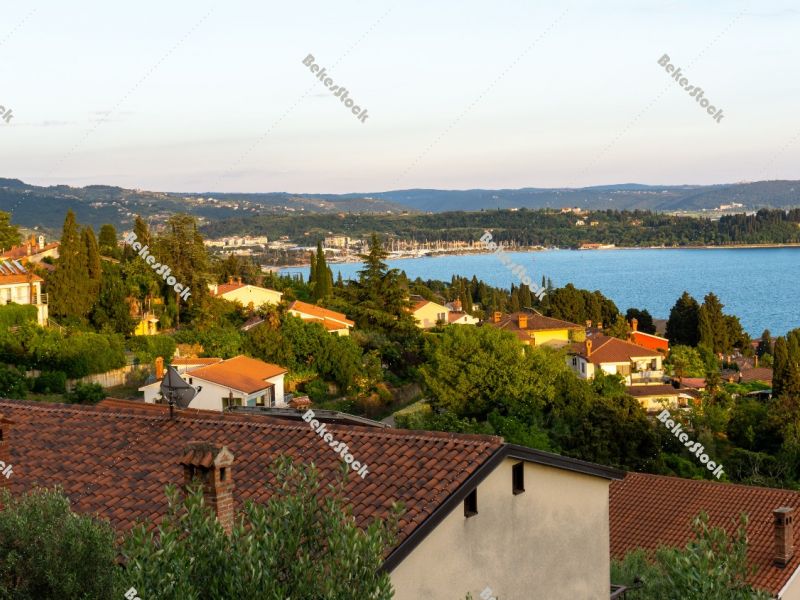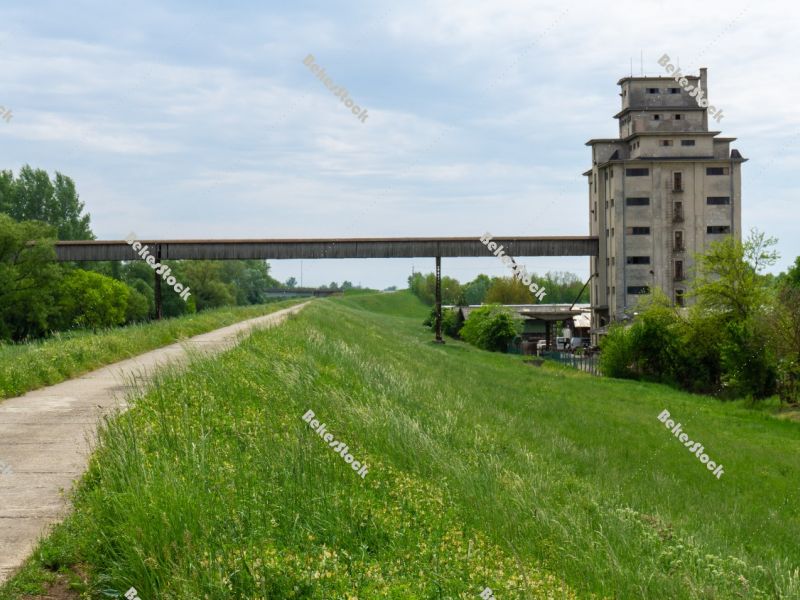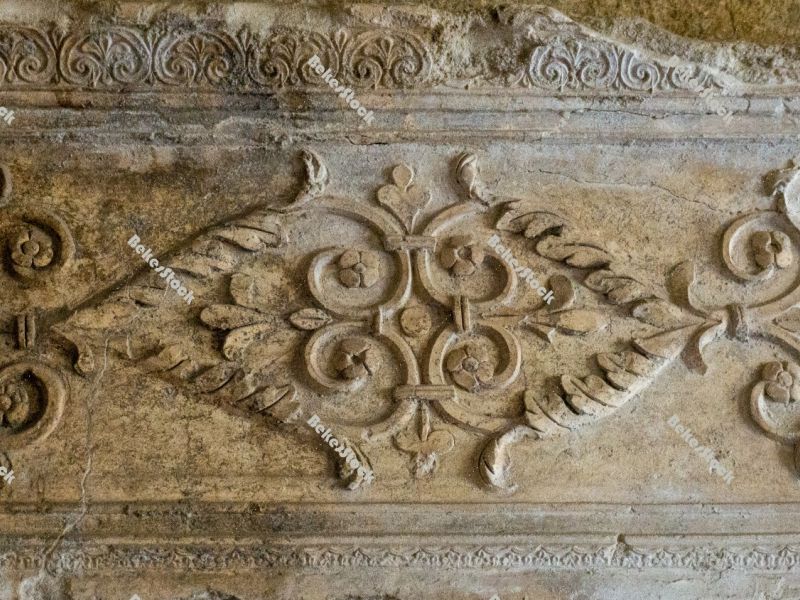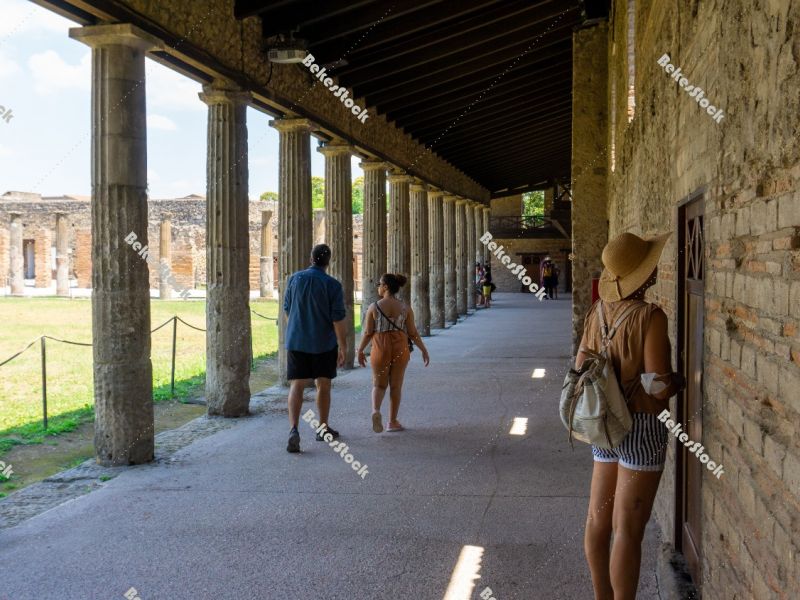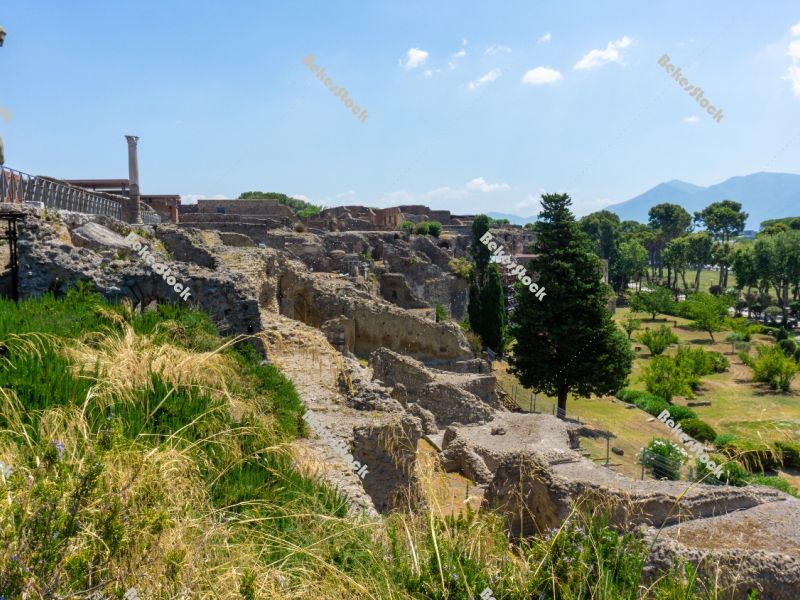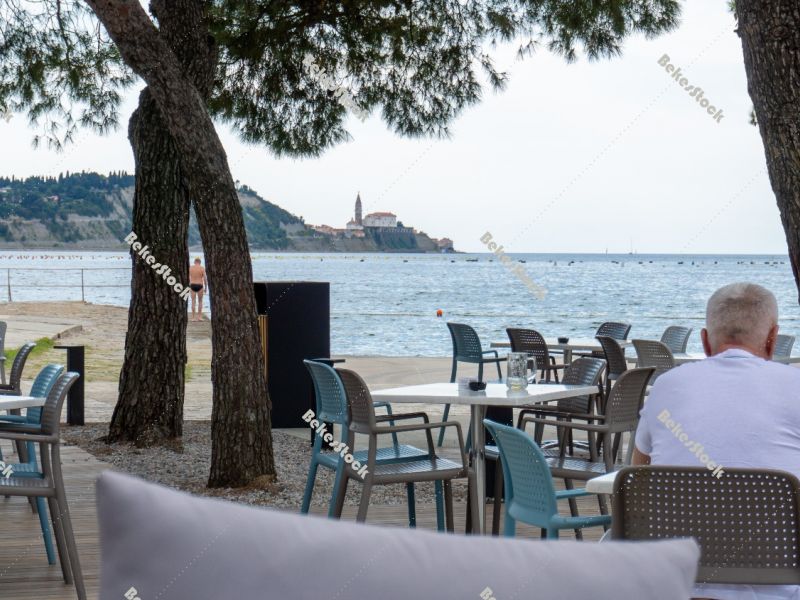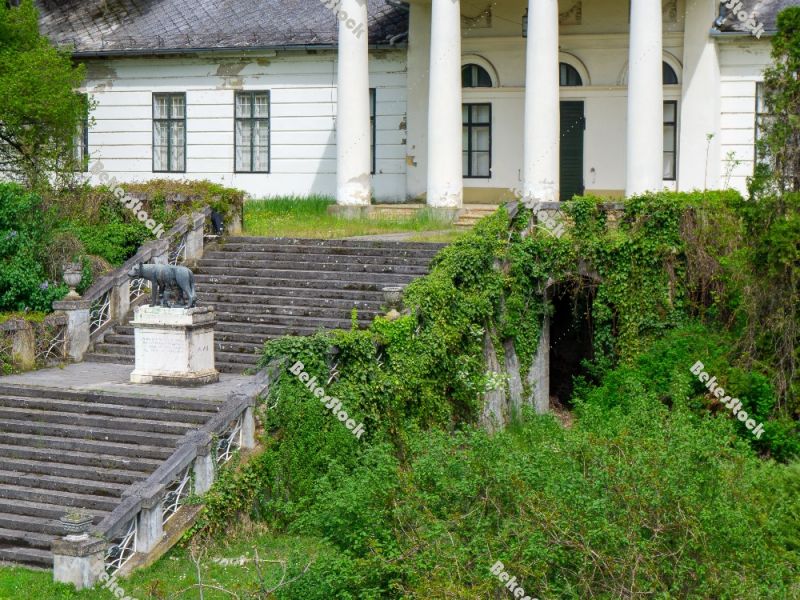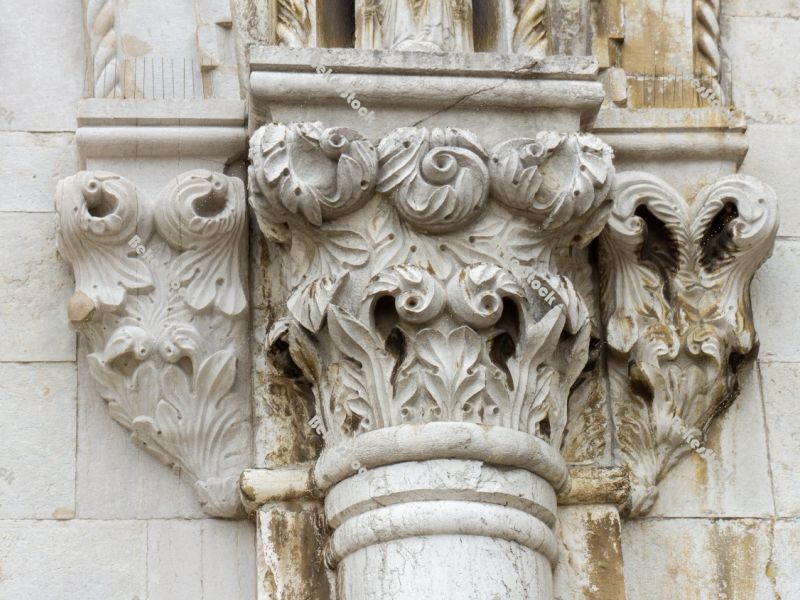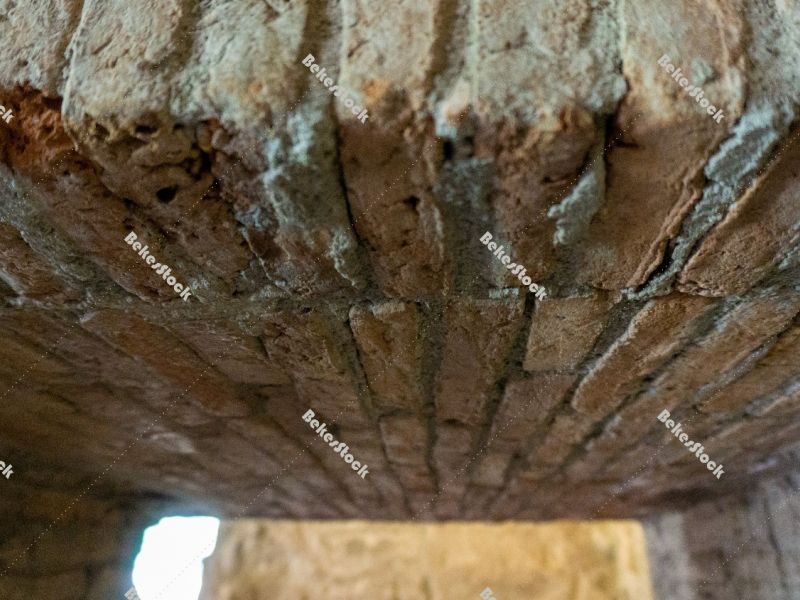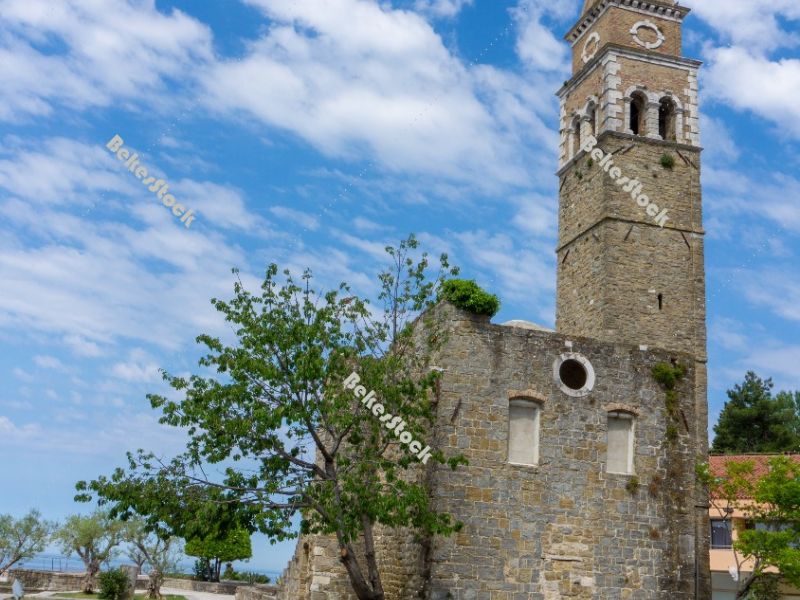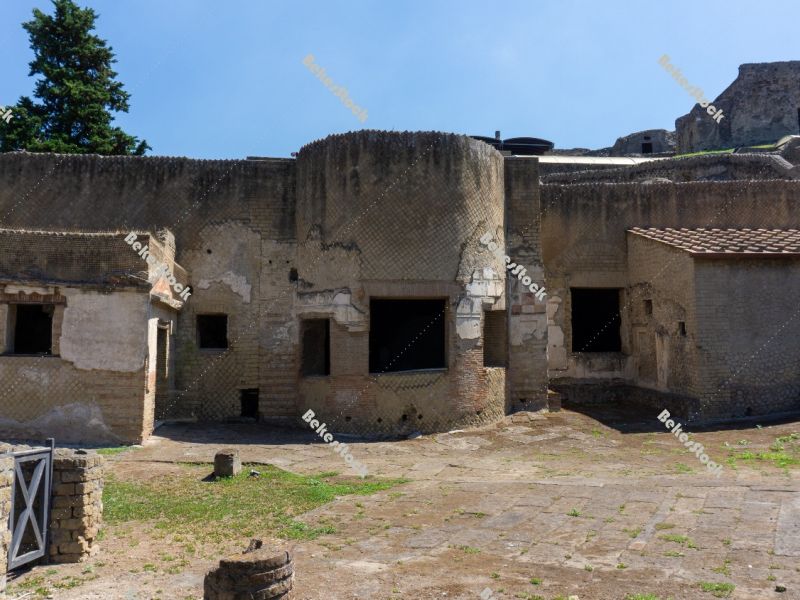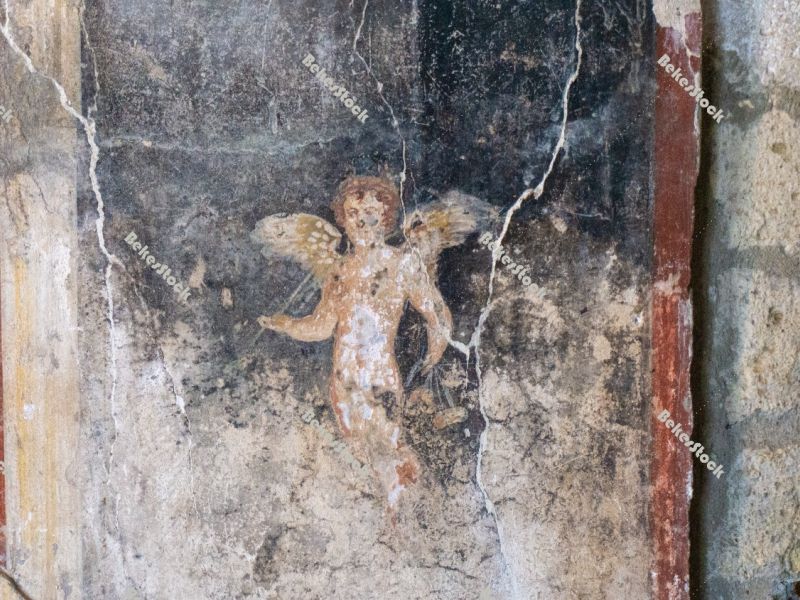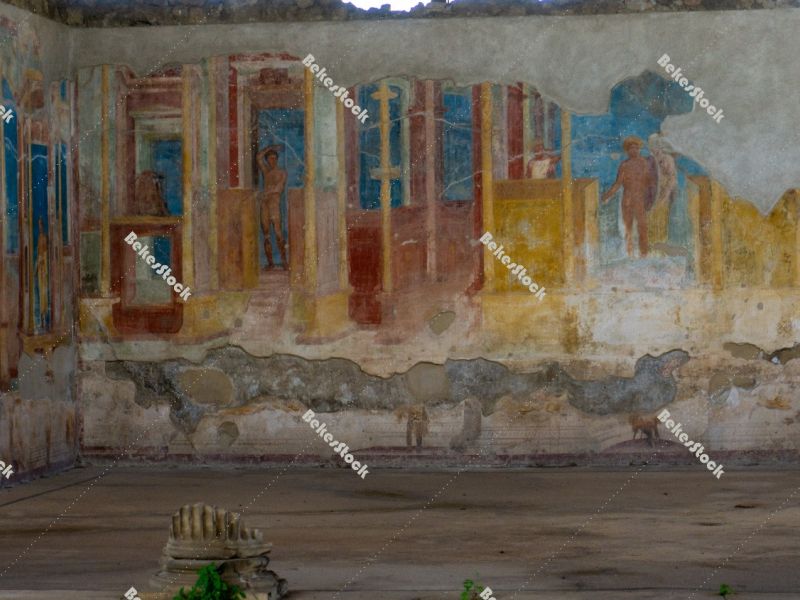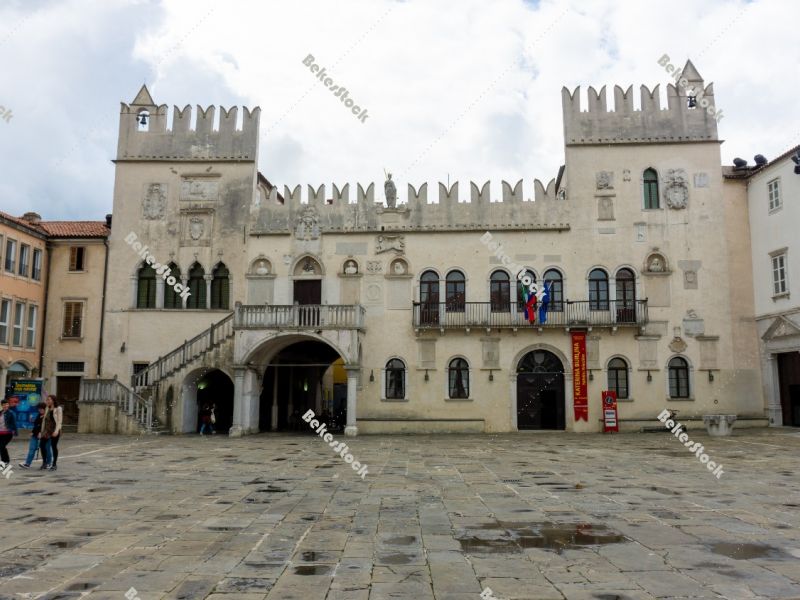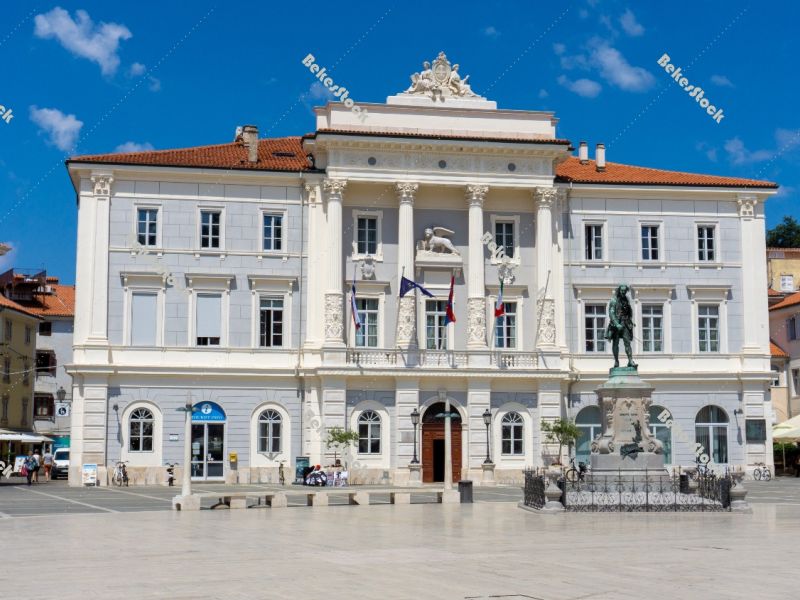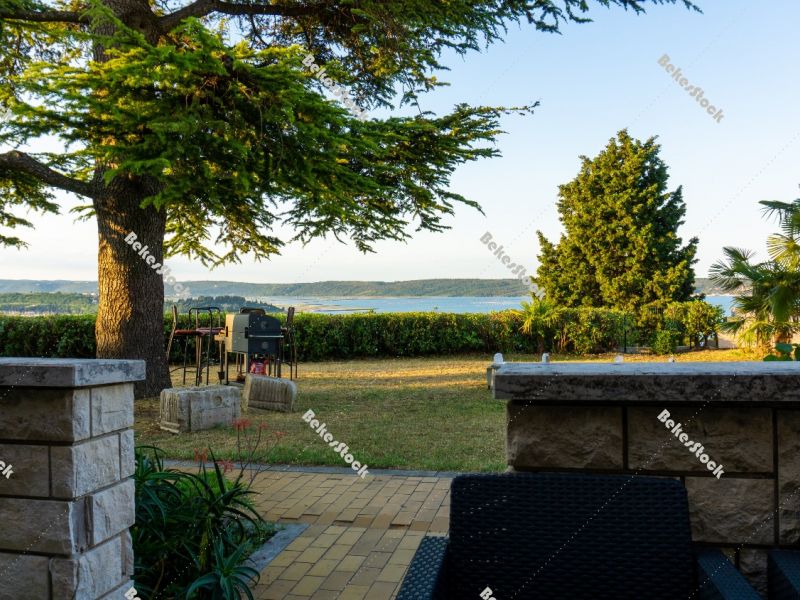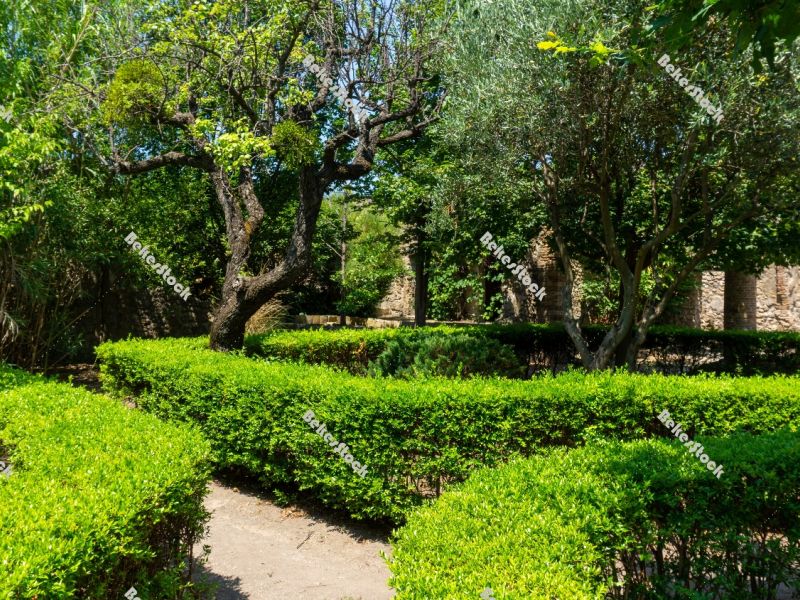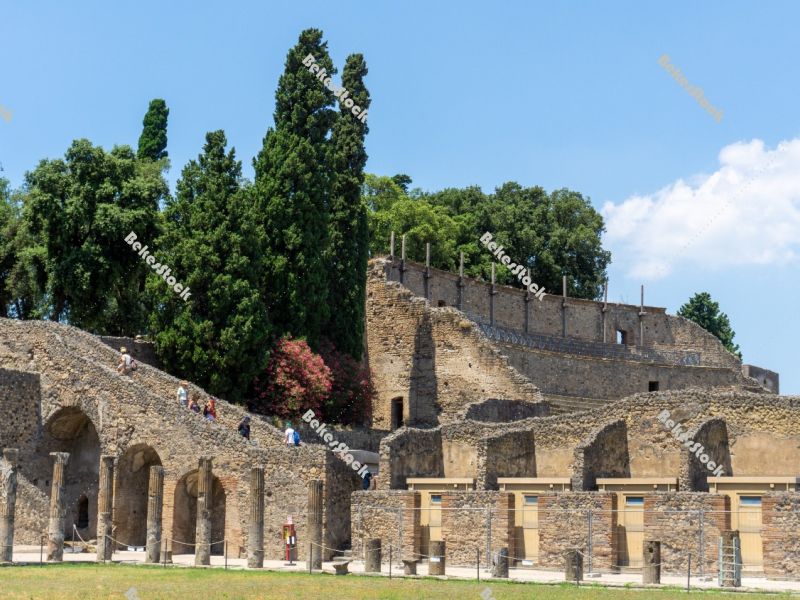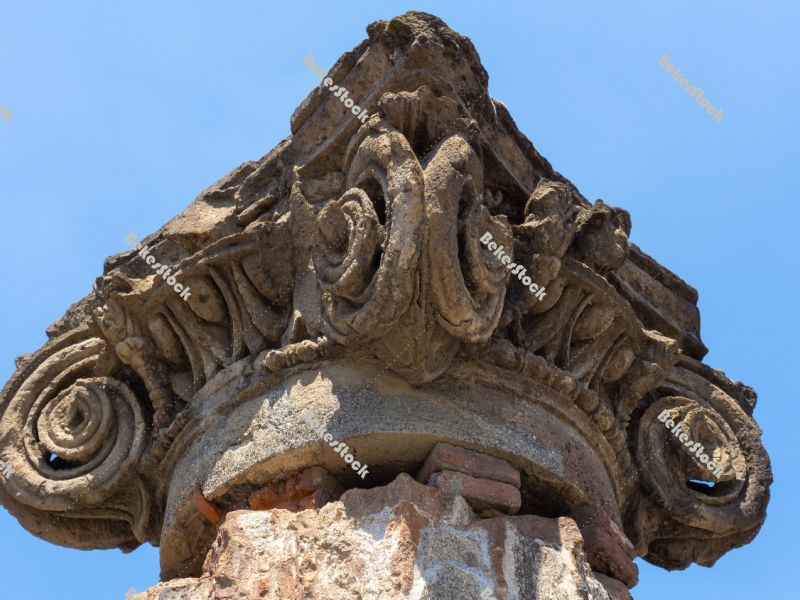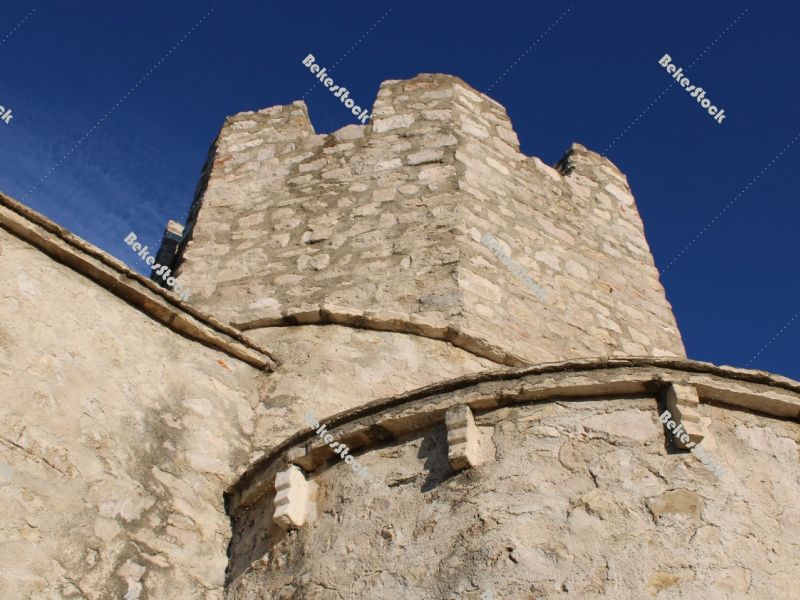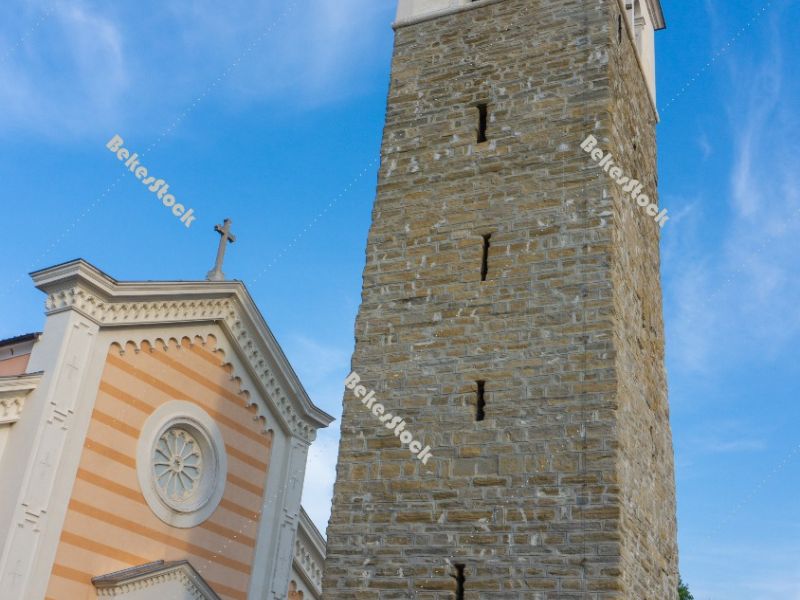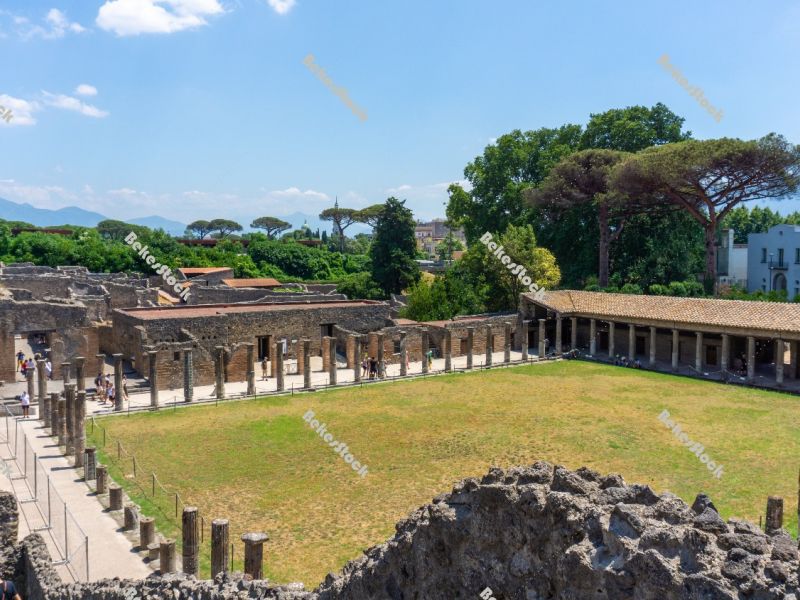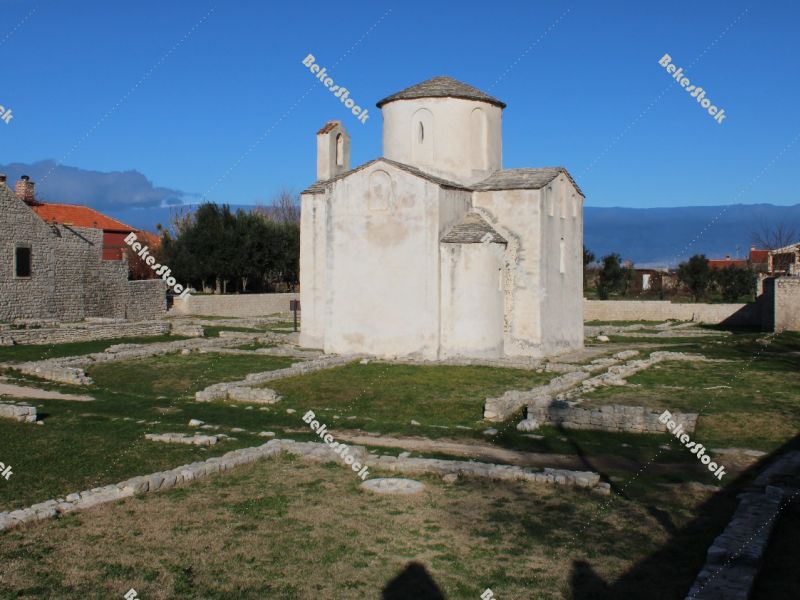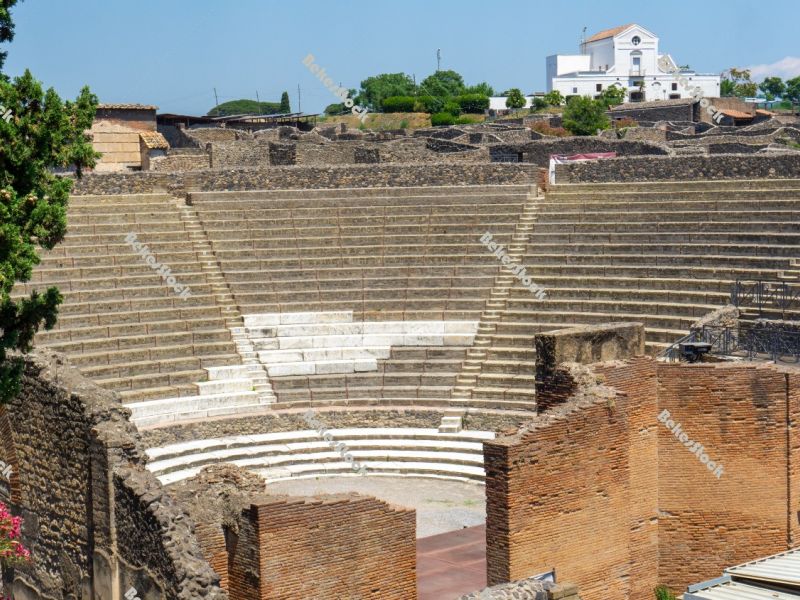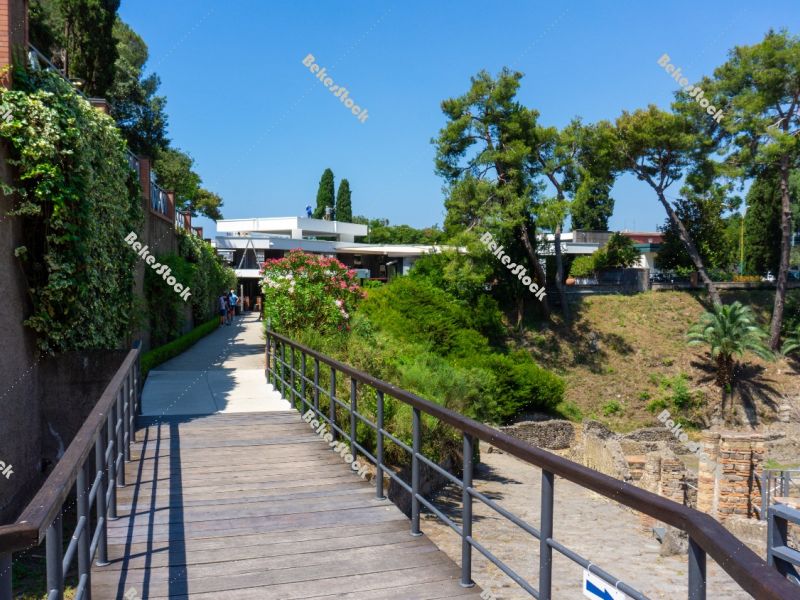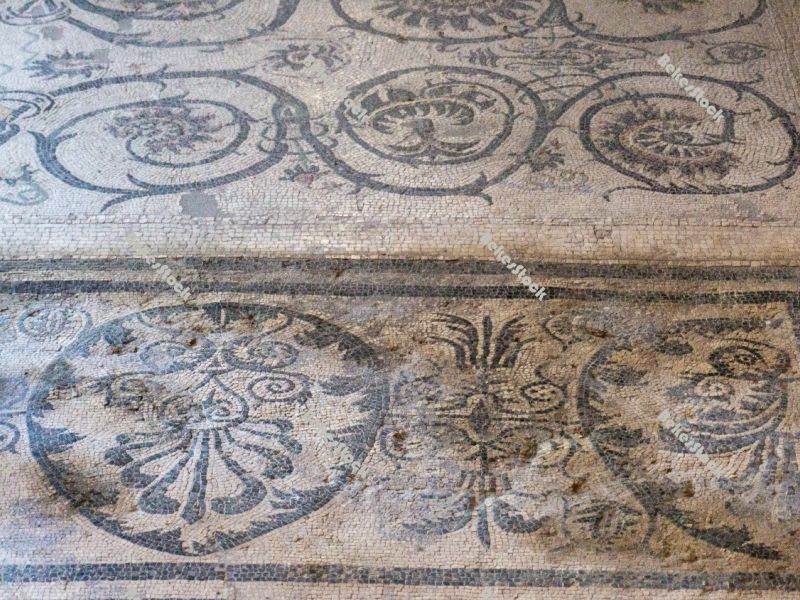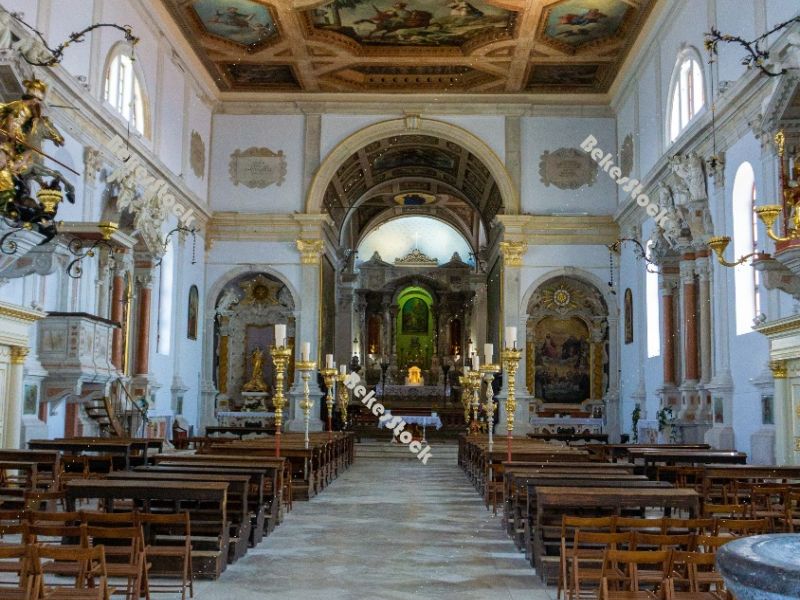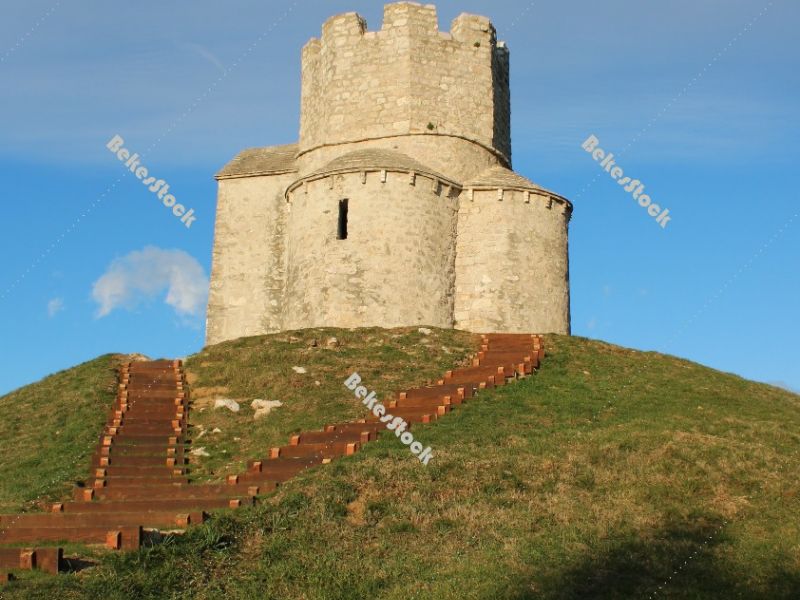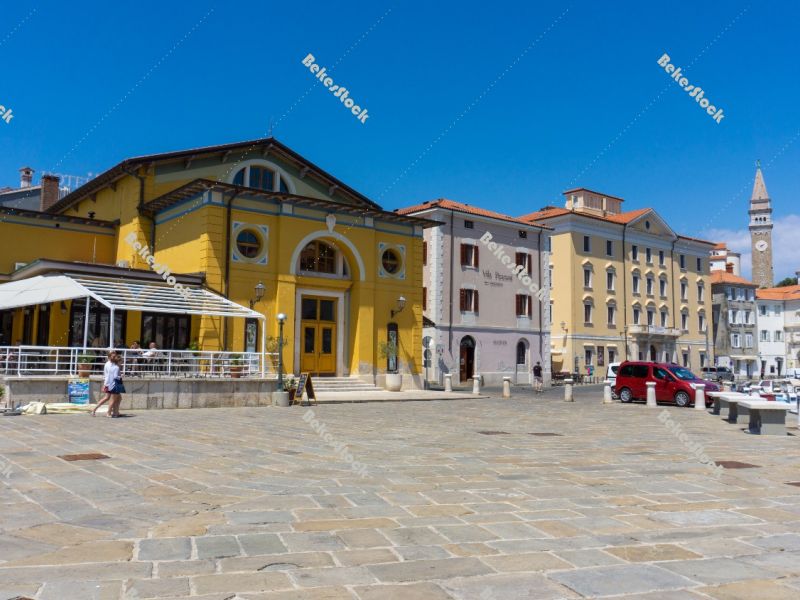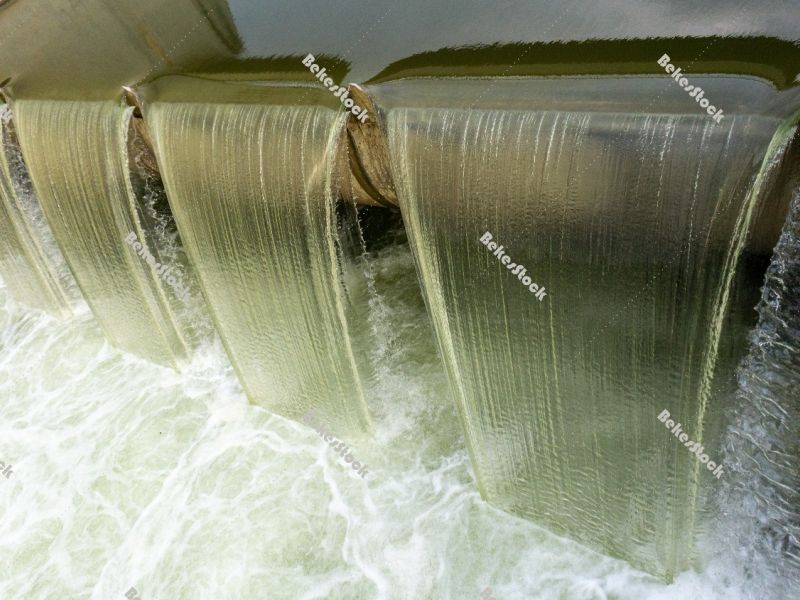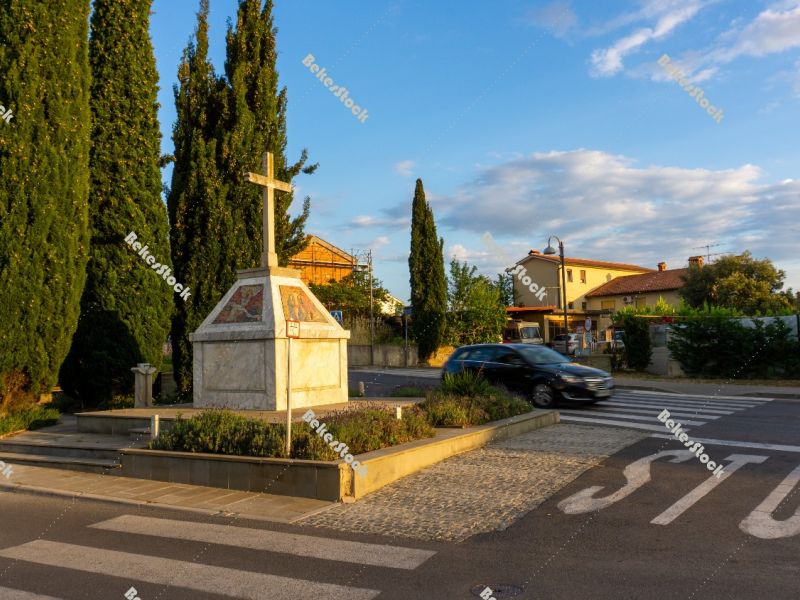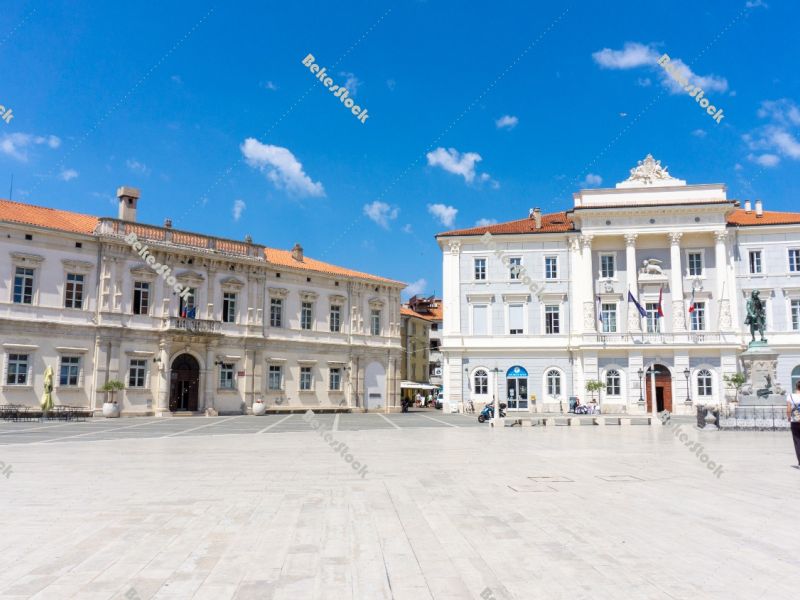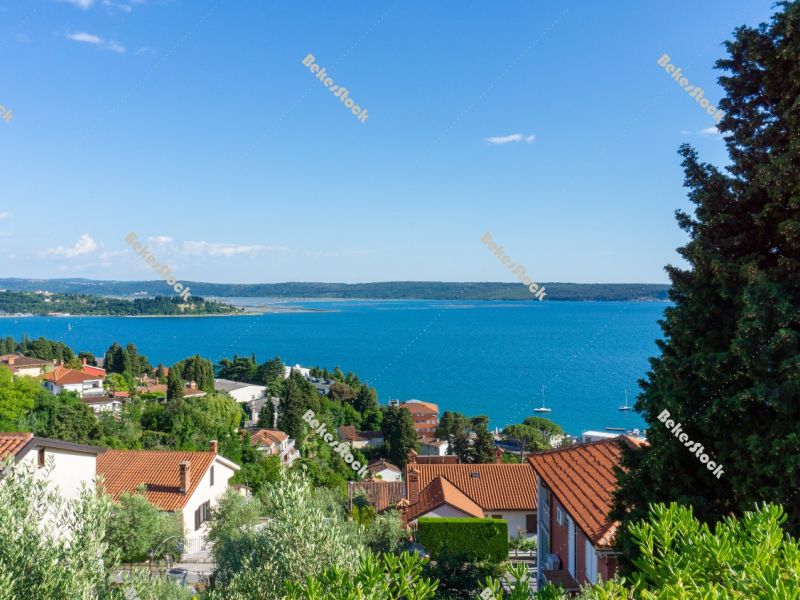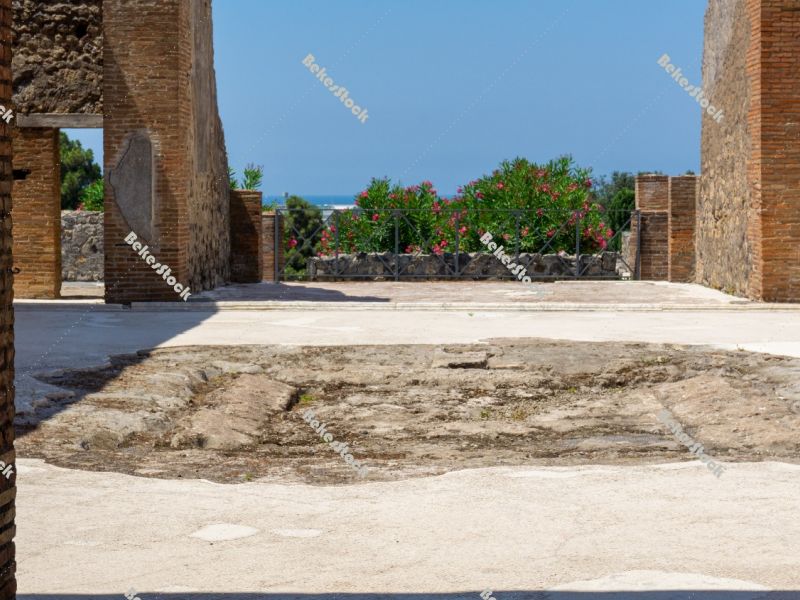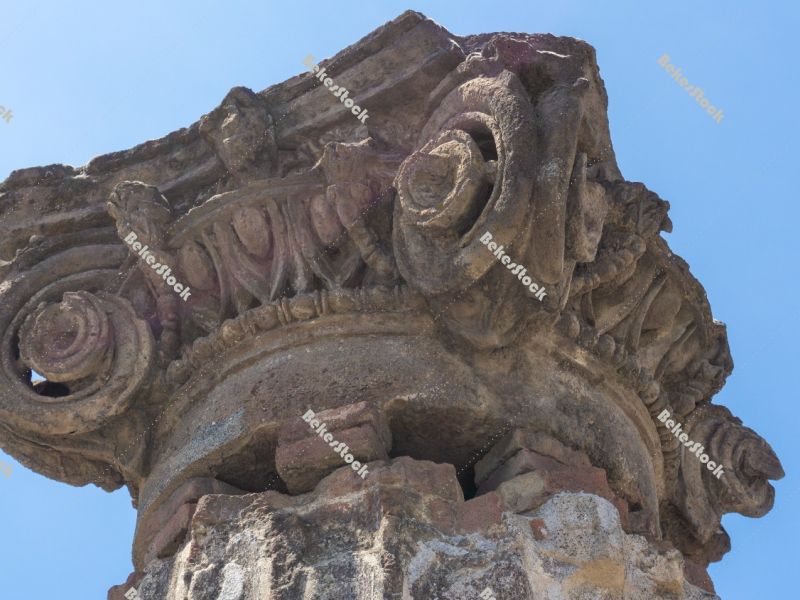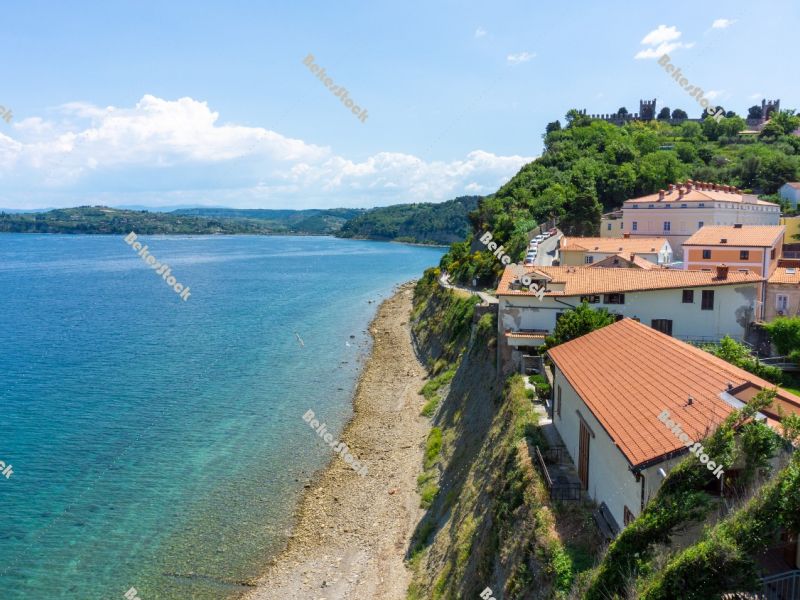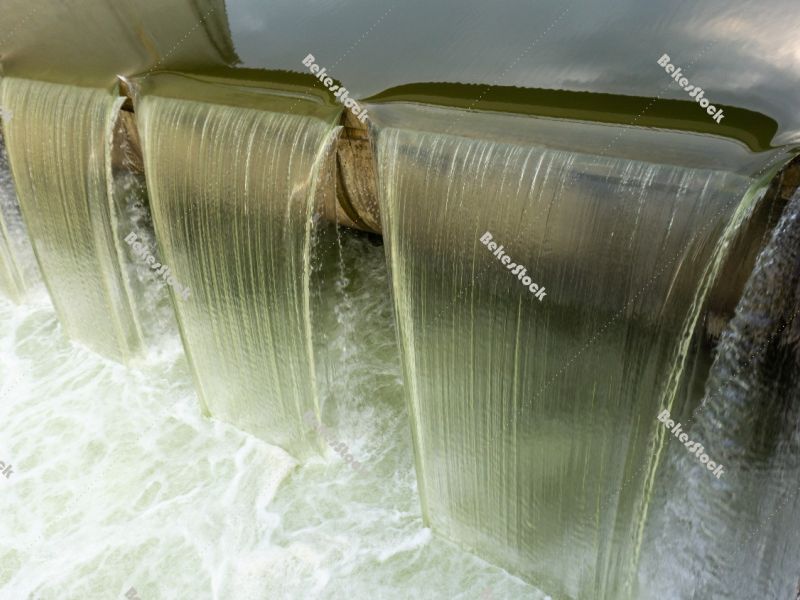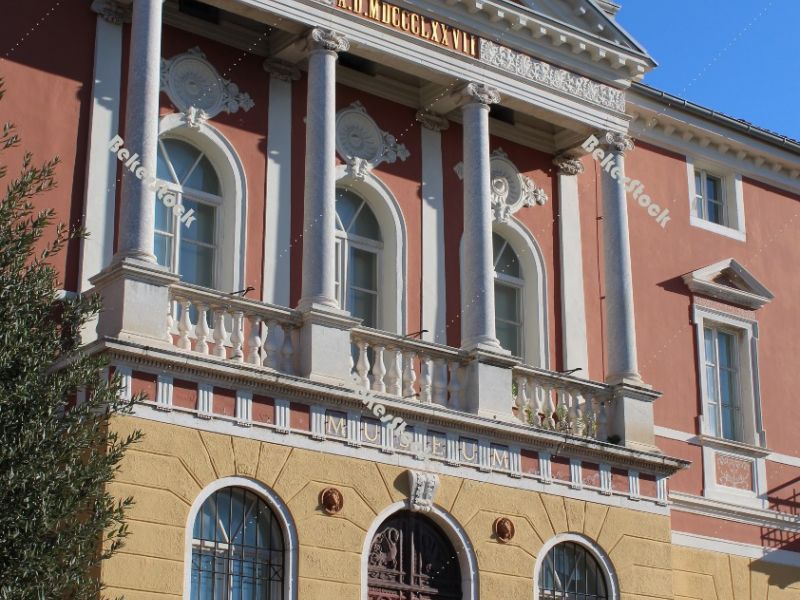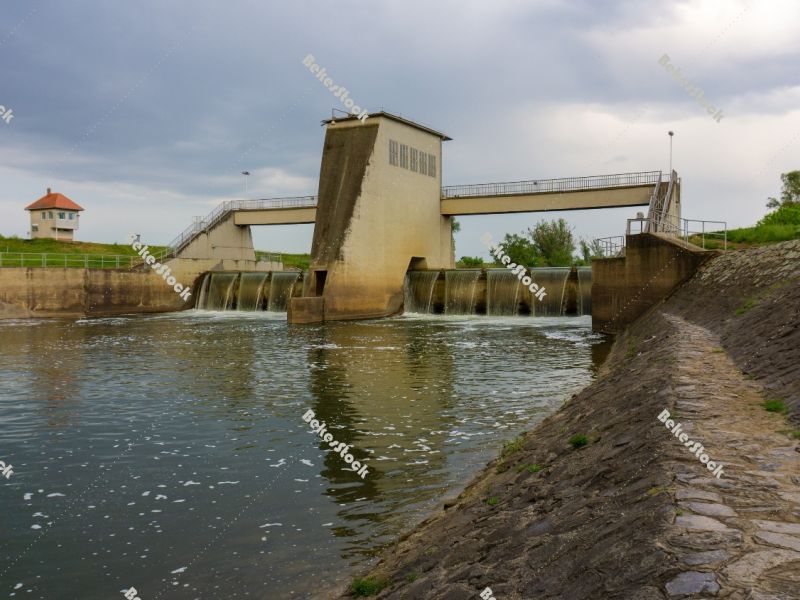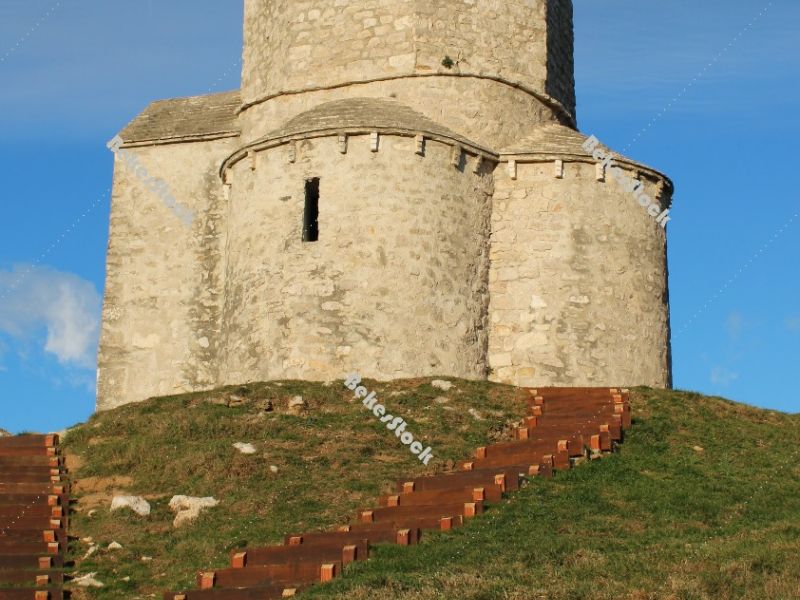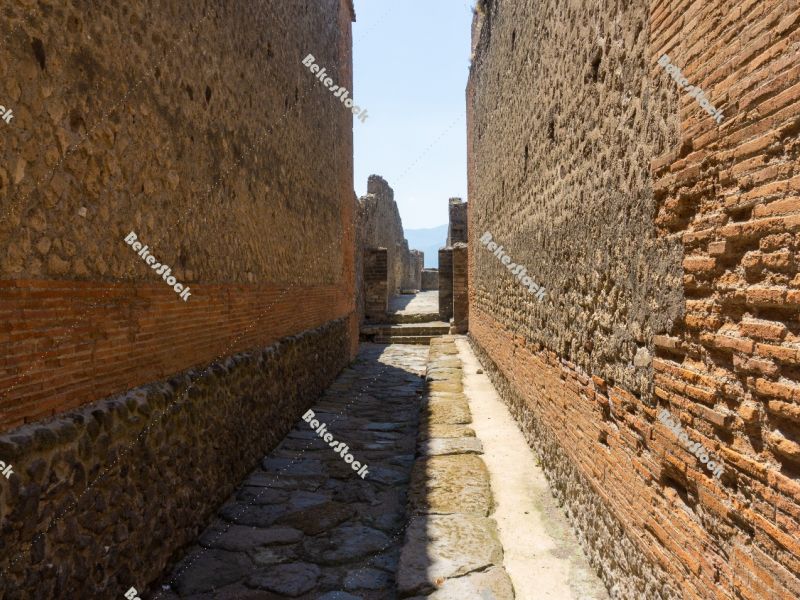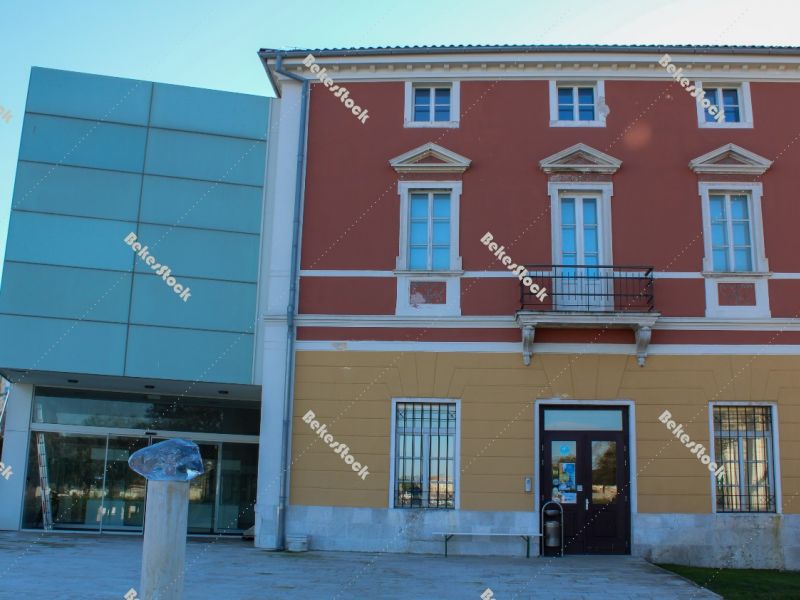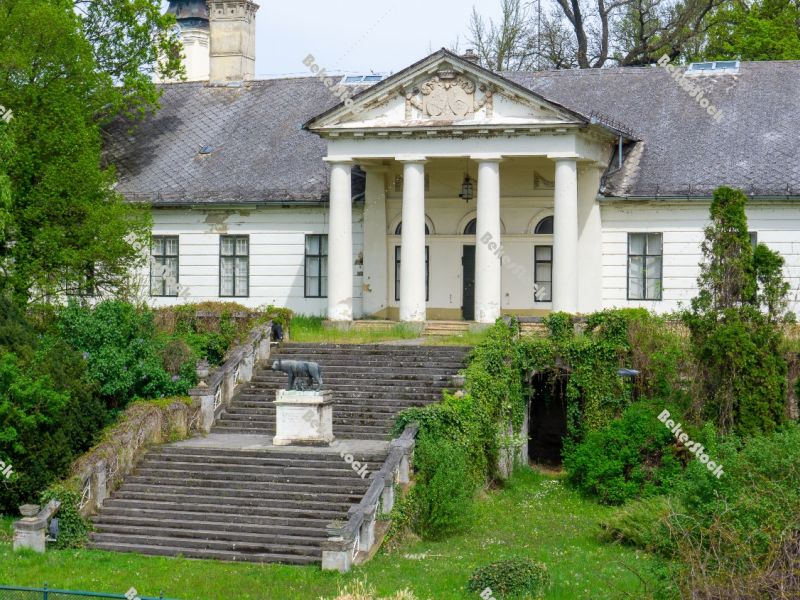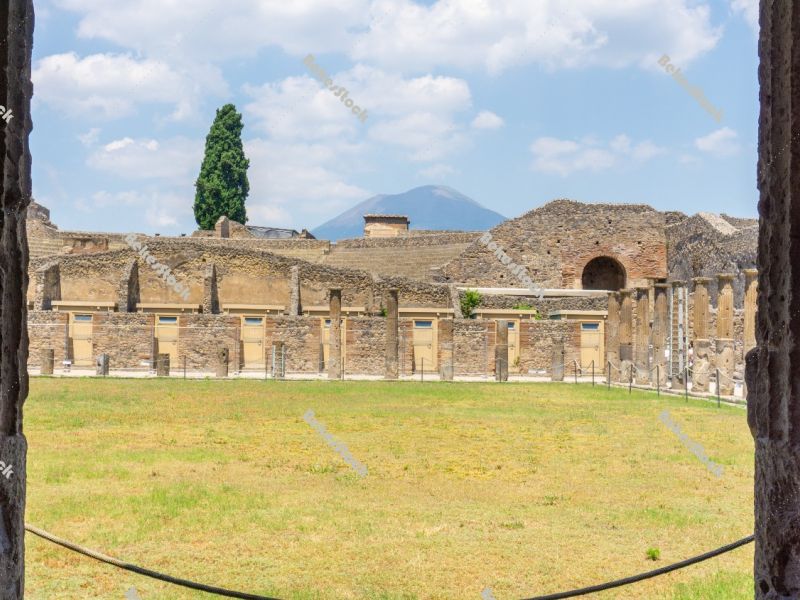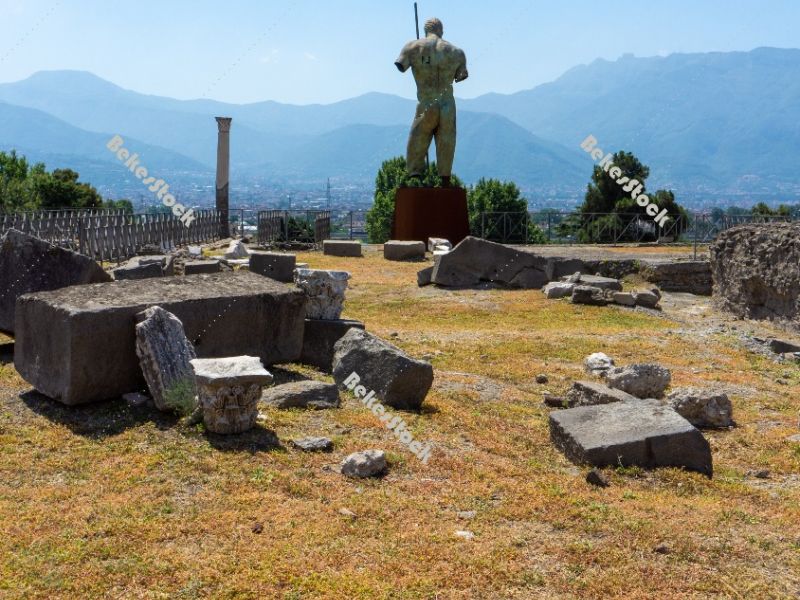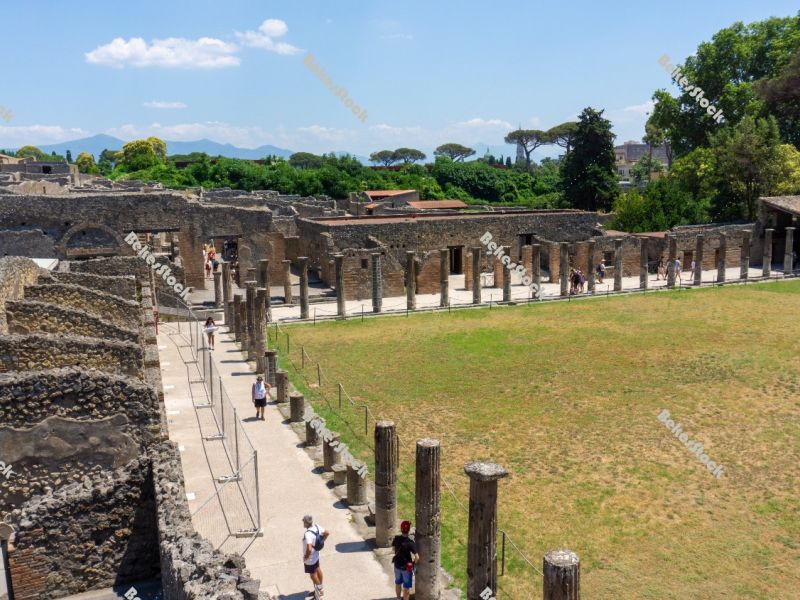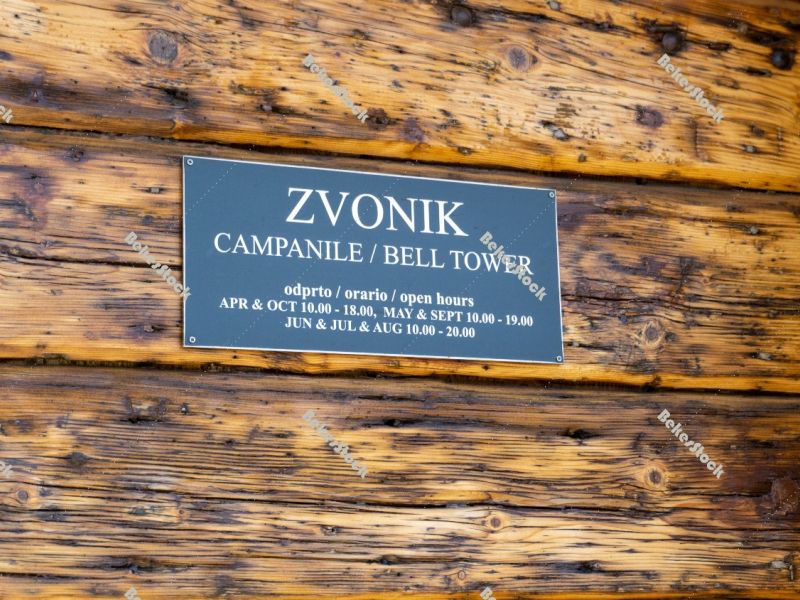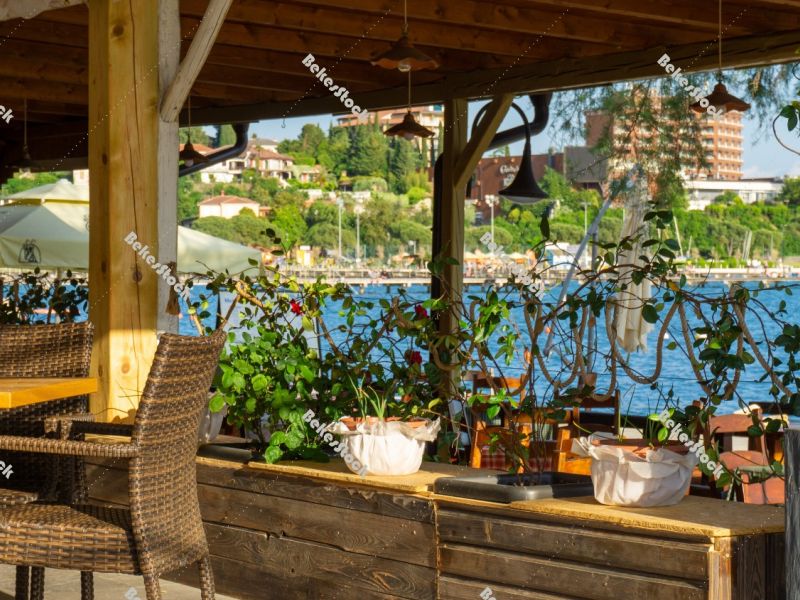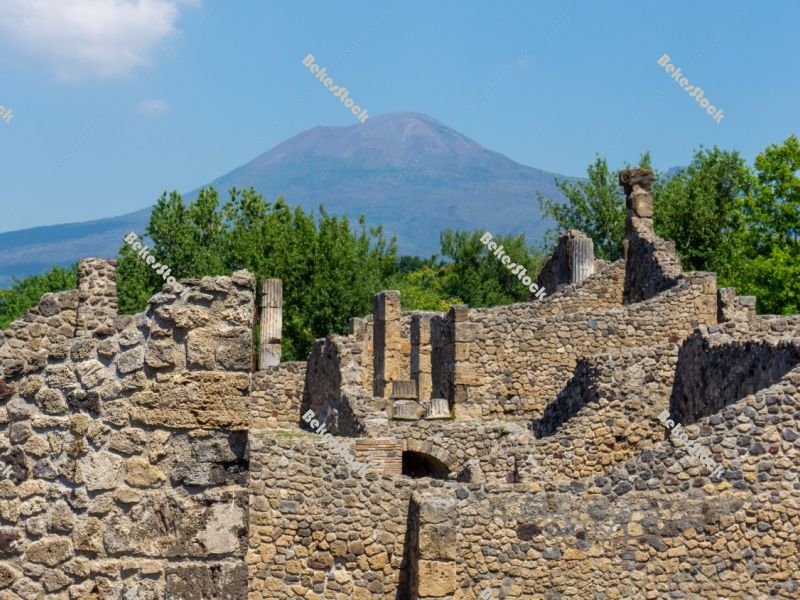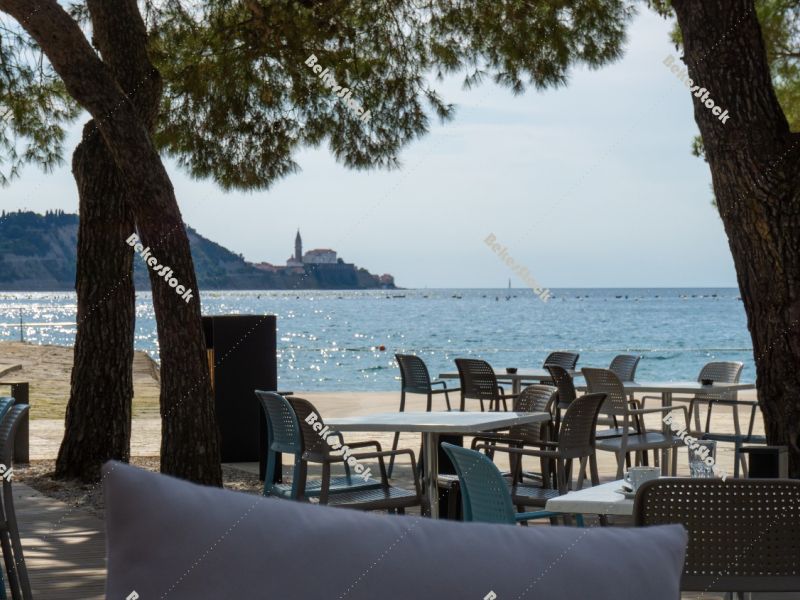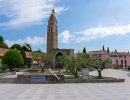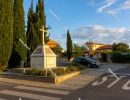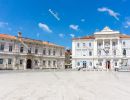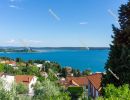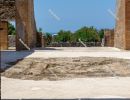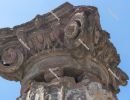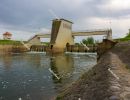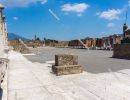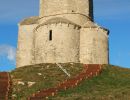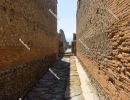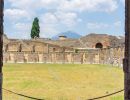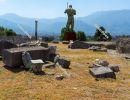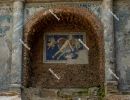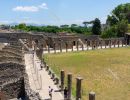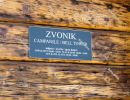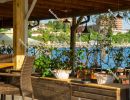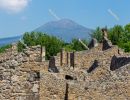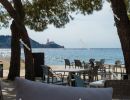Image Tags - century
-
Ancient tavern (Thermopolium) in Pompeii. Pompei, Campania, Ital Ancient tavern (Thermopolium) in Pompeii. Pompei, Campania, Ital
Ancient tavern (Thermopolium) in Pompeii. Table, ovens, kitchen with old food serving counter. Distinctive masonry counter in the interior of ruined Roman shop. Pompeii was an ancient city located in what is now the comune of Pompei near Naples in the Campania region of Italy. Pompeii, along with Herculaneum and many villas in the surrounding area, was buried under 4 to 6 m of volcanic ash and pumice in the eruption of Mount Vesuvius in AD 79 (1st century). Pompei, Campania, Italy, July 2020. @csabaprog
csabaprog decay city tourist architectural tavern sightseeing italian empire naples paved houses building vesuvius old landmark excavation vacation town eruption rome historical disaster oven 1st house history archaeology kitchen ancient catastrophe destroyed table volcano roman journey trip vesuvio ovens ruined scenary mount overlooked died architecture century mediterranean europe napoli demolished historic excursion romanesque famous buried remains interior beautiful travel ash ruins stone unesco thermopolium food tourism vesuvious archeological italyAncient tavern (Thermopolium) in Pompeii. Table, ovens, kitchen with old food serving counter. Distinctive masonry counter in the interior of ruined Roman shop. Pompeii was an ancient city located in what is now the comune of Pompei near Naples in the Campania region of Italy. Pompeii, along with Herculaneum and many villas in the surrounding area, was buried under 4 to 6 m of volcanic ash and pumice in the eruption of Mount Vesuvius in AD 79 (1st century). Pompei, Campania, Italy, July 2020. @csabaprog
csabaprog decay city tourist architectural tavern sightseeing italian empire naples paved houses building vesuvius old landmark excavation vacation town eruption rome historical disaster oven 1st house history archaeology kitchen ancient catastrophe destroyed table volcano roman journey trip vesuvio ovens ruined scenary mount overlooked died architecture century mediterranean europe napoli demolished historic excursion romanesque famous buried remains interior beautiful travel ash ruins stone unesco thermopolium food tourism vesuvious archeological italy -
Cloister - QUADRIPORTICUS OF THE THEATRES OR GLADIATORS BARRACKS Cloister - QUADRIPORTICUS OF THE THEATRES OR GLADIATORS BARRACKS
Cloister - QUADRIPORTICUS OF THE THEATRES OR GLADIATORS BARRACKS in Pompeii. Behind the scene of the Large Theatre there is a large quadrangle surrounded by 74 Doric grey tuff columns of Nocera used as a foyer, an area where the spectators could stop during the intervals of the theatre shows. After the earthquake of 62 AD the building changed its function and became a barracks for gladiators, which resulted in certain parts of the building being reorganised. The most important rooms were those on the eastern side whereas the rooms upstairs may have been the apartments of the undertaker of the gladiators. Pompeii was an ancient city located in what is now the comune of Pompei near Naples in the Campania region of Italy. Pompeii, along with Herculaneum and many villas in the surrounding area, was buried under 4 to 6 m of volcanic ash and pumice in the eruption of Mount Vesuvius in AD 79 (1st century). Pompei, Naples (Napoli), Campania, Italy, July 2020. @csabaprog
ornament csabaprog decay gladiator city tourist architectural door sightseeing italian empire naples paved barrack teatro houses building vesuvius old landmark excavation vacation town eruption rome historical disaster ruins 1st house history archaeology ancient catastrophe destroyed volcano theatre doric roman journey trip vesuvio column tall ruined scenary mount died century mediterranean vesuvious architecture europe napoli romanesque famous buried unesco excursion beautiful travel remains ash overlooked stone colorful historic tourism demolished archeological italyCloister - QUADRIPORTICUS OF THE THEATRES OR GLADIATORS BARRACKS in Pompeii. Behind the scene of the Large Theatre there is a large quadrangle surrounded by 74 Doric grey tuff columns of Nocera used as a foyer, an area where the spectators could stop during the intervals of the theatre shows. After the earthquake of 62 AD the building changed its function and became a barracks for gladiators, which resulted in certain parts of the building being reorganised. The most important rooms were those on the eastern side whereas the rooms upstairs may have been the apartments of the undertaker of the gladiators. Pompeii was an ancient city located in what is now the comune of Pompei near Naples in the Campania region of Italy. Pompeii, along with Herculaneum and many villas in the surrounding area, was buried under 4 to 6 m of volcanic ash and pumice in the eruption of Mount Vesuvius in AD 79 (1st century). Pompei, Naples (Napoli), Campania, Italy, July 2020. @csabaprog
ornament csabaprog decay gladiator city tourist architectural door sightseeing italian empire naples paved barrack teatro houses building vesuvius old landmark excavation vacation town eruption rome historical disaster ruins 1st house history archaeology ancient catastrophe destroyed volcano theatre doric roman journey trip vesuvio column tall ruined scenary mount died century mediterranean vesuvious architecture europe napoli romanesque famous buried unesco excursion beautiful travel remains ash overlooked stone colorful historic tourism demolished archeological italy -
Bell Tower, `Zvonik Campanile`, Portoroz, Piran, Obalno-kraska, Bell Tower, `Zvonik Campanile`, Portoroz, Piran, Obalno-kraska,
Bell Tower, `Zvonik Campanile`, tower of St. George's Cathedral, `Župnijska cerkev sv. Jurija`. St George's Cathedral, overlooking Piran from the hill above the town centre and offering a view over three countries, is the largest church building in town. Portoroz, Piran, Obalno-kraska, Slovenia, June 2020. @csabaprog
jurija presbytary church nature balkan 2020 bell obalno-kraska portorose adriatic june touristic christianity monastery 14th sky istria wall europe faith attraction building adria csabaprog cerkev adriatic sea cathedral george pirano largest century mediterranean outdoor vacation portoroz roses sunny summer exterior blue george`s st slovenia travel tower house town zupnijska religious sv tourism faithful piranBell Tower, `Zvonik Campanile`, tower of St. George's Cathedral, `Župnijska cerkev sv. Jurija`. St George's Cathedral, overlooking Piran from the hill above the town centre and offering a view over three countries, is the largest church building in town. Portoroz, Piran, Obalno-kraska, Slovenia, June 2020. @csabaprog
jurija presbytary church nature balkan 2020 bell obalno-kraska portorose adriatic june touristic christianity monastery 14th sky istria wall europe faith attraction building adria csabaprog cerkev adriatic sea cathedral george pirano largest century mediterranean outdoor vacation portoroz roses sunny summer exterior blue george`s st slovenia travel tower house town zupnijska religious sv tourism faithful piran -
The Church of the Holy Cross - Nin The Church of the Holy Cross - Nin
The Church of the Holy Cross dating from the 9th century - Nin Town, Croatia, December 2019. @csabaprog
croatia horvatorszag 11th 9th adria architecture attraction background beautiful blue building castle century church clouds crkva crkvasvkriza cross culture dalmatia dating december europe gathering historic historical holy kings kriza monument nin old outdoor power royalpower seven sightseeing sky stone svetog tourism tower town travel view winter csabaprogThe Church of the Holy Cross dating from the 9th century - Nin Town, Croatia, December 2019. @csabaprog
croatia horvatorszag 11th 9th adria architecture attraction background beautiful blue building castle century church clouds crkva crkvasvkriza cross culture dalmatia dating december europe gathering historic historical holy kings kriza monument nin old outdoor power royalpower seven sightseeing sky stone svetog tourism tower town travel view winter csabaprog -
View from the terrace of Vila Toni at sunset, Portoroz, Piran, O View from the terrace of Vila Toni at sunset, Portoroz, Piran, O
View from the terrace of Vila Toni at sunset. In the distance 'The Piran Salt Pans'. Portorož, Italian: Portorose, literally "Port of Roses" is a Slovenian Adriatic seaside resort and spa town located in the Municipality of Piran in southwestern Slovenia. Its modern development began in the late 19th century with the vogue for the first health resorts. Portoroz, Piran, Obalno-kraska, Slovenia, June 2020.
View from the terrace of Vila Toni at sunset. In the distance 'The Piran Salt Pans'. Portorož, Italian: Portorose, literally "Port of Roses" is a Slovenian Adriatic seaside resort and spa town located in the Municipality of Piran in southwestern Slovenia. Its modern development began in the late 19th century with the vogue for the first health resorts. Portoroz, Piran, Obalno-kraska, Slovenia, June 2020.
-
SMALL THEATRE – ODEON in Pompeii. Pompei, Campania, Italy, Jul SMALL THEATRE – ODEON in Pompeii. Pompei, Campania, Italy, Jul
SMALL THEATRE – ODEON in Pompeii. The Odeon or theatrum tectum as it was called by the Romans, was built during the early years of the colony (79 BC), as evidenced by an inscription, as requested by two local magistrates, Marcus Porcius and Caius Quinctius Valgus who also requested the construction of the amphitheatre. This building was dedicated to the representation of the most popular theatrical genre at the time, miming, and could also be used for musical and singing performances. Pompeii was an ancient city located in what is now the comune of Pompei near Naples in the Campania region of Italy. Pompeii, along with Herculaneum and many villas in the surrounding area, was buried under 4 to 6 m of volcanic ash and pumice in the eruption of Mount Vesuvius in AD 79 (1st century). Pompei, Naples (Napoli), Campania, Italy, July 2020. @csabaprog
ornament csabaprog decay gladiator city tourist architectural door sightseeing italian empire naples paved barrack teatro houses building vesuvius old landmark excavation vacation town eruption rome historical disaster ruins 1st house history archaeology ancient catastrophe historic volcano theatre doric roman journey trip vesuvio column tall ruined scenary mount theater died architecture century mediterranean europe overlooked ash stone unesco romanesque famous buried colorful excursion beautiful travel napoli theatrum tectum remains odeon demolished destroyed tourism vesuvious archeological italySMALL THEATRE – ODEON in Pompeii. The Odeon or theatrum tectum as it was called by the Romans, was built during the early years of the colony (79 BC), as evidenced by an inscription, as requested by two local magistrates, Marcus Porcius and Caius Quinctius Valgus who also requested the construction of the amphitheatre. This building was dedicated to the representation of the most popular theatrical genre at the time, miming, and could also be used for musical and singing performances. Pompeii was an ancient city located in what is now the comune of Pompei near Naples in the Campania region of Italy. Pompeii, along with Herculaneum and many villas in the surrounding area, was buried under 4 to 6 m of volcanic ash and pumice in the eruption of Mount Vesuvius in AD 79 (1st century). Pompei, Naples (Napoli), Campania, Italy, July 2020. @csabaprog
ornament csabaprog decay gladiator city tourist architectural door sightseeing italian empire naples paved barrack teatro houses building vesuvius old landmark excavation vacation town eruption rome historical disaster ruins 1st house history archaeology ancient catastrophe historic volcano theatre doric roman journey trip vesuvio column tall ruined scenary mount theater died architecture century mediterranean europe overlooked ash stone unesco romanesque famous buried colorful excursion beautiful travel napoli theatrum tectum remains odeon demolished destroyed tourism vesuvious archeological italy -
Glass fish - Museum of Ancient Glass, Zadar, Croatia, December 2019 Glass fish - Museum of Ancient Glass, Zadar, Croatia, December 2019
Glass fish - Museum of Ancient Glass, Zadar, Croatia, December 2019. Glass fish - Museum of Ancient Glass (Muzej antičkog stakla u Zadru). Housed in a restored 19th-century palace, the Museum of Ancient Glass (which faces the Jazine harbor, filled with expensive yachts) is home to one of the world's best collections of ancient Roman glass.
Glass fish - Museum of Ancient Glass, Zadar, Croatia, December 2019. Glass fish - Museum of Ancient Glass (Muzej antičkog stakla u Zadru). Housed in a restored 19th-century palace, the Museum of Ancient Glass (which faces the Jazine harbor, filled with expensive yachts) is home to one of the world's best collections of ancient Roman glass.
-
View of Piran Old Town from the tower of St. George's Cathedral, View of Piran Old Town from the tower of St. George's Cathedral,
View of Piran Old Town from the tower of St. George's Cathedral, `Župnijska cerkev sv. Jurija`. The photo shows the old town, the city wall, as well as the steep coast and the Adriatic Sea. Portoroz, Piran, Obalno-kraska, Slovenia, June 2020. @csabaprog
attraction sunny presbytary csabaprog europe church nature coast balkan city green team jurija bell obalno-kraska painting portorose summer beach sv touristic st istria house roof piran cloud wall steep 14th building old adria roses cerkev adriatic sea cathedral george pirano largest century mediterranean outdoor vacation blue town sea portoroz exterior slovenia george`s zupnijska sky travel tower top monastery adriatic fog june tourism 2020 treeView of Piran Old Town from the tower of St. George's Cathedral, `Župnijska cerkev sv. Jurija`. The photo shows the old town, the city wall, as well as the steep coast and the Adriatic Sea. Portoroz, Piran, Obalno-kraska, Slovenia, June 2020. @csabaprog
attraction sunny presbytary csabaprog europe church nature coast balkan city green team jurija bell obalno-kraska painting portorose summer beach sv touristic st istria house roof piran cloud wall steep 14th building old adria roses cerkev adriatic sea cathedral george pirano largest century mediterranean outdoor vacation blue town sea portoroz exterior slovenia george`s zupnijska sky travel tower top monastery adriatic fog june tourism 2020 tree -
GYMNASIUM OF THE IUVENES. The entrance of the Gymnasium is locat GYMNASIUM OF THE IUVENES. The entrance of the Gymnasium is locat
GYMNASIUM OF THE IUVENES (`PALESTRA DEGLI IUVENES`). The entrance of the Gymnasium is located in Vicolo della Regina. On the walls, the frescos portray athletes, wrestlers, a jumper with dumbbells, and the competition judge, known as the Ludi Magister, carrying a sash for the winner. This huge space was part of a thermal bath for men that dates back to the 1 st century A.D. and was located in a scenic area of the town with wonderful sea view. Pompeii was an ancient city located in what is now the comune of Pompei near Naples in the Campania region of Italy. Pompeii, along with Herculaneum and many villas in the surrounding area, was buried under 4 to 6 m of volcanic ash and pumice in the eruption of Mount Vesuvius in AD 79 (1st century). Pompei, Campania, Italy, July 2020. @csabaprog
csabaprog decay gods city tourist architectural sightseeing italian empire ash paved houses building vesuvius old landmark excavation villa vacation town eruption rome historical disaster ruins 1st house history archaeology demolished athletes historic bella volcano wrestlers roman destroyed journey misteri gymnasium vesuvio vesuvious europe vicolo ruined stone walls architecture scenary mount mysteries iuvenes died naples overlooked mediterranean catastrophe century ancient interior remains romanesque famous buried colorful excursion beautiful travel unesco decorated decoration symbol fresco trip tourism napoli archeological italyGYMNASIUM OF THE IUVENES (`PALESTRA DEGLI IUVENES`). The entrance of the Gymnasium is located in Vicolo della Regina. On the walls, the frescos portray athletes, wrestlers, a jumper with dumbbells, and the competition judge, known as the Ludi Magister, carrying a sash for the winner. This huge space was part of a thermal bath for men that dates back to the 1 st century A.D. and was located in a scenic area of the town with wonderful sea view. Pompeii was an ancient city located in what is now the comune of Pompei near Naples in the Campania region of Italy. Pompeii, along with Herculaneum and many villas in the surrounding area, was buried under 4 to 6 m of volcanic ash and pumice in the eruption of Mount Vesuvius in AD 79 (1st century). Pompei, Campania, Italy, July 2020. @csabaprog
csabaprog decay gods city tourist architectural sightseeing italian empire ash paved houses building vesuvius old landmark excavation villa vacation town eruption rome historical disaster ruins 1st house history archaeology demolished athletes historic bella volcano wrestlers roman destroyed journey misteri gymnasium vesuvio vesuvious europe vicolo ruined stone walls architecture scenary mount mysteries iuvenes died naples overlooked mediterranean catastrophe century ancient interior remains romanesque famous buried colorful excursion beautiful travel unesco decorated decoration symbol fresco trip tourism napoli archeological italy -
Museum of Ancient Glass (Muzej antičkog stakla u Zadru), Zadar, Museum of Ancient Glass (Muzej antičkog stakla u Zadru), Zadar,
Museum of Ancient Glass (Muzej antičkog stakla u Zadru). Housed in a restored 19th-century palace, the Museum of Ancient Glass (which faces the Jazine harbor, filled with expensive yachts) is home to one of the world's best collections of ancient Roman glass.
Museum of Ancient Glass (Muzej antičkog stakla u Zadru). Housed in a restored 19th-century palace, the Museum of Ancient Glass (which faces the Jazine harbor, filled with expensive yachts) is home to one of the world's best collections of ancient Roman glass.
-
View from the terrace of Vila Toni at sunset, Portoroz, Piran, O View from the terrace of Vila Toni at sunset, Portoroz, Piran, O
View from the terrace of Vila Toni at sunset. Portorož, Italian: Portorose, literally "Port of Roses" is a Slovenian Adriatic seaside resort and spa town located in the Municipality of Piran in southwestern Slovenia. Its modern development began in the late 19th century with the vogue for the first health resorts. Portoroz, Piran, Obalno-kraska, Slovenia, June 2020.
View from the terrace of Vila Toni at sunset. Portorož, Italian: Portorose, literally "Port of Roses" is a Slovenian Adriatic seaside resort and spa town located in the Municipality of Piran in southwestern Slovenia. Its modern development began in the late 19th century with the vogue for the first health resorts. Portoroz, Piran, Obalno-kraska, Slovenia, June 2020.
-
Grain silo on the Kettos-Koros river in Bekes - tarhaz, storehou Grain silo on the Kettos-Koros river in Bekes - tarhaz, storehou
Grain silo on the Kettos-Koros river in Bekes - tarhaz, storehouse, garner. The picture shows the dam with grass and wildflowers. In the last century, grain was carried on a ship here. - Bekes, Bekes county, Hungary, May 2020
grass spring green background kettos-koros nature tarhaz grain dike dam dyke ship industrial building silo storehouse digue may county building koros river flower bekes wild garner riverside grain silo meadows flowers last century landscape hungarian industrial heritage hungary river cloud house fields koros folyo folyo bloom rampart bekes county perineum békésmegye békésváros magyarországGrain silo on the Kettos-Koros river in Bekes - tarhaz, storehouse, garner. The picture shows the dam with grass and wildflowers. In the last century, grain was carried on a ship here. - Bekes, Bekes county, Hungary, May 2020
grass spring green background kettos-koros nature tarhaz grain dike dam dyke ship industrial building silo storehouse digue may county building koros river flower bekes wild garner riverside grain silo meadows flowers last century landscape hungarian industrial heritage hungary river cloud house fields koros folyo folyo bloom rampart bekes county perineum békésmegye békésváros magyarország -
View from the mountain to the Adriatic Sea, Portoroz, Piran, Oba View from the mountain to the Adriatic Sea, Portoroz, Piran, Oba
View from the mountain to the Adriatic Sea. In the foreground of the picture is the chimney of a white house. Portorož, Italian: Portorose, literally "Port of Roses" is a Slovenian Adriatic seaside resort and spa town located in the Municipality of Piran in southwestern Slovenia. Its modern development began in the late 19th century with the vogue for the first health resorts. Across the bay is Croatia. Portoroz, Piran, Obalno-kraska, Slovenia, June 2020.
View from the mountain to the Adriatic Sea. In the foreground of the picture is the chimney of a white house. Portorož, Italian: Portorose, literally "Port of Roses" is a Slovenian Adriatic seaside resort and spa town located in the Municipality of Piran in southwestern Slovenia. Its modern development began in the late 19th century with the vogue for the first health resorts. Across the bay is Croatia. Portoroz, Piran, Obalno-kraska, Slovenia, June 2020.
-
Wall decoration, stucco in the Suburban Baths in Pompeii. Pompei Wall decoration, stucco in the Suburban Baths in Pompeii. Pompei
Wall decoration, stucco in the Suburban Baths in Pompeii. The Suburban Baths, located immediately beneath the Marina Gate. The Suburban Baths were private. The thermal areas have sumptuous decorations. Pompeii was an ancient city located in what is now the comune of Pompei near Naples in the Campania region of Italy. Pompeii, along with Herculaneum and many villas in the surrounding area, was buried under 4 to 6 m of volcanic ash and pumice in the eruption of Mount Vesuvius in AD 79 (1st century). Pompei, Campania, Italy, July 2020. @csabaprog
csabaprog decay gods city tourist architectural sightseeing italian empire ash paved vesuvious building vesuvius old landmark excavation villa vacation town eruption rome historical disaster ruins 1st house history archaeology demolished tessellation catastrophe destroyed bella volcano roman dei journey mysteries trip vesuvio wall historic ruined century europe scenary mount art napoli died symbol overlooked mediterranean naples architecture colorful excursion ancient romanesque famous buried unesco interior beautiful travel remains decorated decoration walls misteri stone tourism houses archeological italyWall decoration, stucco in the Suburban Baths in Pompeii. The Suburban Baths, located immediately beneath the Marina Gate. The Suburban Baths were private. The thermal areas have sumptuous decorations. Pompeii was an ancient city located in what is now the comune of Pompei near Naples in the Campania region of Italy. Pompeii, along with Herculaneum and many villas in the surrounding area, was buried under 4 to 6 m of volcanic ash and pumice in the eruption of Mount Vesuvius in AD 79 (1st century). Pompei, Campania, Italy, July 2020. @csabaprog
csabaprog decay gods city tourist architectural sightseeing italian empire ash paved vesuvious building vesuvius old landmark excavation villa vacation town eruption rome historical disaster ruins 1st house history archaeology demolished tessellation catastrophe destroyed bella volcano roman dei journey mysteries trip vesuvio wall historic ruined century europe scenary mount art napoli died symbol overlooked mediterranean naples architecture colorful excursion ancient romanesque famous buried unesco interior beautiful travel remains decorated decoration walls misteri stone tourism houses archeological italy -
Cloister - QUADRIPORTICUS OF THE THEATRES OR GLADIATORS BARRACKS Cloister - QUADRIPORTICUS OF THE THEATRES OR GLADIATORS BARRACKS
Cloister - QUADRIPORTICUS OF THE THEATRES OR GLADIATORS BARRACKS in Pompeii. A lady looks through a closed door. Behind the scene of the Large Theatre there is a large quadrangle surrounded by 74 Doric grey tuff columns of Nocera used as a foyer, an area where the spectators could stop during the intervals of the theatre shows. After the earthquake of 62 AD the building changed its function and became a barracks for gladiators, which resulted in certain parts of the building being reorganised. The most important rooms were those on the eastern side whereas the rooms upstairs may have been the apartments of the undertaker of the gladiators. Pompeii was an ancient city located in what is now the comune of Pompei near Naples in the Campania region of Italy. Pompeii, along with Herculaneum and many villas in the surrounding area, was buried under 4 to 6 m of volcanic ash and pumice in the eruption of Mount Vesuvius in AD 79 (1st century). Pompei, Naples (Napoli), Campania, Italy, July 2020. @csabaprog
ornament csabaprog decay gladiator city tourist lady architectural door sightseeing italian empire naples paved barrack teatro houses building vesuvius old landmark excavation vacation town eruption rome historical disaster ruins 1st house history archaeology ancient catastrophe historic volcano theatre doric roman looks journey trip vesuvio column tall ruined scenary mount died century mediterranean vesuvious architecture europe napoli unesco romanesque famous buried colorful excursion beautiful travel ash overlooked stone destroyed remains demolished tourism woman archeological italyCloister - QUADRIPORTICUS OF THE THEATRES OR GLADIATORS BARRACKS in Pompeii. A lady looks through a closed door. Behind the scene of the Large Theatre there is a large quadrangle surrounded by 74 Doric grey tuff columns of Nocera used as a foyer, an area where the spectators could stop during the intervals of the theatre shows. After the earthquake of 62 AD the building changed its function and became a barracks for gladiators, which resulted in certain parts of the building being reorganised. The most important rooms were those on the eastern side whereas the rooms upstairs may have been the apartments of the undertaker of the gladiators. Pompeii was an ancient city located in what is now the comune of Pompei near Naples in the Campania region of Italy. Pompeii, along with Herculaneum and many villas in the surrounding area, was buried under 4 to 6 m of volcanic ash and pumice in the eruption of Mount Vesuvius in AD 79 (1st century). Pompei, Naples (Napoli), Campania, Italy, July 2020. @csabaprog
ornament csabaprog decay gladiator city tourist lady architectural door sightseeing italian empire naples paved barrack teatro houses building vesuvius old landmark excavation vacation town eruption rome historical disaster ruins 1st house history archaeology ancient catastrophe historic volcano theatre doric roman looks journey trip vesuvio column tall ruined scenary mount died century mediterranean vesuvious architecture europe napoli unesco romanesque famous buried colorful excursion beautiful travel ash overlooked stone destroyed remains demolished tourism woman archeological italy -
Bronze statue of Daedalus (`Dedalo`) on the terrace of the Sanct Bronze statue of Daedalus (`Dedalo`) on the terrace of the Sanct
Bronze statue of Daedalus (`Dedalo`) on the terrace of the Sanctuary of Venus in Pompeii. Ancient ruins in the foreground, mountains and a blue sky in the background. Venus was the patron goddess of Pompeii, to whom the colony was named upon conclusion (80 BC). Pompeii was an ancient city located in what is now the comune of Pompei near Naples in the Campania region of Italy. Pompeii, along with Herculaneum and many villas in the surrounding area, was buried under 4 to 6 m of volcanic ash and pumice in the eruption of Mount Vesuvius in AD 79 (1st century). Pompei, Naples (Napoli), Campania, Italy, July 2020. @csabaprog
csabaprog decay venus city tourist architectural sightseeing italian empire sky paved daedalus houses landscape vesuvius old landmark excavation vacation town eruption rome historical disaster ruins 1st house history archaeology demolished sunny patron catastrophe historic bronze volcano roman journey trip vesuvio destroyed vesuvious europe napoli ruined stone architecture scenary mount century ash died colorful overlooked mediterranean symbol beautiful blue ancient unesco religion famous buried remains excursion statue travel romanesque mountains walls naples park sanctuary tourism building archeological italyBronze statue of Daedalus (`Dedalo`) on the terrace of the Sanctuary of Venus in Pompeii. Ancient ruins in the foreground, mountains and a blue sky in the background. Venus was the patron goddess of Pompeii, to whom the colony was named upon conclusion (80 BC). Pompeii was an ancient city located in what is now the comune of Pompei near Naples in the Campania region of Italy. Pompeii, along with Herculaneum and many villas in the surrounding area, was buried under 4 to 6 m of volcanic ash and pumice in the eruption of Mount Vesuvius in AD 79 (1st century). Pompei, Naples (Napoli), Campania, Italy, July 2020. @csabaprog
csabaprog decay venus city tourist architectural sightseeing italian empire sky paved daedalus houses landscape vesuvius old landmark excavation vacation town eruption rome historical disaster ruins 1st house history archaeology demolished sunny patron catastrophe historic bronze volcano roman journey trip vesuvio destroyed vesuvious europe napoli ruined stone architecture scenary mount century ash died colorful overlooked mediterranean symbol beautiful blue ancient unesco religion famous buried remains excursion statue travel romanesque mountains walls naples park sanctuary tourism building archeological italy -
View of Piran from Strunjan, Piran, Obalno-kraska, Slovenia, Jun View of Piran from Strunjan, Piran, Obalno-kraska, Slovenia, Jun
View of the Piran Peninsula from Strunjan. Behind the tables and chairs of the restaurant’s terrace you can see Piran and the St. George's Cathedral above the waters of the Adriatic Sea. Strunjan, Piran, Obalno-kraska, Slovenia, June 2020. @csabaprog
inn jurija city obalno-kraska summer tables portoroz monastery sky 14th building cathedral george old vacation town house fog chair sunny presbytary church nature balkan peninsula 2020 bell sea portorose adriatic june touristic st buffet roof piran green europe coast terrace slovenia cafe adria pirano cerkev adriatic sea diner chairs restaurant largest century mediterranean outdoor istria strunjan roses table steep exterior blue george`s attraction sv travel tower team cafeteria beach tree top tourism zupnijska csabaprogView of the Piran Peninsula from Strunjan. Behind the tables and chairs of the restaurant’s terrace you can see Piran and the St. George's Cathedral above the waters of the Adriatic Sea. Strunjan, Piran, Obalno-kraska, Slovenia, June 2020. @csabaprog
inn jurija city obalno-kraska summer tables portoroz monastery sky 14th building cathedral george old vacation town house fog chair sunny presbytary church nature balkan peninsula 2020 bell sea portorose adriatic june touristic st buffet roof piran green europe coast terrace slovenia cafe adria pirano cerkev adriatic sea diner chairs restaurant largest century mediterranean outdoor istria strunjan roses table steep exterior blue george`s attraction sv travel tower team cafeteria beach tree top tourism zupnijska csabaprog -
Lutheran Old Church (Evangelistic Old Church, `Evangélikus óte Lutheran Old Church (Evangelistic Old Church, `Evangélikus óte
Lutheran Old Church (Evangelistic Old Church, `Evangélikus ótemplom`). It was built in early-classical style between 1786 and 1788. Its construction was initiated and organised by the chaplain Sámuel Tessedik. Szarvas, Bekes county (Bekes megye), Hungary, May 2021. @bekesstock @csabaprog
hungary square szarvas town presbytary church 1788 szarvastown bekes county bekesstock evangelistic religious bekes megye 18th christianity tessedik lutheran sky may bekes view templom landscape 2021 evangélikus old landmark century outdoor vacation town csabaprog famous blue szarvas tourism exterior travel tower house spring 1786 building bell europe szarvasvaros renovated szarvasvárosLutheran Old Church (Evangelistic Old Church, `Evangélikus ótemplom`). It was built in early-classical style between 1786 and 1788. Its construction was initiated and organised by the chaplain Sámuel Tessedik. Szarvas, Bekes county (Bekes megye), Hungary, May 2021. @bekesstock @csabaprog
hungary square szarvas town presbytary church 1788 szarvastown bekes county bekesstock evangelistic religious bekes megye 18th christianity tessedik lutheran sky may bekes view templom landscape 2021 evangélikus old landmark century outdoor vacation town csabaprog famous blue szarvas tourism exterior travel tower house spring 1786 building bell europe szarvasvaros renovated szarvasváros -
Bolza Castle (`Bolza-kastély`). Szarvas, Bekes County, Hungary Bolza Castle (`Bolza-kastély`). Szarvas, Bekes County, Hungary
Bolza Castle (`Bolza-kastély`). The Bolza family was of Italian origin and settled in Hungary in the 18th century through marriage. Over the years they assimilated and became highly respected by the citizens of Szarvas. As a matter of fact, the Bolza family left behind a rich legacy, the most spectacular of which is the Bolza Castle. At the bottom of the stairs – as a remainder of the family’s Italian origin – Pál Bolza erected a replica of the wolf statue of Romulus and Remus, the legendary founders of Rome. Szarvas, Bekes county (Bekes megye), Hungary, May 2021. @bekesstock @csabaprog
hungary spring szarvastown cultural wolf bekes county bekesstock stairs szarvas italian mansion remus may bekes bekes megye view castle tradition szarvas town landscape 2021 tourism replica landmark building csabaprog outdoor vacation exterior town romulus rome famous bolza pál historical citizen palace travel statue house history citizens family bolza europe szarvasvaros renovated szarvasvárosBolza Castle (`Bolza-kastély`). The Bolza family was of Italian origin and settled in Hungary in the 18th century through marriage. Over the years they assimilated and became highly respected by the citizens of Szarvas. As a matter of fact, the Bolza family left behind a rich legacy, the most spectacular of which is the Bolza Castle. At the bottom of the stairs – as a remainder of the family’s Italian origin – Pál Bolza erected a replica of the wolf statue of Romulus and Remus, the legendary founders of Rome. Szarvas, Bekes county (Bekes megye), Hungary, May 2021. @bekesstock @csabaprog
hungary spring szarvastown cultural wolf bekes county bekesstock stairs szarvas italian mansion remus may bekes bekes megye view castle tradition szarvas town landscape 2021 tourism replica landmark building csabaprog outdoor vacation exterior town romulus rome famous bolza pál historical citizen palace travel statue house history citizens family bolza europe szarvasvaros renovated szarvasváros -
Column head - Cathedral of the Assumption of the Blessed Virgin Column head - Cathedral of the Assumption of the Blessed Virgin
Column head - The Cathedral of the Assumption of the Blessed Virgin Mary (Slovene: `Stolna cerkev Marijinega vnebovzetja`) also called Koper Cathedral is the Catholic cathedral of the Diocese of Koper, Tito Square (`Titov trg`). Also known as the Cathedral of St Nazarius. Beside the church is a 54 metres high Bell Tower from the 12th century, which was joined to the cathedral in 1488. Koper (`Capodistria`), Slovenia, June 2020. @csabaprog
ornament csabaprog assumption city pillar stolna summer christianity virgin style tito blessed vnebovzetja building cathedral old landmark trg cityscape vacation town koper cloud house diocese square historic church 2020 bell sea religious adriatic attraction touristic istria trip slovenian column antique europe 1488 stone adria titov cerkev macro exterior catholic 12th colorful century mediterranean outdoor mary attractions capital columncap culture nazarius slovenia head sky sculpted travel tower marijinega june capodistria architecture landscape tourism closeup detailColumn head - The Cathedral of the Assumption of the Blessed Virgin Mary (Slovene: `Stolna cerkev Marijinega vnebovzetja`) also called Koper Cathedral is the Catholic cathedral of the Diocese of Koper, Tito Square (`Titov trg`). Also known as the Cathedral of St Nazarius. Beside the church is a 54 metres high Bell Tower from the 12th century, which was joined to the cathedral in 1488. Koper (`Capodistria`), Slovenia, June 2020. @csabaprog
ornament csabaprog assumption city pillar stolna summer christianity virgin style tito blessed vnebovzetja building cathedral old landmark trg cityscape vacation town koper cloud house diocese square historic church 2020 bell sea religious adriatic attraction touristic istria trip slovenian column antique europe 1488 stone adria titov cerkev macro exterior catholic 12th colorful century mediterranean outdoor mary attractions capital columncap culture nazarius slovenia head sky sculpted travel tower marijinega june capodistria architecture landscape tourism closeup detail -
The door is a brick ceiling in the Suburban Baths in Pompeii. Po The door is a brick ceiling in the Suburban Baths in Pompeii. Po
The door is a brick ceiling in the Suburban Baths. The Suburban Baths, located immediately beneath the Marina Gate. The Suburban Baths were private. The thermal areas have sumptuous decorations. Pompeii was an ancient city located in what is now the comune of Pompei near Naples in the Campania region of Italy. Pompeii, along with Herculaneum and many villas in the surrounding area, was buried under 4 to 6 m of volcanic ash and pumice in the eruption of Mount Vesuvius in AD 79 (1st century). Pompei, Campania, Italy, July 2020. @csabaprog
csabaprog decay city tourist architectural sightseeing italian empire naples paved houses building vesuvius old landmark excavation villa vacation town eruption rome historical disaster ruins 1st house history napoli demolished catastrophe destroyed bella volcano roman ceiling journey misteri trip vesuvio wall archaeology stone vesuvious europe scenary mount brick overlooked died mysteries century mediterranean walls remains colorful ancient historic romanesque famous buried unesco excursion beautiful travel interior decorated decoration architecture ash symbol tourism ruined archeological italyThe door is a brick ceiling in the Suburban Baths. The Suburban Baths, located immediately beneath the Marina Gate. The Suburban Baths were private. The thermal areas have sumptuous decorations. Pompeii was an ancient city located in what is now the comune of Pompei near Naples in the Campania region of Italy. Pompeii, along with Herculaneum and many villas in the surrounding area, was buried under 4 to 6 m of volcanic ash and pumice in the eruption of Mount Vesuvius in AD 79 (1st century). Pompei, Campania, Italy, July 2020. @csabaprog
csabaprog decay city tourist architectural sightseeing italian empire naples paved houses building vesuvius old landmark excavation villa vacation town eruption rome historical disaster ruins 1st house history napoli demolished catastrophe destroyed bella volcano roman ceiling journey misteri trip vesuvio wall archaeology stone vesuvious europe scenary mount brick overlooked died mysteries century mediterranean walls remains colorful ancient historic romanesque famous buried unesco excursion beautiful travel interior decorated decoration architecture ash symbol tourism ruined archeological italy -
ST. NICHOLAS CHURCH - Nin ST. NICHOLAS CHURCH - Nin
Church of St. Nicholas dating from the 11th-12th century - Nin Town, Croatia, December 2019. @csabaprog
Church of St. Nicholas dating from the 11th-12th century - Nin Town, Croatia, December 2019. @csabaprog
-
Church of St Bernardine - 'Cerkev sv. Bernardina', Portoroz, Pir Church of St Bernardine - 'Cerkev sv. Bernardina', Portoroz, Pir
Church of St Bernardine - 'Cerkev sv. Bernardina'. The remains of the former monastery comprise a well-preserved and eminent bell tower, the church presbytery and the retaining wall complete with arches. The monastery and the church date back to the 15th century and are dedicated to St Bernardine of Siena. Activities in the monastery ended in the 19th century and the Austrian military later used the complex as a stronghold, from which soldiers defended the bay. Later, the building was the seat of the tax administration as well as the customs office. Portoroz, Piran, Obalno-kraska, Slovenia, June 2020.
square sunny presbytary church balkan 2020 bell obalno-kraska bernardina adriatic sv tree christianity monastery sky 15th june coast europe adria portorose cerkev adriatic sea bernardin laguna piran roses century mediterranean outdoor vacation bernardine town blue siena exterior slovenia portoroz religious sea travel tower house building st green summer tourism barnardina seasideChurch of St Bernardine - 'Cerkev sv. Bernardina'. The remains of the former monastery comprise a well-preserved and eminent bell tower, the church presbytery and the retaining wall complete with arches. The monastery and the church date back to the 15th century and are dedicated to St Bernardine of Siena. Activities in the monastery ended in the 19th century and the Austrian military later used the complex as a stronghold, from which soldiers defended the bay. Later, the building was the seat of the tax administration as well as the customs office. Portoroz, Piran, Obalno-kraska, Slovenia, June 2020.
square sunny presbytary church balkan 2020 bell obalno-kraska bernardina adriatic sv tree christianity monastery sky 15th june coast europe adria portorose cerkev adriatic sea bernardin laguna piran roses century mediterranean outdoor vacation bernardine town blue siena exterior slovenia portoroz religious sea travel tower house building st green summer tourism barnardina seaside -
The Suburban Baths in Pompeii. Pompei, Campania, Italy, July 202 The Suburban Baths in Pompeii. Pompei, Campania, Italy, July 202
The Suburban Baths in Pompeii. The Suburban Baths, located immediately beneath the Marina Gate, are built halfway along the walls, which during the 1st century BC had lost their defensive function. Unlike the Stabian Baths and those of the Forum, the Suburban Baths were private. There are small erotic paintings in the changing room (apodyterium) that advertise the activities held in the halls of the upper floor, probably intended for prostitution, as often happened, illegally, in the baths. The other thermal areas have sumptuous decorations. A waterfall flowed in the small cold pool from a fake cave, adorned with a mosaic depicting Cupids handing over their weapons to Mars, the walls were frescoed with paintings that reproduced naval battles and marine wildlife. Besides the normal sequence of rooms that range from the more moderate to the hottest, the section of the heated rooms also includes a large pool that is heated by means of a large bronze brazier, placed at the bottom. Pompeii was an ancient city located in what is now the comune of Pompei near Naples in the Campania region of Italy. Pompeii, along with Herculaneum and many villas in the surrounding area, was buried under 4 to 6 m of volcanic ash and pumice in the eruption of Mount Vesuvius in AD 79 (1st century). Pompei, Campania, Italy, July 2020. @csabaprog
csabaprog decay gods city tourist architectural sightseeing italian empire spa naples paved vesuvious building vesuvius old landmark excavation villa vacation town eruption rome historical disaster ruins 1st house history archaeology ancient tessellation catastrophe historic bella volcano roman dei journey mysteries trip vesuvio houses century suburban ruined europe ash scenary mount art walls died stone overlooked mediterranean unesco symbol misteri remains interior romanesque famous buried colorful excursion beautiful travel demolished decorated decoration napoli bath architecture tourism destroyed archeological italyThe Suburban Baths in Pompeii. The Suburban Baths, located immediately beneath the Marina Gate, are built halfway along the walls, which during the 1st century BC had lost their defensive function. Unlike the Stabian Baths and those of the Forum, the Suburban Baths were private. There are small erotic paintings in the changing room (apodyterium) that advertise the activities held in the halls of the upper floor, probably intended for prostitution, as often happened, illegally, in the baths. The other thermal areas have sumptuous decorations. A waterfall flowed in the small cold pool from a fake cave, adorned with a mosaic depicting Cupids handing over their weapons to Mars, the walls were frescoed with paintings that reproduced naval battles and marine wildlife. Besides the normal sequence of rooms that range from the more moderate to the hottest, the section of the heated rooms also includes a large pool that is heated by means of a large bronze brazier, placed at the bottom. Pompeii was an ancient city located in what is now the comune of Pompei near Naples in the Campania region of Italy. Pompeii, along with Herculaneum and many villas in the surrounding area, was buried under 4 to 6 m of volcanic ash and pumice in the eruption of Mount Vesuvius in AD 79 (1st century). Pompei, Campania, Italy, July 2020. @csabaprog
csabaprog decay gods city tourist architectural sightseeing italian empire spa naples paved vesuvious building vesuvius old landmark excavation villa vacation town eruption rome historical disaster ruins 1st house history archaeology ancient tessellation catastrophe historic bella volcano roman dei journey mysteries trip vesuvio houses century suburban ruined europe ash scenary mount art walls died stone overlooked mediterranean unesco symbol misteri remains interior romanesque famous buried colorful excursion beautiful travel demolished decorated decoration napoli bath architecture tourism destroyed archeological italy -
Detail of a fresco in the Suburban Baths in Pompeii. Pompei, Cam Detail of a fresco in the Suburban Baths in Pompeii. Pompei, Cam
Detail of a fresco in the Suburban Baths in Pompeii. The Suburban Baths, located immediately beneath the Marina Gate. The Suburban Baths were private. The thermal areas have sumptuous decorations. Pompeii was an ancient city located in what is now the comune of Pompei near Naples in the Campania region of Italy. Pompeii, along with Herculaneum and many villas in the surrounding area, was buried under 4 to 6 m of volcanic ash and pumice in the eruption of Mount Vesuvius in AD 79 (1st century). Pompei, Campania, Italy, July 2020. @csabaprog
csabaprog ruin decay gods city tourist architectural sightseeing italian empire ash paved houses landscape vesuvius old pompeii excavation villa vacation town eruption rome paint symbol disaster ruins 1st house history archaeology ancient historical catastrophe destroyed building europe architecture vesuvious italy july 2020 touristic vesuvio volcano mysteries remains region mural roman interior murals dei colorful journey misteri trip view famous campania wall painting stone ruined naples napoli scenary mount art bella died european century mediterranean outdoor historic overlooked demolished pompei romanesque exterior buried unesco excursion beautiful travel summer decorated decoration walls fresco holiday tourism landmark archeologicalDetail of a fresco in the Suburban Baths in Pompeii. The Suburban Baths, located immediately beneath the Marina Gate. The Suburban Baths were private. The thermal areas have sumptuous decorations. Pompeii was an ancient city located in what is now the comune of Pompei near Naples in the Campania region of Italy. Pompeii, along with Herculaneum and many villas in the surrounding area, was buried under 4 to 6 m of volcanic ash and pumice in the eruption of Mount Vesuvius in AD 79 (1st century). Pompei, Campania, Italy, July 2020. @csabaprog
csabaprog ruin decay gods city tourist architectural sightseeing italian empire ash paved houses landscape vesuvius old pompeii excavation villa vacation town eruption rome paint symbol disaster ruins 1st house history archaeology ancient historical catastrophe destroyed building europe architecture vesuvious italy july 2020 touristic vesuvio volcano mysteries remains region mural roman interior murals dei colorful journey misteri trip view famous campania wall painting stone ruined naples napoli scenary mount art bella died european century mediterranean outdoor historic overlooked demolished pompei romanesque exterior buried unesco excursion beautiful travel summer decorated decoration walls fresco holiday tourism landmark archeological -
Cathedral of the Assumption of the Blessed Virgin Mary, Koper. C Cathedral of the Assumption of the Blessed Virgin Mary, Koper. C
The Cathedral of the Assumption of the Blessed Virgin Mary (Slovene: `Stolna cerkev Marijinega vnebovzetja`) also called Koper Cathedral is the Catholic cathedral of the Diocese of Koper, Tito Square (`Titov trg`). Also known as the Cathedral of St Nazarius. Beside the church is a 54 metres high Bell Tower from the 12th century, which was joined to the cathedral in 1488. Koper (`Capodistria`), Slovenia, June 2020. @csabaprog
religious square csabaprog assumption june historic church europe slovenian christianity city adriatic 2020 sky bell titov house stolna summer cloud attraction touristic catholic istria vnebovzetja virgin style 12th antique trg cityscape mary blessed adria koper cerkev building cathedral capital old landmark century mediterranean outdoor vacation attractions town 1488 culture nazarius slovenia colorful landscape exterior travel tower marijinega diocese tito trip sea tourism capodistria architectureThe Cathedral of the Assumption of the Blessed Virgin Mary (Slovene: `Stolna cerkev Marijinega vnebovzetja`) also called Koper Cathedral is the Catholic cathedral of the Diocese of Koper, Tito Square (`Titov trg`). Also known as the Cathedral of St Nazarius. Beside the church is a 54 metres high Bell Tower from the 12th century, which was joined to the cathedral in 1488. Koper (`Capodistria`), Slovenia, June 2020. @csabaprog
religious square csabaprog assumption june historic church europe slovenian christianity city adriatic 2020 sky bell titov house stolna summer cloud attraction touristic catholic istria vnebovzetja virgin style 12th antique trg cityscape mary blessed adria koper cerkev building cathedral capital old landmark century mediterranean outdoor vacation attractions town 1488 culture nazarius slovenia colorful landscape exterior travel tower marijinega diocese tito trip sea tourism capodistria architecture -
GYMNASIUM OF THE IUVENES. The entrance of the Gymnasium is locat GYMNASIUM OF THE IUVENES. The entrance of the Gymnasium is locat
GYMNASIUM OF THE IUVENES (`PALESTRA DEGLI IUVENES`). The entrance of the Gymnasium is located in Vicolo della Regina. On the walls, the frescos portray athletes, wrestlers, a jumper with dumbbells, and the competition judge, known as the Ludi Magister, carrying a sash for the winner. This huge space was part of a thermal bath for men that dates back to the 1 st century A.D. and was located in a scenic area of the town with wonderful sea view. Pompeii was an ancient city located in what is now the comune of Pompei near Naples in the Campania region of Italy. Pompeii, along with Herculaneum and many villas in the surrounding area, was buried under 4 to 6 m of volcanic ash and pumice in the eruption of Mount Vesuvius in AD 79 (1st century). Pompei, Campania, Italy, July 2020. @csabaprog
csabaprog decay gods city tourist architectural sightseeing italian empire ash paved houses building vesuvius old landmark excavation villa vacation town eruption rome historical disaster ruins 1st house history archaeology demolished athletes historic bella volcano wrestlers roman destroyed journey misteri gymnasium vesuvio vesuvious europe vicolo ruined stone walls architecture scenary mount mysteries iuvenes died naples overlooked mediterranean catastrophe century ancient interior remains romanesque famous buried colorful excursion beautiful travel unesco decorated decoration symbol fresco trip tourism napoli archeological italyGYMNASIUM OF THE IUVENES (`PALESTRA DEGLI IUVENES`). The entrance of the Gymnasium is located in Vicolo della Regina. On the walls, the frescos portray athletes, wrestlers, a jumper with dumbbells, and the competition judge, known as the Ludi Magister, carrying a sash for the winner. This huge space was part of a thermal bath for men that dates back to the 1 st century A.D. and was located in a scenic area of the town with wonderful sea view. Pompeii was an ancient city located in what is now the comune of Pompei near Naples in the Campania region of Italy. Pompeii, along with Herculaneum and many villas in the surrounding area, was buried under 4 to 6 m of volcanic ash and pumice in the eruption of Mount Vesuvius in AD 79 (1st century). Pompei, Campania, Italy, July 2020. @csabaprog
csabaprog decay gods city tourist architectural sightseeing italian empire ash paved houses building vesuvius old landmark excavation villa vacation town eruption rome historical disaster ruins 1st house history archaeology demolished athletes historic bella volcano wrestlers roman destroyed journey misteri gymnasium vesuvio vesuvious europe vicolo ruined stone walls architecture scenary mount mysteries iuvenes died naples overlooked mediterranean catastrophe century ancient interior remains romanesque famous buried colorful excursion beautiful travel unesco decorated decoration symbol fresco trip tourism napoli archeological italy -
Praetorian Palace (Slovene: `Pretorska palača`, Italian: `palaz Praetorian Palace (Slovene: `Pretorska palača`, Italian: `palaz
Praetorian Palace (Slovene: `Pretorska palača`, Italian: `palazzo Pretorio`) Koper, Tito Square (`Titov trg`). The Praetorian Palace is a 15th-century Venetian Gothic palace. The picturesque palace was once the headquarters of the city’s rulers and today it serves as an important protocol building and town hall. Koper, Slovenia, June 2020. @csabaprog
square csabaprog historic sea venetian pretorska summer city palaca 2020 praetorian pretorio palazzo europe slovenian adriatic hall june touristic attraction istria capodistria style trip gothic tito rules protocol building town adria century outdoor landscape picturesque koper old landmark port mediterranean cityscape vacation attractions capital southwestern culture exterior slovenia colorful trg palace travel cloud house titov headquarters antique sky tourism architecture 15thPraetorian Palace (Slovene: `Pretorska palača`, Italian: `palazzo Pretorio`) Koper, Tito Square (`Titov trg`). The Praetorian Palace is a 15th-century Venetian Gothic palace. The picturesque palace was once the headquarters of the city’s rulers and today it serves as an important protocol building and town hall. Koper, Slovenia, June 2020. @csabaprog
square csabaprog historic sea venetian pretorska summer city palaca 2020 praetorian pretorio palazzo europe slovenian adriatic hall june touristic attraction istria capodistria style trip gothic tito rules protocol building town adria century outdoor landscape picturesque koper old landmark port mediterranean cityscape vacation attractions capital southwestern culture exterior slovenia colorful trg palace travel cloud house titov headquarters antique sky tourism architecture 15th -
Botanical Garden (`Orto Botanico`) in Pompeii. Pompei, Campania, Botanical Garden (`Orto Botanico`) in Pompeii. Pompei, Campania,
Botanical Garden (`Orto Botanico`) in Pompeii. The Botanical Garden, which is tended to by the Superintendency of Pompeii’s Laboratory of Applied Research, covers an area of over 800m2, where all species which were cultivated in the ancient city are featured today, including: fruit trees and sacred, medicinal and textile plants, as well as vegetables. The Garden also features varied routes divided by theme. Pompeii was an ancient city located in what is now the comune of Pompei near Naples in the Campania region of Italy. Pompeii, along with Herculaneum and many villas in the surrounding area, was buried under 4 to 6 m of volcanic ash and pumice in the eruption of Mount Vesuvius in AD 79 (1st century). Pompei, Naples (Napoli), Campania, Italy, July 2020. @csabaprog
csabaprog decay botanico city tourist architectural sightseeing italian empire naples paved vesuvious building vesuvius orto old landmark excavation vacation town eruption rome historical disaster ruins 1st house botanical archaeology fruit demolished sunny catastrophe destroyed volcano trees roman tree journey trip vesuvio archeological ruined napoli europe scenary mount architecture vegetables died overlooked century mediterranean ash houses history colorful ancient garden famous buried unesco excursion beautiful travel historic plants romanesque remains park stone tourism landscape medicinal italyBotanical Garden (`Orto Botanico`) in Pompeii. The Botanical Garden, which is tended to by the Superintendency of Pompeii’s Laboratory of Applied Research, covers an area of over 800m2, where all species which were cultivated in the ancient city are featured today, including: fruit trees and sacred, medicinal and textile plants, as well as vegetables. The Garden also features varied routes divided by theme. Pompeii was an ancient city located in what is now the comune of Pompei near Naples in the Campania region of Italy. Pompeii, along with Herculaneum and many villas in the surrounding area, was buried under 4 to 6 m of volcanic ash and pumice in the eruption of Mount Vesuvius in AD 79 (1st century). Pompei, Naples (Napoli), Campania, Italy, July 2020. @csabaprog
csabaprog decay botanico city tourist architectural sightseeing italian empire naples paved vesuvious building vesuvius orto old landmark excavation vacation town eruption rome historical disaster ruins 1st house botanical archaeology fruit demolished sunny catastrophe destroyed volcano trees roman tree journey trip vesuvio archeological ruined napoli europe scenary mount architecture vegetables died overlooked century mediterranean ash houses history colorful ancient garden famous buried unesco excursion beautiful travel historic plants romanesque remains park stone tourism landscape medicinal italy -
The Church of the Holy Cross - Nin The Church of the Holy Cross - Nin
The Church of the Holy Cross dating from the 9th century - Nin Town, Croatia, December 2019. With clouds gathering in the background. @csabaprog
croatia horvatorszag 11th 9th adria architecture attraction background beautiful blue building castle century church clouds crkva crkvasvkriza cross culture dalmatia dating december europe gathering historic historical holy kings kriza monument nin old outdoor power royalpower seven sightseeing sky stone svetog tourism tower town travel view winter csabaprogThe Church of the Holy Cross dating from the 9th century - Nin Town, Croatia, December 2019. With clouds gathering in the background. @csabaprog
croatia horvatorszag 11th 9th adria architecture attraction background beautiful blue building castle century church clouds crkva crkvasvkriza cross culture dalmatia dating december europe gathering historic historical holy kings kriza monument nin old outdoor power royalpower seven sightseeing sky stone svetog tourism tower town travel view winter csabaprog -
Piran Town Hall, 'Mestna hisa', Piran, Obalno-kraska, Slovenia, Piran Town Hall, 'Mestna hisa', Piran, Obalno-kraska, Slovenia,
Piran Town Hall, 'Mestna hisa'. At the end of the 13th century, the Venetians built the Town Hall building outside the town walls as they existed at that time. It was constructed in the Roman-Gothic style with a façade full of immured coats of arms and inscriptions. At the end of the 19th century, the new Town Hall was built on Tartini Square ('Tartinijev trg'). Portoroz, Piran, Obalno-kraska, Slovenia, June 2020. @csabaprog
central csabaprog 13th balkan city tartini 2020 obalno-kraska portorose adriatic june mestnahisa caffe cafe terrace adria building tourism century europe hisa mediterranean outdoor vacation guests roses town mestna exterior blue historical piran portoroz travel tartinijev house square summer sunny slovenia coast sky 15thPiran Town Hall, 'Mestna hisa'. At the end of the 13th century, the Venetians built the Town Hall building outside the town walls as they existed at that time. It was constructed in the Roman-Gothic style with a façade full of immured coats of arms and inscriptions. At the end of the 19th century, the new Town Hall was built on Tartini Square ('Tartinijev trg'). Portoroz, Piran, Obalno-kraska, Slovenia, June 2020. @csabaprog
central csabaprog 13th balkan city tartini 2020 obalno-kraska portorose adriatic june mestnahisa caffe cafe terrace adria building tourism century europe hisa mediterranean outdoor vacation guests roses town mestna exterior blue historical piran portoroz travel tartinijev house square summer sunny slovenia coast sky 15th -
Sámuel Tessedik Museum (`Tessedik Sámuel Múzeum`). Szarvas, B Sámuel Tessedik Museum (`Tessedik Sámuel Múzeum`). Szarvas, B
Sámuel Tessedik Museum (`Tessedik Sámuel Múzeum`). The aim of the founding of the Tessedik Sámuel Museum is to present the local historical and cultural heritage, to preserve and nurture the archeological, historical, ethnographic and local historical values of Szarvas and its surroundings, and to present these values as widely as possible. Szarvas, Bekes county (Bekes megye), Hungary, May 2021. @bekesstock @csabaprog
hungary muzeum csabaprog szarvastown cultural bekes county bekesstock bekes megye 18th museum archaeological may bekes view present exhibition landscape 2021 tradition tessedik landmark century tourism outdoor vacation gallery town spring famous exterior tessedik sámuel historical house szarvas travel building 1791 history heritage szarvas town etnographic europe szarvasvaros renovated szarvasvárosSámuel Tessedik Museum (`Tessedik Sámuel Múzeum`). The aim of the founding of the Tessedik Sámuel Museum is to present the local historical and cultural heritage, to preserve and nurture the archeological, historical, ethnographic and local historical values of Szarvas and its surroundings, and to present these values as widely as possible. Szarvas, Bekes county (Bekes megye), Hungary, May 2021. @bekesstock @csabaprog
hungary muzeum csabaprog szarvastown cultural bekes county bekesstock bekes megye 18th museum archaeological may bekes view present exhibition landscape 2021 tradition tessedik landmark century tourism outdoor vacation gallery town spring famous exterior tessedik sámuel historical house szarvas travel building 1791 history heritage szarvas town etnographic europe szarvasvaros renovated szarvasváros -
Old style lock and padlock on the blue wooden door - Portoroz, P Old style lock and padlock on the blue wooden door - Portoroz, P
Old style lock and padlock on the blue wooden door. The solid door closes a warehouse building. Portorož, Italian: Portorose, literally "Port of Roses" is a Slovenian Adriatic seaside resort and spa town located in the Municipality of Piran in southwestern Slovenia. Its modern development began in the late 19th century with the vogue for the first health resorts. Across the bay is Croatia. Portoroz, Piran, Obalno-kraska, Slovenia, June 2020.
protection secret abstract key lock 2020 accessibility door portorose grunge june closed solid depository design gate isolated prison style warehouse wooden door old safety building piran border industrial depot background storage vintage croatia adria massive texture roses blue slovenia portoroz details prevention open retro house rusty obalno-kraska padlock wooden antique macro securityOld style lock and padlock on the blue wooden door. The solid door closes a warehouse building. Portorož, Italian: Portorose, literally "Port of Roses" is a Slovenian Adriatic seaside resort and spa town located in the Municipality of Piran in southwestern Slovenia. Its modern development began in the late 19th century with the vogue for the first health resorts. Across the bay is Croatia. Portoroz, Piran, Obalno-kraska, Slovenia, June 2020.
protection secret abstract key lock 2020 accessibility door portorose grunge june closed solid depository design gate isolated prison style warehouse wooden door old safety building piran border industrial depot background storage vintage croatia adria massive texture roses blue slovenia portoroz details prevention open retro house rusty obalno-kraska padlock wooden antique macro security -
Dawn on the terrace of 'Vila Toni', Portoroz, Piran, Obalno-kras Dawn on the terrace of 'Vila Toni', Portoroz, Piran, Obalno-kras
Dawn on the terrace of 'Vila Toni'. Portorož, Italian: Portorose, literally "Port of Roses" is a Slovenian Adriatic seaside resort and spa town located in the Municipality of Piran in southwestern Slovenia. Its modern development began in the late 19th century with the vogue for the first health resorts. Portoroz, Piran, Obalno-kraska, Slovenia, June 2020.
Dawn on the terrace of 'Vila Toni'. Portorož, Italian: Portorose, literally "Port of Roses" is a Slovenian Adriatic seaside resort and spa town located in the Municipality of Piran in southwestern Slovenia. Its modern development began in the late 19th century with the vogue for the first health resorts. Portoroz, Piran, Obalno-kraska, Slovenia, June 2020.
-
Botanical Garden (`Orto Botanico`) in Pompeii. Pompei, Campania, Botanical Garden (`Orto Botanico`) in Pompeii. Pompei, Campania,
Botanical Garden (`Orto Botanico`) in Pompeii. The Botanical Garden, which is tended to by the Superintendency of Pompeii’s Laboratory of Applied Research, covers an area of over 800m2, where all species which were cultivated in the ancient city are featured today, including: fruit trees and sacred, medicinal and textile plants, as well as vegetables. The Garden also features varied routes divided by theme. Pompeii was an ancient city located in what is now the comune of Pompei near Naples in the Campania region of Italy. Pompeii, along with Herculaneum and many villas in the surrounding area, was buried under 4 to 6 m of volcanic ash and pumice in the eruption of Mount Vesuvius in AD 79 (1st century). Pompei, Naples (Napoli), Campania, Italy, July 2020. @csabaprog
csabaprog decay botanico city tourist architectural sightseeing italian empire naples paved vesuvious building vesuvius orto old landmark excavation vacation town eruption rome historical disaster ruins 1st house botanical archaeology fruit demolished sunny catastrophe destroyed volcano trees roman tree journey trip vesuvio archeological ruined napoli europe scenary mount architecture vegetables died overlooked century mediterranean ash houses history colorful ancient garden famous buried unesco excursion beautiful travel historic plants romanesque remains park stone tourism landscape medicinal italyBotanical Garden (`Orto Botanico`) in Pompeii. The Botanical Garden, which is tended to by the Superintendency of Pompeii’s Laboratory of Applied Research, covers an area of over 800m2, where all species which were cultivated in the ancient city are featured today, including: fruit trees and sacred, medicinal and textile plants, as well as vegetables. The Garden also features varied routes divided by theme. Pompeii was an ancient city located in what is now the comune of Pompei near Naples in the Campania region of Italy. Pompeii, along with Herculaneum and many villas in the surrounding area, was buried under 4 to 6 m of volcanic ash and pumice in the eruption of Mount Vesuvius in AD 79 (1st century). Pompei, Naples (Napoli), Campania, Italy, July 2020. @csabaprog
csabaprog decay botanico city tourist architectural sightseeing italian empire naples paved vesuvious building vesuvius orto old landmark excavation vacation town eruption rome historical disaster ruins 1st house botanical archaeology fruit demolished sunny catastrophe destroyed volcano trees roman tree journey trip vesuvio archeological ruined napoli europe scenary mount architecture vegetables died overlooked century mediterranean ash houses history colorful ancient garden famous buried unesco excursion beautiful travel historic plants romanesque remains park stone tourism landscape medicinal italy -
Old-fashioned, rusty lock and padlock on blue wooden door - Port Old-fashioned, rusty lock and padlock on blue wooden door - Port
Old-fashioned, rusty lock and padlock on blue wooden door. The solid door closes a warehouse building. Portorož, Italian: Portorose, literally "Port of Roses" is a Slovenian Adriatic seaside resort and spa town located in the Municipality of Piran in southwestern Slovenia. Its modern development began in the late 19th century with the vogue for the first health resorts. Across the bay is Croatia. Portoroz, Piran, Obalno-kraska, Slovenia, June 2020.
protection secret abstract key lock 2020 accessibility door portorose grunge june closed solid depository design gate isolated prison style warehouse wooden door old safety building piran border industrial depot background storage vintage croatia adria massive texture roses blue slovenia portoroz details prevention open retro house rusty obalno-kraska padlock wooden antique macro securityOld-fashioned, rusty lock and padlock on blue wooden door. The solid door closes a warehouse building. Portorož, Italian: Portorose, literally "Port of Roses" is a Slovenian Adriatic seaside resort and spa town located in the Municipality of Piran in southwestern Slovenia. Its modern development began in the late 19th century with the vogue for the first health resorts. Across the bay is Croatia. Portoroz, Piran, Obalno-kraska, Slovenia, June 2020.
protection secret abstract key lock 2020 accessibility door portorose grunge june closed solid depository design gate isolated prison style warehouse wooden door old safety building piran border industrial depot background storage vintage croatia adria massive texture roses blue slovenia portoroz details prevention open retro house rusty obalno-kraska padlock wooden antique macro security -
Lutheran Old Church (Evangelistic Old Church, `Evangélikus óte Lutheran Old Church (Evangelistic Old Church, `Evangélikus óte
Lutheran Old Church (Evangelistic Old Church, `Evangélikus ótemplom`) and Sámuel Tessedik Museum (`Tessedik Sámuel Múzeum`). Szarvas, Vajda Péter street, Bekes county (Bekes megye), Hungary, May 2021. @bekesstock @csabaprog
hungary muzeum csabaprog presbytary church 1788 szarvastown bell etnographic evangelistic religious bekes megye 18th christianity museum 1786 lutheran sky bekes county archaeological may bekes tourism view tessedik tradition exhibition landscape 2021 evangélikus old landmark century gallery outdoor vacation bekesstock town exterior 1791 famous blue szarvas square spring travel tower house history szarvas town building templom europe szarvasvaros renovated szarvasvárosLutheran Old Church (Evangelistic Old Church, `Evangélikus ótemplom`) and Sámuel Tessedik Museum (`Tessedik Sámuel Múzeum`). Szarvas, Vajda Péter street, Bekes county (Bekes megye), Hungary, May 2021. @bekesstock @csabaprog
hungary muzeum csabaprog presbytary church 1788 szarvastown bell etnographic evangelistic religious bekes megye 18th christianity museum 1786 lutheran sky bekes county archaeological may bekes tourism view tessedik tradition exhibition landscape 2021 evangélikus old landmark century gallery outdoor vacation bekesstock town exterior 1791 famous blue szarvas square spring travel tower house history szarvas town building templom europe szarvasvaros renovated szarvasváros -
QUADRIPORTICUS OF THE THEATRES OR GLADIATORS BARRACKS in Pompeii QUADRIPORTICUS OF THE THEATRES OR GLADIATORS BARRACKS in Pompeii
QUADRIPORTICUS OF THE THEATRES OR GLADIATORS BARRACKS in Pompeii. Behind the scene of the Large Theatre there is a large quadrangle surrounded by 74 Doric grey tuff columns of Nocera used as a foyer, an area where the spectators could stop during the intervals of the theatre shows. After the earthquake of 62 AD the building changed its function and became a barracks for gladiators, which resulted in certain parts of the building being reorganised. The most important rooms were those on the eastern side whereas the rooms upstairs may have been the apartments of the undertaker of the gladiators. Pompeii was an ancient city located in what is now the comune of Pompei near Naples in the Campania region of Italy. Pompeii, along with Herculaneum and many villas in the surrounding area, was buried under 4 to 6 m of volcanic ash and pumice in the eruption of Mount Vesuvius in AD 79 (1st century). Pompei, Naples (Napoli), Campania, Italy, July 2020. @csabaprog
ornament csabaprog decay gladiator city tourist architectural door sightseeing italian empire naples paved barrack teatro houses building vesuvius old landmark excavation vacation town eruption rome historical disaster ruins 1st house history archaeology ancient catastrophe destroyed volcano theatre doric roman journey trip vesuvio column tall ruined scenary mount died century mediterranean vesuvious architecture europe napoli romanesque famous buried unesco excursion beautiful travel remains ash overlooked stone colorful historic tourism demolished archeological italyQUADRIPORTICUS OF THE THEATRES OR GLADIATORS BARRACKS in Pompeii. Behind the scene of the Large Theatre there is a large quadrangle surrounded by 74 Doric grey tuff columns of Nocera used as a foyer, an area where the spectators could stop during the intervals of the theatre shows. After the earthquake of 62 AD the building changed its function and became a barracks for gladiators, which resulted in certain parts of the building being reorganised. The most important rooms were those on the eastern side whereas the rooms upstairs may have been the apartments of the undertaker of the gladiators. Pompeii was an ancient city located in what is now the comune of Pompei near Naples in the Campania region of Italy. Pompeii, along with Herculaneum and many villas in the surrounding area, was buried under 4 to 6 m of volcanic ash and pumice in the eruption of Mount Vesuvius in AD 79 (1st century). Pompei, Naples (Napoli), Campania, Italy, July 2020. @csabaprog
ornament csabaprog decay gladiator city tourist architectural door sightseeing italian empire naples paved barrack teatro houses building vesuvius old landmark excavation vacation town eruption rome historical disaster ruins 1st house history archaeology ancient catastrophe destroyed volcano theatre doric roman journey trip vesuvio column tall ruined scenary mount died century mediterranean vesuvious architecture europe napoli romanesque famous buried unesco excursion beautiful travel remains ash overlooked stone colorful historic tourism demolished archeological italy -
Ancient Roman column capital (head) with blue sky in the backgro Ancient Roman column capital (head) with blue sky in the backgro
Ancient Roman column capital (head) with blue sky in the background in Pompeii. Pompeii was an ancient city located in what is now the comune of Pompei near Naples in the Campania region of Italy. Pompeii, along with Herculaneum and many villas in the surrounding area, was buried under 4 to 6 m of volcanic ash and pumice in the eruption of Mount Vesuvius in AD 79 (1st century). Pompei, Naples (Napoli), Campania, Italy, July 2020. @csabaprog
csabaprog decay city tourist architectural sightseeing italian empire sky paved vesuvious landscape vesuvius old landmark excavation vacation town eruption rome historical disaster ruins 1st house history archaeology demolished sunny patron catastrophe destroyed volcano roman journey trip vesuvio column stone houses scenary mount building europe died ruined century mediterranean ash ancient architecture capital naples romanesque famous buried remains excursion beautiful travel blue overlooked unesco historic park napoli tourism symbol archeological italyAncient Roman column capital (head) with blue sky in the background in Pompeii. Pompeii was an ancient city located in what is now the comune of Pompei near Naples in the Campania region of Italy. Pompeii, along with Herculaneum and many villas in the surrounding area, was buried under 4 to 6 m of volcanic ash and pumice in the eruption of Mount Vesuvius in AD 79 (1st century). Pompei, Naples (Napoli), Campania, Italy, July 2020. @csabaprog
csabaprog decay city tourist architectural sightseeing italian empire sky paved vesuvious landscape vesuvius old landmark excavation vacation town eruption rome historical disaster ruins 1st house history archaeology demolished sunny patron catastrophe destroyed volcano roman journey trip vesuvio column stone houses scenary mount building europe died ruined century mediterranean ash ancient architecture capital naples romanesque famous buried remains excursion beautiful travel blue overlooked unesco historic park napoli tourism symbol archeological italy -
ST. NICHOLAS CHURCH - Nin ST. NICHOLAS CHURCH - Nin
Church of St. Nicholas dating from the 11th-12th century - Nin Town, Croatia, December 2019. @csabaprog
Church of St. Nicholas dating from the 11th-12th century - Nin Town, Croatia, December 2019. @csabaprog
-
Church of St Bernardine - 'Cerkev sv. Bernardina', Portoroz, Pir Church of St Bernardine - 'Cerkev sv. Bernardina', Portoroz, Pir
Church of St Bernardine - 'Cerkev sv. Bernardina'. The remains of the former monastery comprise a well-preserved and eminent bell tower, the church presbytery and the retaining wall complete with arches. The monastery and the church date back to the 15th century and are dedicated to St Bernardine of Siena. Activities in the monastery ended in the 19th century and the Austrian military later used the complex as a stronghold, from which soldiers defended the bay. Later, the building was the seat of the tax administration as well as the customs office. Portoroz, Piran, Obalno-kraska, Slovenia, June 2020.
square sunny presbytary church balkan 2020 bell obalno-kraska bernardina adriatic sv tree christianity monastery sky 15th june coast europe adria portorose cerkev adriatic sea bernardin laguna piran roses century mediterranean outdoor vacation bernardine town blue siena exterior slovenia portoroz religious sea travel tower house building st green summer tourism barnardina seasideChurch of St Bernardine - 'Cerkev sv. Bernardina'. The remains of the former monastery comprise a well-preserved and eminent bell tower, the church presbytery and the retaining wall complete with arches. The monastery and the church date back to the 15th century and are dedicated to St Bernardine of Siena. Activities in the monastery ended in the 19th century and the Austrian military later used the complex as a stronghold, from which soldiers defended the bay. Later, the building was the seat of the tax administration as well as the customs office. Portoroz, Piran, Obalno-kraska, Slovenia, June 2020.
square sunny presbytary church balkan 2020 bell obalno-kraska bernardina adriatic sv tree christianity monastery sky 15th june coast europe adria portorose cerkev adriatic sea bernardin laguna piran roses century mediterranean outdoor vacation bernardine town blue siena exterior slovenia portoroz religious sea travel tower house building st green summer tourism barnardina seaside -
St. Maurus's Parish Church - `Župnijska cerkev sv. Mavra`, Izol St. Maurus's Parish Church - `Župnijska cerkev sv. Mavra`, Izol
St. Maurus's Parish Church - `Župnijska cerkev sv. Mavra`. This renovated, salmon-coloured, 16th-century church and its detached bell tower are on the hill above the town. Izola, Obalno-kraska, Slovenia, June 2020. @csabaprog
square sunny church izola balkan 2020 bell obalno-kraska religious adriatic maurus sv st sky 16th view zupnijska lanscape cerkev building landmark century mediterranean outdoor vacation christianity town mavra europe famous blue exterior parish cityscape travel isola salmon slovenia tower summer csabaprog tourism june renovatedSt. Maurus's Parish Church - `Župnijska cerkev sv. Mavra`. This renovated, salmon-coloured, 16th-century church and its detached bell tower are on the hill above the town. Izola, Obalno-kraska, Slovenia, June 2020. @csabaprog
square sunny church izola balkan 2020 bell obalno-kraska religious adriatic maurus sv st sky 16th view zupnijska lanscape cerkev building landmark century mediterranean outdoor vacation christianity town mavra europe famous blue exterior parish cityscape travel isola salmon slovenia tower summer csabaprog tourism june renovated -
QUADRIPORTICUS OF THE THEATRES OR GLADIATORS BARRACKS in Pompeii QUADRIPORTICUS OF THE THEATRES OR GLADIATORS BARRACKS in Pompeii
QUADRIPORTICUS OF THE THEATRES OR GLADIATORS BARRACKS in Pompeii. In the background you can see mountains, trees and a blue sky. Behind the scene of the Large Theatre there is a large quadrangle surrounded by 74 Doric grey tuff columns of Nocera used as a foyer, an area where the spectators could stop during the intervals of the theatre shows. After the earthquake of 62 AD the building changed its function and became a barracks for gladiators, which resulted in certain parts of the building being reorganised. The most important rooms were those on the eastern side whereas the rooms upstairs may have been the apartments of the undertaker of the gladiators. Pompeii was an ancient city located in what is now the comune of Pompei near Naples in the Campania region of Italy. Pompeii, along with Herculaneum and many villas in the surrounding area, was buried under 4 to 6 m of volcanic ash and pumice in the eruption of Mount Vesuvius in AD 79 (1st century). Pompei, Naples (Napoli), Campania, Italy, July 2020. @csabaprog
ornament csabaprog decay gladiator city tourist panorama architectural sightseeing italian empire architecture paved barrack teatro houses building vesuvius old landmark mountains vacation town eruption rome historical disaster ruins 1st house history archaeology ancient sunny catastrophe historic volcano theatre doric trees roman journey trip vesuvio column tall ruined scenary mount died vesuvious century mediterranean excavation europe naples napoli unesco romanesque famous buried colorful excursion beautiful travel ash overlooked sky remains destroyed demolished tourism stone archeological italyQUADRIPORTICUS OF THE THEATRES OR GLADIATORS BARRACKS in Pompeii. In the background you can see mountains, trees and a blue sky. Behind the scene of the Large Theatre there is a large quadrangle surrounded by 74 Doric grey tuff columns of Nocera used as a foyer, an area where the spectators could stop during the intervals of the theatre shows. After the earthquake of 62 AD the building changed its function and became a barracks for gladiators, which resulted in certain parts of the building being reorganised. The most important rooms were those on the eastern side whereas the rooms upstairs may have been the apartments of the undertaker of the gladiators. Pompeii was an ancient city located in what is now the comune of Pompei near Naples in the Campania region of Italy. Pompeii, along with Herculaneum and many villas in the surrounding area, was buried under 4 to 6 m of volcanic ash and pumice in the eruption of Mount Vesuvius in AD 79 (1st century). Pompei, Naples (Napoli), Campania, Italy, July 2020. @csabaprog
ornament csabaprog decay gladiator city tourist panorama architectural sightseeing italian empire architecture paved barrack teatro houses building vesuvius old landmark mountains vacation town eruption rome historical disaster ruins 1st house history archaeology ancient sunny catastrophe historic volcano theatre doric trees roman journey trip vesuvio column tall ruined scenary mount died vesuvious century mediterranean excavation europe naples napoli unesco romanesque famous buried colorful excursion beautiful travel ash overlooked sky remains destroyed demolished tourism stone archeological italy -
The Church of the Holy Cross - Nin The Church of the Holy Cross - Nin
The Church of the Holy Cross dating from the 9th century - Nin Town, Croatia, December 2019. With clouds gathering in the background. @csabaprog
horvatorszag 11th 9th adria architecture attraction background beautiful blue building castle century church clouds crkva crkvasvkriza croatia cross culture dalmatia dating december europe gathering historic historical holy horvatorszag kings kriza monument nin old outdoor power royalpower seven sightseeing sky stone svetog tourism tower town travel view winter csabaprogThe Church of the Holy Cross dating from the 9th century - Nin Town, Croatia, December 2019. With clouds gathering in the background. @csabaprog
horvatorszag 11th 9th adria architecture attraction background beautiful blue building castle century church clouds crkva crkvasvkriza croatia cross culture dalmatia dating december europe gathering historic historical holy horvatorszag kings kriza monument nin old outdoor power royalpower seven sightseeing sky stone svetog tourism tower town travel view winter csabaprog -
Large Theatre (`Teatro Grande`) in Pompeii. Pompei, Campania, It Large Theatre (`Teatro Grande`) in Pompeii. Pompei, Campania, It
Large Theatre (`Teatro Grande`) in Pompeii. The Large Theatre was built by exploiting the natural slope of the hill for the construction of the auditorium. The staircase was separated into three areas with corridors, which were in turn divided into five sectors, and was based on a passage with a barrel vault. The theatre was the first large public building completely freed from the deposits of the eruption. Pompeii was an ancient city located in what is now the comune of Pompei near Naples in the Campania region of Italy. Pompeii, along with Herculaneum and many villas in the surrounding area, was buried under 4 to 6 m of volcanic ash and pumice in the eruption of Mount Vesuvius in AD 79 (1st century). Pompei, Naples (Napoli), Campania, Italy, July 2020. @csabaprog
csabaprog decay city tourist panorama architectural sightseeing italian empire architecture paved teatro houses building vesuvius old landmark excavation vacation town eruption rome historical disaster construction 1st house history archaeology demolished sunny catastrophe historic volcano theatre roman journey trip vesuvio auditorium ruined destroyed scenary mount overlooked europe died ruins century mediterranean sky grande unesco ancient theater romanesque famous buried colorful excursion beautiful travel stone ash remains hill naples napoli tourism vesuvious archeological italyLarge Theatre (`Teatro Grande`) in Pompeii. The Large Theatre was built by exploiting the natural slope of the hill for the construction of the auditorium. The staircase was separated into three areas with corridors, which were in turn divided into five sectors, and was based on a passage with a barrel vault. The theatre was the first large public building completely freed from the deposits of the eruption. Pompeii was an ancient city located in what is now the comune of Pompei near Naples in the Campania region of Italy. Pompeii, along with Herculaneum and many villas in the surrounding area, was buried under 4 to 6 m of volcanic ash and pumice in the eruption of Mount Vesuvius in AD 79 (1st century). Pompei, Naples (Napoli), Campania, Italy, July 2020. @csabaprog
csabaprog decay city tourist panorama architectural sightseeing italian empire architecture paved teatro houses building vesuvius old landmark excavation vacation town eruption rome historical disaster construction 1st house history archaeology demolished sunny catastrophe historic volcano theatre roman journey trip vesuvio auditorium ruined destroyed scenary mount overlooked europe died ruins century mediterranean sky grande unesco ancient theater romanesque famous buried colorful excursion beautiful travel stone ash remains hill naples napoli tourism vesuvious archeological italy -
Column (cross) 'Beli Kriz' at sunset, Portoroz, Piran, Obalno-kr Column (cross) 'Beli Kriz' at sunset, Portoroz, Piran, Obalno-kr
Column (cross) 'Beli Kriz' at sunset. Portorož, Italian: Portorose, literally "Port of Roses" is a Slovenian Adriatic seaside resort and spa town located in the Municipality of Piran in southwestern Slovenia. Its modern development began in the late 19th century with the vogue for the first health resorts. Portoroz, Piran, Obalno-kraska, Slovenia, June 2020.
Column (cross) 'Beli Kriz' at sunset. Portorož, Italian: Portorose, literally "Port of Roses" is a Slovenian Adriatic seaside resort and spa town located in the Municipality of Piran in southwestern Slovenia. Its modern development began in the late 19th century with the vogue for the first health resorts. Portoroz, Piran, Obalno-kraska, Slovenia, June 2020.
-
Ticket office in the Archaeological Park of Pompeii, photographe Ticket office in the Archaeological Park of Pompeii, photographe
Ticket office in the Archaeological Park of Pompeii, photographed from inside. Pompeii was an ancient city located in what is now the comune of Pompei near Naples in the Campania region of Italy. Pompeii, along with Herculaneum and many villas in the surrounding area, was buried under 4 to 6 m of volcanic ash and pumice in the eruption of Mount Vesuvius in AD 79 (1st century). Pompei, Naples (Napoli), Campania, Italy, July 2020. @csabaprog
csabaprog decay city tourist architectural office sightseeing italian walls ash paved vesuvious building vesuvius old landmark excavation vacation town eruption rome historical disaster ruins 1st house history archaeology demolished catastrophe historic volcano roman journey trip vesuvio ruined scenary mount century stone died ancient overlooked mediterranean europe architecture destroyed naples houses romanesque famous buried colorful excursion beautiful travel symbol ticket napoli remains park unesco tourism empire archeological italyTicket office in the Archaeological Park of Pompeii, photographed from inside. Pompeii was an ancient city located in what is now the comune of Pompei near Naples in the Campania region of Italy. Pompeii, along with Herculaneum and many villas in the surrounding area, was buried under 4 to 6 m of volcanic ash and pumice in the eruption of Mount Vesuvius in AD 79 (1st century). Pompei, Naples (Napoli), Campania, Italy, July 2020. @csabaprog
csabaprog decay city tourist architectural office sightseeing italian walls ash paved vesuvious building vesuvius old landmark excavation vacation town eruption rome historical disaster ruins 1st house history archaeology demolished catastrophe historic volcano roman journey trip vesuvio ruined scenary mount century stone died ancient overlooked mediterranean europe architecture destroyed naples houses romanesque famous buried colorful excursion beautiful travel symbol ticket napoli remains park unesco tourism empire archeological italy -
Sámuel Tessedik Museum (`Tessedik Sámuel Múzeum`). Szarvas, B Sámuel Tessedik Museum (`Tessedik Sámuel Múzeum`). Szarvas, B
Sámuel Tessedik Museum (`Tessedik Sámuel Múzeum`). The aim of the founding of the Tessedik Sámuel Museum is to present the local historical and cultural heritage, to preserve and nurture the archeological, historical, ethnographic and local historical values of Szarvas and its surroundings, and to present these values as widely as possible. Szarvas, Bekes county (Bekes megye), Hungary, May 2021. @bekesstock @csabaprog
hungary muzeum csabaprog szarvastown cultural bekes county bekesstock bekes megye 18th museum archaeological may bekes view present exhibition landscape 2021 tradition tessedik landmark century tourism outdoor vacation gallery town spring famous exterior tessedik sámuel historical house szarvas travel building 1791 history heritage szarvas town etnographic europe szarvasvaros renovated szarvasvárosSámuel Tessedik Museum (`Tessedik Sámuel Múzeum`). The aim of the founding of the Tessedik Sámuel Museum is to present the local historical and cultural heritage, to preserve and nurture the archeological, historical, ethnographic and local historical values of Szarvas and its surroundings, and to present these values as widely as possible. Szarvas, Bekes county (Bekes megye), Hungary, May 2021. @bekesstock @csabaprog
hungary muzeum csabaprog szarvastown cultural bekes county bekesstock bekes megye 18th museum archaeological may bekes view present exhibition landscape 2021 tradition tessedik landmark century tourism outdoor vacation gallery town spring famous exterior tessedik sámuel historical house szarvas travel building 1791 history heritage szarvas town etnographic europe szarvasvaros renovated szarvasváros -
Street (`via`) in Pompeii. The narrow street is lined with stone Street (`via`) in Pompeii. The narrow street is lined with stone
Street (`via`) in Pompeii. The narrow street (`strada`) is lined with stone walls. Pompeii was an ancient city located in what is now the comune of Pompei near Naples in the Campania region of Italy. Pompeii, along with Herculaneum and many villas in the surrounding area, was buried under 4 to 6 m of volcanic ash and pumice in the eruption of Mount Vesuvius in AD 79 (1st century). Pompei, Naples (Napoli), Campania, Italy, July 2020. @csabaprog
csabaprog decay street city tourist architectural sightseeing italian empire ash paved houses building vesuvius old landmark excavation vacation town eruption rome historical disaster ruins 1st house history archaeology demolished catastrophe destroyed via volcano roman way journey trip vesuvio wall ruined historic scenary mount landscape europe died architecture century mediterranean overlooked stone ancient unesco strada romanesque famous buried colorful excursion beautiful travel naples napoli remains walls symbol brick tourism vesuvious archeological italyStreet (`via`) in Pompeii. The narrow street (`strada`) is lined with stone walls. Pompeii was an ancient city located in what is now the comune of Pompei near Naples in the Campania region of Italy. Pompeii, along with Herculaneum and many villas in the surrounding area, was buried under 4 to 6 m of volcanic ash and pumice in the eruption of Mount Vesuvius in AD 79 (1st century). Pompei, Naples (Napoli), Campania, Italy, July 2020. @csabaprog
csabaprog decay street city tourist architectural sightseeing italian empire ash paved houses building vesuvius old landmark excavation vacation town eruption rome historical disaster ruins 1st house history archaeology demolished catastrophe destroyed via volcano roman way journey trip vesuvio wall ruined historic scenary mount landscape europe died architecture century mediterranean overlooked stone ancient unesco strada romanesque famous buried colorful excursion beautiful travel naples napoli remains walls symbol brick tourism vesuvious archeological italy -
Mosaic decoration in the Suburban Baths in Pompeii. Pompei, Camp Mosaic decoration in the Suburban Baths in Pompeii. Pompei, Camp
Mosaic decoration in the Suburban Baths in Pompeii. The Suburban Baths, located immediately beneath the Marina Gate. The Suburban Baths were private. The thermal areas have sumptuous decorations. Pompeii was an ancient city located in what is now the comune of Pompei near Naples in the Campania region of Italy. Pompeii, along with Herculaneum and many villas in the surrounding area, was buried under 4 to 6 m of volcanic ash and pumice in the eruption of Mount Vesuvius in AD 79 (1st century). Pompei, Campania, Italy, July 2020. @csabaprog
csabaprog decay gods city tourist architectural floor italian empire naples paved houses building vesuvius old landmark excavation villa vacation town eruption rome historical disaster ruins 1st house history archaeology demolished tessellation catastrophe destroyed bella volcano roman dei journey misteri trip vesuvio historic napoli stone europe vesuvious scenary mount art century died ash overlooked mediterranean sightseeing symbol unesco interior ancient romanesque famous buried colorful excursion beautiful travel remains decorated decoration architecture walls mysteries tourism ruined archeological italyMosaic decoration in the Suburban Baths in Pompeii. The Suburban Baths, located immediately beneath the Marina Gate. The Suburban Baths were private. The thermal areas have sumptuous decorations. Pompeii was an ancient city located in what is now the comune of Pompei near Naples in the Campania region of Italy. Pompeii, along with Herculaneum and many villas in the surrounding area, was buried under 4 to 6 m of volcanic ash and pumice in the eruption of Mount Vesuvius in AD 79 (1st century). Pompei, Campania, Italy, July 2020. @csabaprog
csabaprog decay gods city tourist architectural floor italian empire naples paved houses building vesuvius old landmark excavation villa vacation town eruption rome historical disaster ruins 1st house history archaeology demolished tessellation catastrophe destroyed bella volcano roman dei journey misteri trip vesuvio historic napoli stone europe vesuvious scenary mount art century died ash overlooked mediterranean sightseeing symbol unesco interior ancient romanesque famous buried colorful excursion beautiful travel remains decorated decoration architecture walls mysteries tourism ruined archeological italy -
Inside St George's Cathedral, `Župnijska cerkev sv. Jurija`, Po Inside St George's Cathedral, `Župnijska cerkev sv. Jurija`, Po
Inside St George's Cathedral, `Župnijska cerkev sv. Jurija`. St George's Cathedral, overlooking Piran from the hill above the town centre and offering a view over three countries, is the largest church building in town. Portoroz, Piran, Obalno-kraska, Slovenia, June 2020. @csabaprog
st csabaprog presbytary sv spirituality church bench europe balkan summer painting 2020 portoroz bell obalno-kraska faith portorose adriatic wealth june faithful christianity monastery sea jurija piran pulpit wall adria 14th adriatic sea mural zupnijska carved cerkev building cathedral george exterior largest century mediterranean outdoor vacation town altar religious roses candle slovenia george`s pews statue travel tower house inside sunny fresco apse tourism pulpits ceilingInside St George's Cathedral, `Župnijska cerkev sv. Jurija`. St George's Cathedral, overlooking Piran from the hill above the town centre and offering a view over three countries, is the largest church building in town. Portoroz, Piran, Obalno-kraska, Slovenia, June 2020. @csabaprog
st csabaprog presbytary sv spirituality church bench europe balkan summer painting 2020 portoroz bell obalno-kraska faith portorose adriatic wealth june faithful christianity monastery sea jurija piran pulpit wall adria 14th adriatic sea mural zupnijska carved cerkev building cathedral george exterior largest century mediterranean outdoor vacation town altar religious roses candle slovenia george`s pews statue travel tower house inside sunny fresco apse tourism pulpits ceiling -
ST. NICHOLAS CHURCH - Nin ST. NICHOLAS CHURCH - Nin
Church of St. Nicholas dating from the 11th-12th century - Nin Town, Croatia, December 2019. @csabaprog
Church of St. Nicholas dating from the 11th-12th century - Nin Town, Croatia, December 2019. @csabaprog
-
Tartini Theatre, `Gledališče Tartini`. Piran, Obalno-kraska, S Tartini Theatre, `Gledališče Tartini`. Piran, Obalno-kraska, S
Tartini Theatre, `Gledališče Tartini`. The Tartini Theatre is a beautiful example of a true fin-de-siècle art displaying a mix of Historicist and Secessionist styles from the beginning of the 20th century. The photo shows hotels next to the theater. In the distance you can see the cathedral and the harbor. Portoroz, Piran, Obalno-kraska, Slovenia, June 2020. @csabaprog
csabaprog city tartini painting obalno-kraska summer ship portoroz player sky hotels landscape cathedral old landmark harbor cityscape vacation secessionist town cloud house green central sunny historicist restaurants balkan 2020 theatre portorose adriatic Gledališče june touristic istria piran adria cerkev adriatic sea art restaurant show blue mediterranean outdoor europe pirano roses 20th culture exterior slovenia colorful design beautiful travel hotel style attraction actor top theater tourism trip buildingTartini Theatre, `Gledališče Tartini`. The Tartini Theatre is a beautiful example of a true fin-de-siècle art displaying a mix of Historicist and Secessionist styles from the beginning of the 20th century. The photo shows hotels next to the theater. In the distance you can see the cathedral and the harbor. Portoroz, Piran, Obalno-kraska, Slovenia, June 2020. @csabaprog
csabaprog city tartini painting obalno-kraska summer ship portoroz player sky hotels landscape cathedral old landmark harbor cityscape vacation secessionist town cloud house green central sunny historicist restaurants balkan 2020 theatre portorose adriatic Gledališče june touristic istria piran adria cerkev adriatic sea art restaurant show blue mediterranean outdoor europe pirano roses 20th culture exterior slovenia colorful design beautiful travel hotel style attraction actor top theater tourism trip building -
Dam on the Kettos-Koros River near Bekes - duzzaszto gat Dam on the Kettos-Koros River near Bekes - duzzaszto gat
Dam on the Kettos-Koros River near Bekes - duzzaszto gat. The picture shows the rushing water. - Bekes, Bekes county, Hungary, May 2020
hungary duzzaszto gat spring industrial heritage building kettos-koros nature water industry bekes county riverside bekes dam folyo engineering hungarian industrial building construction river duzzaszto house koros river koros folyo last century wall may county detail békésmegye békésváros magyarországDam on the Kettos-Koros River near Bekes - duzzaszto gat. The picture shows the rushing water. - Bekes, Bekes county, Hungary, May 2020
hungary duzzaszto gat spring industrial heritage building kettos-koros nature water industry bekes county riverside bekes dam folyo engineering hungarian industrial building construction river duzzaszto house koros river koros folyo last century wall may county detail békésmegye békésváros magyarország -
Church of St Bernardine - 'Cerkev sv. Bernardina', Portoroz, Pir Church of St Bernardine - 'Cerkev sv. Bernardina', Portoroz, Pir
Church of St Bernardine - 'Cerkev sv. Bernardina'. The remains of the former monastery comprise a well-preserved and eminent bell tower, the church presbytery and the retaining wall complete with arches. The monastery and the church date back to the 15th century and are dedicated to St Bernardine of Siena. Activities in the monastery ended in the 19th century and the Austrian military later used the complex as a stronghold, from which soldiers defended the bay. Later, the building was the seat of the tax administration as well as the customs office. Portoroz, Piran, Obalno-kraska, Slovenia, June 2020.
square sunny presbytary church balkan 2020 bell obalno-kraska bernardina adriatic sv tree christianity monastery sky 15th june coast europe adria portorose cerkev adriatic sea bernardin laguna piran roses century mediterranean outdoor vacation bernardine town blue siena exterior slovenia portoroz religious sea travel tower house building st green summer tourism barnardina seasideChurch of St Bernardine - 'Cerkev sv. Bernardina'. The remains of the former monastery comprise a well-preserved and eminent bell tower, the church presbytery and the retaining wall complete with arches. The monastery and the church date back to the 15th century and are dedicated to St Bernardine of Siena. Activities in the monastery ended in the 19th century and the Austrian military later used the complex as a stronghold, from which soldiers defended the bay. Later, the building was the seat of the tax administration as well as the customs office. Portoroz, Piran, Obalno-kraska, Slovenia, June 2020.
square sunny presbytary church balkan 2020 bell obalno-kraska bernardina adriatic sv tree christianity monastery sky 15th june coast europe adria portorose cerkev adriatic sea bernardin laguna piran roses century mediterranean outdoor vacation bernardine town blue siena exterior slovenia portoroz religious sea travel tower house building st green summer tourism barnardina seaside -
Guests are sitting on the terrace of the cafe, Piran, Obalno-kra Guests are sitting on the terrace of the cafe, Piran, Obalno-kra
Guests sit on the terrace of the café in Piran on Tartini Central Square ('Tartinijev trg'). In the background is the Town Hall building. At the end of the 13th century, the Venetians built the Town Hall building outside the town walls as they existed at that time. It was constructed in the Roman-Gothic style with a façade full of immured coats of arms and inscriptions. At the end of the 19th century, the new Town Hall was built on Tartini Square. Portoroz, Piran, Obalno-kraska, Slovenia, June 2020. @csabaprog
central csabaprog women 13th balkan city tartini 2020 obalno-kraska dame religious adriatic june caffe cafe terrace adria tourism portoroz building europe portorose missis lady century mediterranean outdoor vacation piran roses new guests exterior blue historical slovenia sky travel tartinijev house square sunny town mrs coast summer 15thGuests sit on the terrace of the café in Piran on Tartini Central Square ('Tartinijev trg'). In the background is the Town Hall building. At the end of the 13th century, the Venetians built the Town Hall building outside the town walls as they existed at that time. It was constructed in the Roman-Gothic style with a façade full of immured coats of arms and inscriptions. At the end of the 19th century, the new Town Hall was built on Tartini Square. Portoroz, Piran, Obalno-kraska, Slovenia, June 2020. @csabaprog
central csabaprog women 13th balkan city tartini 2020 obalno-kraska dame religious adriatic june caffe cafe terrace adria tourism portoroz building europe portorose missis lady century mediterranean outdoor vacation piran roses new guests exterior blue historical slovenia sky travel tartinijev house square sunny town mrs coast summer 15th -
Column (cross) 'Beli Kriz' at sunset, Portoroz, Piran, Obalno-kr Column (cross) 'Beli Kriz' at sunset, Portoroz, Piran, Obalno-kr
Column (cross) 'Beli Kriz' at sunset. Portorož, Italian: Portorose, literally "Port of Roses" is a Slovenian Adriatic seaside resort and spa town located in the Municipality of Piran in southwestern Slovenia. Its modern development began in the late 19th century with the vogue for the first health resorts. Portoroz, Piran, Obalno-kraska, Slovenia, June 2020.
Column (cross) 'Beli Kriz' at sunset. Portorož, Italian: Portorose, literally "Port of Roses" is a Slovenian Adriatic seaside resort and spa town located in the Municipality of Piran in southwestern Slovenia. Its modern development began in the late 19th century with the vogue for the first health resorts. Portoroz, Piran, Obalno-kraska, Slovenia, June 2020.
-
Piran Town Hall, 'Mestna hisa', Piran, Obalno-kraska, Slovenia, Piran Town Hall, 'Mestna hisa', Piran, Obalno-kraska, Slovenia,
Piran Town Hall, 'Mestna hisa'. At the end of the 13th century, the Venetians built the Town Hall building outside the town walls as they existed at that time. It was constructed in the Roman-Gothic style with a façade full of immured coats of arms and inscriptions. At the end of the 19th century, the new Town Hall was built on Tartini Square ('Tartinijev trg'). Portoroz, Piran, Obalno-kraska, Slovenia, June 2020. @csabaprog
central csabaprog 13th balkan city tartini 2020 obalno-kraska portorose adriatic june mestnahisa caffe cafe terrace adria building tourism century europe hisa mediterranean outdoor vacation guests roses town mestna exterior blue historical piran portoroz travel tartinijev house square summer sunny slovenia coast sky 15thPiran Town Hall, 'Mestna hisa'. At the end of the 13th century, the Venetians built the Town Hall building outside the town walls as they existed at that time. It was constructed in the Roman-Gothic style with a façade full of immured coats of arms and inscriptions. At the end of the 19th century, the new Town Hall was built on Tartini Square ('Tartinijev trg'). Portoroz, Piran, Obalno-kraska, Slovenia, June 2020. @csabaprog
central csabaprog 13th balkan city tartini 2020 obalno-kraska portorose adriatic june mestnahisa caffe cafe terrace adria building tourism century europe hisa mediterranean outdoor vacation guests roses town mestna exterior blue historical piran portoroz travel tartinijev house square summer sunny slovenia coast sky 15th -
View from the balcony of Vila Toni, Portoroz, Piran, Obalno-kras View from the balcony of Vila Toni, Portoroz, Piran, Obalno-kras
View from the balcony of Vila Toni. Portorož, Italian: Portorose, literally "Port of Roses" is a Slovenian Adriatic seaside resort and spa town located in the Municipality of Piran in southwestern Slovenia. Its modern development began in the late 19th century with the vogue for the first health resorts. Across the bay is Croatia. Portoroz, Piran, Obalno-kraska, Slovenia, June 2020.
View from the balcony of Vila Toni. Portorož, Italian: Portorose, literally "Port of Roses" is a Slovenian Adriatic seaside resort and spa town located in the Municipality of Piran in southwestern Slovenia. Its modern development began in the late 19th century with the vogue for the first health resorts. Across the bay is Croatia. Portoroz, Piran, Obalno-kraska, Slovenia, June 2020.
-
Courtyard of a building in Pompeii, with Lenader and the blue sk Courtyard of a building in Pompeii, with Lenader and the blue sk
Courtyard of a building in Pompeii, with Lenader and the blue sky in the background. Pompeii was an ancient city located in what is now the comune of Pompei near Naples in the Campania region of Italy. Pompeii, along with Herculaneum and many villas in the surrounding area, was buried under 4 to 6 m of volcanic ash and pumice in the eruption of Mount Vesuvius in AD 79 (1st century). Pompei, Campania, Italy, July 2020. @csabaprog
csabaprog decay gods city tourist architectural sightseeing italian walls sky paved houses building vesuvius old landmark excavation villa vacation town eruption rome symbol disaster ruins 1st house history archaeology demolished catastrophe destroyed bella volcano leander roman journey mysteries trip vesuvio historic vesuvious europe ruined architecture courtyyard scenary mount misteri overlooked died ash century mediterranean unesco buried remains interior ancient romanesque famous blue colorful excursion beautiful travel empire decorated decoration naples stone napoli tourism historical archeological italyCourtyard of a building in Pompeii, with Lenader and the blue sky in the background. Pompeii was an ancient city located in what is now the comune of Pompei near Naples in the Campania region of Italy. Pompeii, along with Herculaneum and many villas in the surrounding area, was buried under 4 to 6 m of volcanic ash and pumice in the eruption of Mount Vesuvius in AD 79 (1st century). Pompei, Campania, Italy, July 2020. @csabaprog
csabaprog decay gods city tourist architectural sightseeing italian walls sky paved houses building vesuvius old landmark excavation villa vacation town eruption rome symbol disaster ruins 1st house history archaeology demolished catastrophe destroyed bella volcano leander roman journey mysteries trip vesuvio historic vesuvious europe ruined architecture courtyyard scenary mount misteri overlooked died ash century mediterranean unesco buried remains interior ancient romanesque famous blue colorful excursion beautiful travel empire decorated decoration naples stone napoli tourism historical archeological italy -
Ancient Roman column capital (head) with blue sky in the backgro Ancient Roman column capital (head) with blue sky in the backgro
Ancient Roman column capital (head) with blue sky in the background in Pompeii. Pompeii was an ancient city located in what is now the comune of Pompei near Naples in the Campania region of Italy. Pompeii, along with Herculaneum and many villas in the surrounding area, was buried under 4 to 6 m of volcanic ash and pumice in the eruption of Mount Vesuvius in AD 79 (1st century). Pompei, Naples (Napoli), Campania, Italy, July 2020. @csabaprog
csabaprog decay city tourist architectural sightseeing italian empire sky paved vesuvious landscape vesuvius old landmark excavation vacation town eruption rome historical disaster ruins 1st house history archaeology demolished sunny patron catastrophe destroyed volcano roman journey trip vesuvio column stone houses scenary mount building europe died ruined century mediterranean ash ancient architecture capital naples romanesque famous buried remains excursion beautiful travel blue overlooked unesco historic park napoli tourism symbol archeological italyAncient Roman column capital (head) with blue sky in the background in Pompeii. Pompeii was an ancient city located in what is now the comune of Pompei near Naples in the Campania region of Italy. Pompeii, along with Herculaneum and many villas in the surrounding area, was buried under 4 to 6 m of volcanic ash and pumice in the eruption of Mount Vesuvius in AD 79 (1st century). Pompei, Naples (Napoli), Campania, Italy, July 2020. @csabaprog
csabaprog decay city tourist architectural sightseeing italian empire sky paved vesuvious landscape vesuvius old landmark excavation vacation town eruption rome historical disaster ruins 1st house history archaeology demolished sunny patron catastrophe destroyed volcano roman journey trip vesuvio column stone houses scenary mount building europe died ruined century mediterranean ash ancient architecture capital naples romanesque famous buried remains excursion beautiful travel blue overlooked unesco historic park napoli tourism symbol archeological italy -
View of Piran Old Town from the tower of St. George's Cathedral, View of Piran Old Town from the tower of St. George's Cathedral,
View of Piran Old Town from the tower of St. George's Cathedral, `Župnijska cerkev sv. Jurija`. The photo shows the old town, the city wall, as well as the steep coast and the Adriatic Sea. Portoroz, Piran, Obalno-kraska, Slovenia, June 2020. @csabaprog
attraction sunny presbytary csabaprog europe church nature coast balkan city green team jurija bell obalno-kraska painting portorose summer beach sv touristic st istria house roof piran cloud wall steep 14th building old adria roses cerkev adriatic sea cathedral george pirano largest century mediterranean outdoor vacation blue town sea portoroz exterior slovenia george`s zupnijska sky travel tower top monastery adriatic fog june tourism 2020 treeView of Piran Old Town from the tower of St. George's Cathedral, `Župnijska cerkev sv. Jurija`. The photo shows the old town, the city wall, as well as the steep coast and the Adriatic Sea. Portoroz, Piran, Obalno-kraska, Slovenia, June 2020. @csabaprog
attraction sunny presbytary csabaprog europe church nature coast balkan city green team jurija bell obalno-kraska painting portorose summer beach sv touristic st istria house roof piran cloud wall steep 14th building old adria roses cerkev adriatic sea cathedral george pirano largest century mediterranean outdoor vacation blue town sea portoroz exterior slovenia george`s zupnijska sky travel tower top monastery adriatic fog june tourism 2020 tree -
Dam on the Kettos-Koros River near Bekes - duzzaszto gat Dam on the Kettos-Koros River near Bekes - duzzaszto gat
Dam on the Kettos-Koros River near Bekes - duzzaszto gat. The picture shows the rushing water. - Bekes, Bekes county, Hungary, May 2020
hungary duzzaszto gat spring industrial heritage building kettos-koros nature water industry bekes county riverside bekes dam folyo engineering hungarian industrial building construction river duzzaszto house koros river koros folyo last century wall may county detail békésmegye békésváros magyarországDam on the Kettos-Koros River near Bekes - duzzaszto gat. The picture shows the rushing water. - Bekes, Bekes county, Hungary, May 2020
hungary duzzaszto gat spring industrial heritage building kettos-koros nature water industry bekes county riverside bekes dam folyo engineering hungarian industrial building construction river duzzaszto house koros river koros folyo last century wall may county detail békésmegye békésváros magyarország -
Museum of Ancient Glass (Muzej antičkog stakla u Zadru), Zadar, Museum of Ancient Glass (Muzej antičkog stakla u Zadru), Zadar,
Museum of Ancient Glass (Muzej antičkog stakla u Zadru). Housed in a restored 19th-century palace, the Museum of Ancient Glass (which faces the Jazine harbor, filled with expensive yachts) is home to one of the world's best collections of ancient Roman glass.
Museum of Ancient Glass (Muzej antičkog stakla u Zadru). Housed in a restored 19th-century palace, the Museum of Ancient Glass (which faces the Jazine harbor, filled with expensive yachts) is home to one of the world's best collections of ancient Roman glass.
-
Dam on the Kettos-Koros River near Bekes - duzzaszto gat Dam on the Kettos-Koros River near Bekes - duzzaszto gat
Dam on the Kettos-Koros River near Bekes - duzzaszto gat. The picture shows the rushing water. - Bekes, Bekes county, Hungary, May 2020
hungary duzzaszto gat spring industrial heritage building kettos-koros koros river water industry folyo county riverside nature dam engineering duzzaszto hungarian industrial building construction river cloud last century koros folyo sky house wall may bekes bekes county békésmegye békésváros magyarországDam on the Kettos-Koros River near Bekes - duzzaszto gat. The picture shows the rushing water. - Bekes, Bekes county, Hungary, May 2020
hungary duzzaszto gat spring industrial heritage building kettos-koros koros river water industry folyo county riverside nature dam engineering duzzaszto hungarian industrial building construction river cloud last century koros folyo sky house wall may bekes bekes county békésmegye békésváros magyarország -
Civil Forum in Pompeii. The blue sky and Mount Vesuvius provide Civil Forum in Pompeii. The blue sky and Mount Vesuvius provide
Civil Forum in Pompeii. The blue sky and Mount Vesuvius provide the backdrop. The Civil Forum is the core of daily life of the city and is the focal point of all the main public buildings for city administration and justice, business management, and trade activities such as markets, as well as the main places of citizen worship. Pompeii was an ancient city located in what is now the comune of Pompei near Naples in the Campania region of Italy. Pompeii, along with Herculaneum and many villas in the surrounding area, was buried under 4 to 6 m of volcanic ash and pumice in the eruption of Mount Vesuvius in AD 79 (1st century). Pompei, Naples (Napoli), Campania, Italy, July 2020. @csabaprog
forum csabaprog decay city tourist architectural sightseeing italian empire architecture paved houses landscape vesuvius old landmark excavation vacation town eruption rome historical disaster ruins 1st house history archaeology demolished sunny patron catastrophe destroyed volcano roman journey trip vesuvio sky stone ruined europe scenary mount mountains ash died walls century mediterranean colorful ancient buried unesco building romanesque famous blue remains excursion beautiful travel overlooked historic symbol vesuvious park naples tourism napoli archeological italyCivil Forum in Pompeii. The blue sky and Mount Vesuvius provide the backdrop. The Civil Forum is the core of daily life of the city and is the focal point of all the main public buildings for city administration and justice, business management, and trade activities such as markets, as well as the main places of citizen worship. Pompeii was an ancient city located in what is now the comune of Pompei near Naples in the Campania region of Italy. Pompeii, along with Herculaneum and many villas in the surrounding area, was buried under 4 to 6 m of volcanic ash and pumice in the eruption of Mount Vesuvius in AD 79 (1st century). Pompei, Naples (Napoli), Campania, Italy, July 2020. @csabaprog
forum csabaprog decay city tourist architectural sightseeing italian empire architecture paved houses landscape vesuvius old landmark excavation vacation town eruption rome historical disaster ruins 1st house history archaeology demolished sunny patron catastrophe destroyed volcano roman journey trip vesuvio sky stone ruined europe scenary mount mountains ash died walls century mediterranean colorful ancient buried unesco building romanesque famous blue remains excursion beautiful travel overlooked historic symbol vesuvious park naples tourism napoli archeological italy -
ST. NICHOLAS CHURCH - Nin ST. NICHOLAS CHURCH - Nin
Church of St. Nicholas dating from the 11th-12th century - Nin Town, Croatia, December 2019. @csabaprog
Church of St. Nicholas dating from the 11th-12th century - Nin Town, Croatia, December 2019. @csabaprog
-
Alley way (`vicolo`) in Pompeii. The narrow street is lined with Alley way (`vicolo`) in Pompeii. The narrow street is lined with
Alley way (`vicolo`) in Pompeii. The narrow street is lined with brick walls. Pompeii was an ancient city located in what is now the comune of Pompei near Naples in the Campania region of Italy. Pompeii, along with Herculaneum and many villas in the surrounding area, was buried under 4 to 6 m of volcanic ash and pumice in the eruption of Mount Vesuvius in AD 79 (1st century). Pompei, Naples (Napoli), Campania, Italy, July 2020. @csabaprog
csabaprog decay street city tourist architectural sightseeing italian empire naples paved vesuvious building vesuvius old landmark excavation vacation town eruption rome symbol disaster ruins 1st house history archaeology demolished catastrophe destroyed volcano roman way journey trip vesuvio wall vicolo ruined historic scenary mount napoli europe died overlooked century mediterranean architecture ash ancient unesco houses romanesque alley buried colorful excursion beautiful travel stone landscape remains famous walls historical tourism brick archeological italyAlley way (`vicolo`) in Pompeii. The narrow street is lined with brick walls. Pompeii was an ancient city located in what is now the comune of Pompei near Naples in the Campania region of Italy. Pompeii, along with Herculaneum and many villas in the surrounding area, was buried under 4 to 6 m of volcanic ash and pumice in the eruption of Mount Vesuvius in AD 79 (1st century). Pompei, Naples (Napoli), Campania, Italy, July 2020. @csabaprog
csabaprog decay street city tourist architectural sightseeing italian empire naples paved vesuvious building vesuvius old landmark excavation vacation town eruption rome symbol disaster ruins 1st house history archaeology demolished catastrophe destroyed volcano roman way journey trip vesuvio wall vicolo ruined historic scenary mount napoli europe died overlooked century mediterranean architecture ash ancient unesco houses romanesque alley buried colorful excursion beautiful travel stone landscape remains famous walls historical tourism brick archeological italy -
Museum of Ancient Glass (Muzej antičkog stakla u Zadru), Zadar, Museum of Ancient Glass (Muzej antičkog stakla u Zadru), Zadar,
Museum of Ancient Glass (Muzej antičkog stakla u Zadru). Housed in a restored 19th-century palace, the Museum of Ancient Glass (which faces the Jazine harbor, filled with expensive yachts) is home to one of the world's best collections of ancient Roman glass.
Museum of Ancient Glass (Muzej antičkog stakla u Zadru). Housed in a restored 19th-century palace, the Museum of Ancient Glass (which faces the Jazine harbor, filled with expensive yachts) is home to one of the world's best collections of ancient Roman glass.
-
Bolza Castle (`Bolza-kastély`). Szarvas, Bekes County, Hungary Bolza Castle (`Bolza-kastély`). Szarvas, Bekes County, Hungary
Bolza Castle (`Bolza-kastély`). The Bolza family was of Italian origin and settled in Hungary in the 18th century through marriage. Over the years they assimilated and became highly respected by the citizens of Szarvas. As a matter of fact, the Bolza family left behind a rich legacy, the most spectacular of which is the Bolza Castle. At the bottom of the stairs – as a remainder of the family’s Italian origin – Pál Bolza erected a replica of the wolf statue of Romulus and Remus, the legendary founders of Rome. Szarvas, Bekes county (Bekes megye), Hungary, May 2021. @bekesstock @csabaprog
hungary spring szarvastown cultural wolf bekes county bekesstock stairs szarvas italian mansion remus may bekes bekes megye view castle tradition szarvas town landscape 2021 tourism replica landmark building csabaprog outdoor vacation exterior town romulus rome famous bolza pál historical citizen palace travel statue house history citizens family bolza europe szarvasvaros renovated szarvasvárosBolza Castle (`Bolza-kastély`). The Bolza family was of Italian origin and settled in Hungary in the 18th century through marriage. Over the years they assimilated and became highly respected by the citizens of Szarvas. As a matter of fact, the Bolza family left behind a rich legacy, the most spectacular of which is the Bolza Castle. At the bottom of the stairs – as a remainder of the family’s Italian origin – Pál Bolza erected a replica of the wolf statue of Romulus and Remus, the legendary founders of Rome. Szarvas, Bekes county (Bekes megye), Hungary, May 2021. @bekesstock @csabaprog
hungary spring szarvastown cultural wolf bekes county bekesstock stairs szarvas italian mansion remus may bekes bekes megye view castle tradition szarvas town landscape 2021 tourism replica landmark building csabaprog outdoor vacation exterior town romulus rome famous bolza pál historical citizen palace travel statue house history citizens family bolza europe szarvasvaros renovated szarvasváros -
Detail of a graffiti in Pompeii. Pompei, Campania, Italy, July 2 Detail of a graffiti in Pompeii. Pompei, Campania, Italy, July 2
Detail of a graffiti in Pompeii. Caption 'CORNELIUM' (CORNELIUS). Pompeii was an ancient city located in what is now the comune of Pompei near Naples in the Campania region of Italy. Pompeii, along with Herculaneum and many villas in the surrounding area, was buried under 4 to 6 m of volcanic ash and pumice in the eruption of Mount Vesuvius in AD 79 (1st century). Pompei, Campania, Italy, July 2020. @csabaprog
csabaprog decay city tourist architectural sightseeing italian empire naples paved cornelium houses building vesuvius old landmark excavation caption town eruption rome historical disaster ruins 1st house history archaeology ancient catastrophe destroyed volcano roman journey trip vesuvio advertising cornelius scenary mount archeological architecture died europe century mediterranean demolished napoli vacation historic excursion romanesque famous buried unesco interior beautiful travel overlooked ash ruined graffiti remains stone tourism vesuvious detail italyDetail of a graffiti in Pompeii. Caption 'CORNELIUM' (CORNELIUS). Pompeii was an ancient city located in what is now the comune of Pompei near Naples in the Campania region of Italy. Pompeii, along with Herculaneum and many villas in the surrounding area, was buried under 4 to 6 m of volcanic ash and pumice in the eruption of Mount Vesuvius in AD 79 (1st century). Pompei, Campania, Italy, July 2020. @csabaprog
csabaprog decay city tourist architectural sightseeing italian empire naples paved cornelium houses building vesuvius old landmark excavation caption town eruption rome historical disaster ruins 1st house history archaeology ancient catastrophe destroyed volcano roman journey trip vesuvio advertising cornelius scenary mount archeological architecture died europe century mediterranean demolished napoli vacation historic excursion romanesque famous buried unesco interior beautiful travel overlooked ash ruined graffiti remains stone tourism vesuvious detail italy -
The view of Vesuvius from the Gladiators' Barracks. Pompei, Camp The view of Vesuvius from the Gladiators' Barracks. Pompei, Camp
The view of Vesuvius from the Gladiators' Barracks (QUADRIPORTICUS OF THE THEATRES). Behind the scene of the Large Theatre there is a large quadrangle surrounded by 74 Doric grey tuff columns of Nocera used as a foyer, an area where the spectators could stop during the intervals of the theatre shows. After the earthquake of 62 AD the building changed its function and became a barracks for gladiators, which resulted in certain parts of the building being reorganised. The most important rooms were those on the eastern side whereas the rooms upstairs may have been the apartments of the undertaker of the gladiators. Pompeii was an ancient city located in what is now the comune of Pompei near Naples in the Campania region of Italy. Pompeii, along with Herculaneum and many villas in the surrounding area, was buried under 4 to 6 m of volcanic ash and pumice in the eruption of Mount Vesuvius in AD 79 (1st century). Pompei, Naples (Napoli), Campania, Italy, July 2020. @csabaprog
ornament csabaprog decay gladiator city tourist architectural door sightseeing italian empire naples paved barrack teatro houses building vesuvius old landmark excavation vacation town eruption rome historical disaster ruins 1st house history archaeology ancient catastrophe destroyed volcano theatre doric roman journey trip vesuvio column tall ruined scenary mount died century mediterranean vesuvious architecture europe napoli romanesque famous buried unesco excursion beautiful travel remains ash overlooked stone colorful historic tourism demolished archeological italyThe view of Vesuvius from the Gladiators' Barracks (QUADRIPORTICUS OF THE THEATRES). Behind the scene of the Large Theatre there is a large quadrangle surrounded by 74 Doric grey tuff columns of Nocera used as a foyer, an area where the spectators could stop during the intervals of the theatre shows. After the earthquake of 62 AD the building changed its function and became a barracks for gladiators, which resulted in certain parts of the building being reorganised. The most important rooms were those on the eastern side whereas the rooms upstairs may have been the apartments of the undertaker of the gladiators. Pompeii was an ancient city located in what is now the comune of Pompei near Naples in the Campania region of Italy. Pompeii, along with Herculaneum and many villas in the surrounding area, was buried under 4 to 6 m of volcanic ash and pumice in the eruption of Mount Vesuvius in AD 79 (1st century). Pompei, Naples (Napoli), Campania, Italy, July 2020. @csabaprog
ornament csabaprog decay gladiator city tourist architectural door sightseeing italian empire naples paved barrack teatro houses building vesuvius old landmark excavation vacation town eruption rome historical disaster ruins 1st house history archaeology ancient catastrophe destroyed volcano theatre doric roman journey trip vesuvio column tall ruined scenary mount died century mediterranean vesuvious architecture europe napoli romanesque famous buried unesco excursion beautiful travel remains ash overlooked stone colorful historic tourism demolished archeological italy -
Sanctuary of Venus with bronze statue of Daedalus (`Dedalo`) in Sanctuary of Venus with bronze statue of Daedalus (`Dedalo`) in
Sanctuary of Venus with bronze statue of Daedalus (`Dedalo`) in the background in Pompeii. Ancient ruins in the foreground, mountains and a blue sky in the background. Venus was the patron goddess of Pompeii, to whom the colony was named upon conclusion (80 BC). Pompeii was an ancient city located in what is now the comune of Pompei near Naples in the Campania region of Italy. Pompeii, along with Herculaneum and many villas in the surrounding area, was buried under 4 to 6 m of volcanic ash and pumice in the eruption of Mount Vesuvius in AD 79 (1st century). Pompei, Naples (Napoli), Campania, Italy, July 2020. @csabaprog
csabaprog decay venus city tourist architectural sightseeing italian empire architecture paved daedalus houses landscape vesuvius old landmark excavation vacation town eruption rome historical disaster ruins 1st house history archaeology demolished sunny patron catastrophe historic bronze volcano roman journey trip vesuvio destroyed vesuvious europe stone napoli sky scenary mount walls overlooked died colorful century mediterranean mountains blue beautiful ancient unesco romanesque famous buried remains excursion statue travel ruined ash naples sanctuary park building tourism symbol archeological italySanctuary of Venus with bronze statue of Daedalus (`Dedalo`) in the background in Pompeii. Ancient ruins in the foreground, mountains and a blue sky in the background. Venus was the patron goddess of Pompeii, to whom the colony was named upon conclusion (80 BC). Pompeii was an ancient city located in what is now the comune of Pompei near Naples in the Campania region of Italy. Pompeii, along with Herculaneum and many villas in the surrounding area, was buried under 4 to 6 m of volcanic ash and pumice in the eruption of Mount Vesuvius in AD 79 (1st century). Pompei, Naples (Napoli), Campania, Italy, July 2020. @csabaprog
csabaprog decay venus city tourist architectural sightseeing italian empire architecture paved daedalus houses landscape vesuvius old landmark excavation vacation town eruption rome historical disaster ruins 1st house history archaeology demolished sunny patron catastrophe historic bronze volcano roman journey trip vesuvio destroyed vesuvious europe stone napoli sky scenary mount walls overlooked died colorful century mediterranean mountains blue beautiful ancient unesco romanesque famous buried remains excursion statue travel ruined ash naples sanctuary park building tourism symbol archeological italy -
Fake cave, adorned with a mosaic in the Suburban Baths in Pompei Fake cave, adorned with a mosaic in the Suburban Baths in Pompei
Fake cave, adorned with a mosaic in the Suburban Baths. The Suburban Baths, located immediately beneath the Marina Gate. The Suburban Baths were private. The thermal areas have sumptuous decorations. A waterfall flowed in the small cold pool from a fake cave, adorned with a mosaic depicting Cupids handing over their weapons to Mars. Pompeii was an ancient city located in what is now the comune of Pompei near Naples in the Campania region of Italy. Pompeii, along with Herculaneum and many villas in the surrounding area, was buried under 4 to 6 m of volcanic ash and pumice in the eruption of Mount Vesuvius in AD 79 (1st century). Pompei, Campania, Italy, July 2020. @csabaprog
csabaprog decay gods city tourist architectural sightseeing italian empire ash paved vesuvious building vesuvius old landmark excavation villa vacation town eruption rome historical disaster ruins 1st house history archaeology demolished tessellation catastrophe destroyed bella volcano roman dei journey mysteries trip vesuvio wall historic ruined century europe scenary mount art napoli died symbol overlooked mediterranean naples architecture colorful excursion ancient romanesque famous buried unesco interior beautiful travel remains decorated decoration walls misteri stone tourism houses archeological italyFake cave, adorned with a mosaic in the Suburban Baths. The Suburban Baths, located immediately beneath the Marina Gate. The Suburban Baths were private. The thermal areas have sumptuous decorations. A waterfall flowed in the small cold pool from a fake cave, adorned with a mosaic depicting Cupids handing over their weapons to Mars. Pompeii was an ancient city located in what is now the comune of Pompei near Naples in the Campania region of Italy. Pompeii, along with Herculaneum and many villas in the surrounding area, was buried under 4 to 6 m of volcanic ash and pumice in the eruption of Mount Vesuvius in AD 79 (1st century). Pompei, Campania, Italy, July 2020. @csabaprog
csabaprog decay gods city tourist architectural sightseeing italian empire ash paved vesuvious building vesuvius old landmark excavation villa vacation town eruption rome historical disaster ruins 1st house history archaeology demolished tessellation catastrophe destroyed bella volcano roman dei journey mysteries trip vesuvio wall historic ruined century europe scenary mount art napoli died symbol overlooked mediterranean naples architecture colorful excursion ancient romanesque famous buried unesco interior beautiful travel remains decorated decoration walls misteri stone tourism houses archeological italy -
QUADRIPORTICUS OF THE THEATRES OR GLADIATORS BARRACKS in Pompeii QUADRIPORTICUS OF THE THEATRES OR GLADIATORS BARRACKS in Pompeii
QUADRIPORTICUS OF THE THEATRES OR GLADIATORS BARRACKS in Pompeii. In the background you can see mountains, trees and a blue sky. Behind the scene of the Large Theatre there is a large quadrangle surrounded by 74 Doric grey tuff columns of Nocera used as a foyer, an area where the spectators could stop during the intervals of the theatre shows. After the earthquake of 62 AD the building changed its function and became a barracks for gladiators, which resulted in certain parts of the building being reorganised. The most important rooms were those on the eastern side whereas the rooms upstairs may have been the apartments of the undertaker of the gladiators. Pompeii was an ancient city located in what is now the comune of Pompei near Naples in the Campania region of Italy. Pompeii, along with Herculaneum and many villas in the surrounding area, was buried under 4 to 6 m of volcanic ash and pumice in the eruption of Mount Vesuvius in AD 79 (1st century). Pompei, Naples (Napoli), Campania, Italy, July 2020. @csabaprog
ornament csabaprog decay gladiator city tourist panorama architectural sightseeing italian empire architecture paved barrack teatro houses building vesuvius old landmark mountains vacation town eruption rome historical disaster ruins 1st house history archaeology ancient sunny catastrophe historic volcano theatre doric trees roman journey trip vesuvio column tall ruined scenary mount died vesuvious century mediterranean excavation europe naples napoli unesco romanesque famous buried colorful excursion beautiful travel ash overlooked sky remains destroyed demolished tourism stone archeological italyQUADRIPORTICUS OF THE THEATRES OR GLADIATORS BARRACKS in Pompeii. In the background you can see mountains, trees and a blue sky. Behind the scene of the Large Theatre there is a large quadrangle surrounded by 74 Doric grey tuff columns of Nocera used as a foyer, an area where the spectators could stop during the intervals of the theatre shows. After the earthquake of 62 AD the building changed its function and became a barracks for gladiators, which resulted in certain parts of the building being reorganised. The most important rooms were those on the eastern side whereas the rooms upstairs may have been the apartments of the undertaker of the gladiators. Pompeii was an ancient city located in what is now the comune of Pompei near Naples in the Campania region of Italy. Pompeii, along with Herculaneum and many villas in the surrounding area, was buried under 4 to 6 m of volcanic ash and pumice in the eruption of Mount Vesuvius in AD 79 (1st century). Pompei, Naples (Napoli), Campania, Italy, July 2020. @csabaprog
ornament csabaprog decay gladiator city tourist panorama architectural sightseeing italian empire architecture paved barrack teatro houses building vesuvius old landmark mountains vacation town eruption rome historical disaster ruins 1st house history archaeology ancient sunny catastrophe historic volcano theatre doric trees roman journey trip vesuvio column tall ruined scenary mount died vesuvious century mediterranean excavation europe naples napoli unesco romanesque famous buried colorful excursion beautiful travel ash overlooked sky remains destroyed demolished tourism stone archeological italy -
Wooden door of the Bell Tower, `Zvonik Campanile`, Portoroz, Pir Wooden door of the Bell Tower, `Zvonik Campanile`, Portoroz, Pir
Old wooden door of the Bell Tower. Bell Tower, `Zvonik Campanile`, tower of St. George's Cathedral, `Župnijska cerkev sv. Jurija`. St George's Cathedral, overlooking Piran. Opening hours inscription. Portoroz, Piran, Obalno-kraska, Slovenia, June 2020. @csabaprog
june sunny presbytary attraction europe church monastery 2020 balkan summer portoroz brown 14th bell obalno-kraska fashioned portorose adriatic open sv faithful st closed doors jurija piran entrance antique building faith george pirano adria town cerkev adriatic sea cathedral wooden old largest century mediterranean outdoor vacation hours roses massive vintage exterior slovenia george`s zupnijska csabaprog travel tower house door religious istria christianity tourism opening touristicOld wooden door of the Bell Tower. Bell Tower, `Zvonik Campanile`, tower of St. George's Cathedral, `Župnijska cerkev sv. Jurija`. St George's Cathedral, overlooking Piran. Opening hours inscription. Portoroz, Piran, Obalno-kraska, Slovenia, June 2020. @csabaprog
june sunny presbytary attraction europe church monastery 2020 balkan summer portoroz brown 14th bell obalno-kraska fashioned portorose adriatic open sv faithful st closed doors jurija piran entrance antique building faith george pirano adria town cerkev adriatic sea cathedral wooden old largest century mediterranean outdoor vacation hours roses massive vintage exterior slovenia george`s zupnijska csabaprog travel tower house door religious istria christianity tourism opening touristic -
Bar terrace in Portoroz on the Adriatic coast, 'Cafe Bar Pri Pom Bar terrace in Portoroz on the Adriatic coast, 'Cafe Bar Pri Pom
Bar terrace in Portoroz on the Adriatic coast, 'Cafe Bar Pri Pomolu'. The picture shows wooden furniture and plants with the sea in the background. Portorož, Italian: Portorose, literally "Port of Roses" is a Slovenian Adriatic seaside resort and spa town located in the Municipality of Piran in southwestern Slovenia. Its modern development began in the late 19th century with the vogue for the first health resorts. Across the bay is Croatia. Portoroz, Piran, Obalno-kraska, Slovenia, June 2020.
resort pomol water shop table panorama obalno-kraska portorose adriatic june cafe sky balcony terrace bar coast adria piran summer adriatic sea vacation plants 2020 flower house mediterranean outdoor croatia drink roses europe slovenia exterior blue pomolu scenery wooden furniture travel town relaxing sea balkan green portoroz tourism coffee seasideBar terrace in Portoroz on the Adriatic coast, 'Cafe Bar Pri Pomolu'. The picture shows wooden furniture and plants with the sea in the background. Portorož, Italian: Portorose, literally "Port of Roses" is a Slovenian Adriatic seaside resort and spa town located in the Municipality of Piran in southwestern Slovenia. Its modern development began in the late 19th century with the vogue for the first health resorts. Across the bay is Croatia. Portoroz, Piran, Obalno-kraska, Slovenia, June 2020.
resort pomol water shop table panorama obalno-kraska portorose adriatic june cafe sky balcony terrace bar coast adria piran summer adriatic sea vacation plants 2020 flower house mediterranean outdoor croatia drink roses europe slovenia exterior blue pomolu scenery wooden furniture travel town relaxing sea balkan green portoroz tourism coffee seaside -
Ancient ruins of Pompeii, with Mount Vesuvius (`Vesuvio`) in the Ancient ruins of Pompeii, with Mount Vesuvius (`Vesuvio`) in the
Ancient ruins of Pompeii, with Mount Vesuvius (`Vesuvio`) in the background. The photo clearly shows the volcano and the cloudy blue sky. Pompeii was an ancient city located in what is now the comune of Pompei near Naples in the Campania region of Italy. Pompeii, along with Herculaneum and many villas in the surrounding area, was buried under 4 to 6 m of volcanic ash and pumice in the eruption of Mount Vesuvius in AD 79 (1st century). Pompei, Naples (Napoli), Campania, Italy, July 2020. @csabaprog
csabaprog decay city tourist architectural sightseeing italian empire sky paved houses landscape vesuvius old landmark excavation vacation town eruption rome historical disaster ruins 1st house history archaeology demolished sunny patron catastrophe destroyed volcano roman journey trip vesuvio symbol ruined building europe scenary mount century naples died napoli overlooked mediterranean ancient architecture vesuvious buried historic romanesque famous blue colorful excursion beautiful travel remains unesco walls ash park stone tourism mountains archeological italyAncient ruins of Pompeii, with Mount Vesuvius (`Vesuvio`) in the background. The photo clearly shows the volcano and the cloudy blue sky. Pompeii was an ancient city located in what is now the comune of Pompei near Naples in the Campania region of Italy. Pompeii, along with Herculaneum and many villas in the surrounding area, was buried under 4 to 6 m of volcanic ash and pumice in the eruption of Mount Vesuvius in AD 79 (1st century). Pompei, Naples (Napoli), Campania, Italy, July 2020. @csabaprog
csabaprog decay city tourist architectural sightseeing italian empire sky paved houses landscape vesuvius old landmark excavation vacation town eruption rome historical disaster ruins 1st house history archaeology demolished sunny patron catastrophe destroyed volcano roman journey trip vesuvio symbol ruined building europe scenary mount century naples died napoli overlooked mediterranean ancient architecture vesuvious buried historic romanesque famous blue colorful excursion beautiful travel remains unesco walls ash park stone tourism mountains archeological italy -
View of Piran from Strunjan, Piran, Obalno-kraska, Slovenia, Jun View of Piran from Strunjan, Piran, Obalno-kraska, Slovenia, Jun
View of the Piran Peninsula from Strunjan. Behind the tables and chairs of the restaurant’s terrace you can see Piran and the St. George's Cathedral above the waters of the Adriatic Sea. Strunjan, Piran, Obalno-kraska, Slovenia, June 2020. @csabaprog
inn jurija city obalno-kraska summer tables portoroz monastery sky 14th building cathedral george old vacation town house fog chair sunny presbytary church nature balkan peninsula 2020 bell sea portorose adriatic june touristic st buffet roof piran green europe coast terrace slovenia cafe adria pirano cerkev adriatic sea diner chairs restaurant largest century mediterranean outdoor istria strunjan roses table steep exterior blue george`s attraction sv travel tower team cafeteria beach tree top tourism zupnijska csabaprogView of the Piran Peninsula from Strunjan. Behind the tables and chairs of the restaurant’s terrace you can see Piran and the St. George's Cathedral above the waters of the Adriatic Sea. Strunjan, Piran, Obalno-kraska, Slovenia, June 2020. @csabaprog
inn jurija city obalno-kraska summer tables portoroz monastery sky 14th building cathedral george old vacation town house fog chair sunny presbytary church nature balkan peninsula 2020 bell sea portorose adriatic june touristic st buffet roof piran green europe coast terrace slovenia cafe adria pirano cerkev adriatic sea diner chairs restaurant largest century mediterranean outdoor istria strunjan roses table steep exterior blue george`s attraction sv travel tower team cafeteria beach tree top tourism zupnijska csabaprog
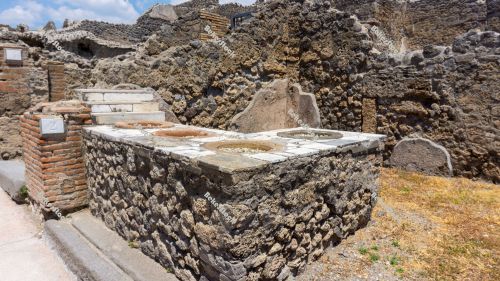


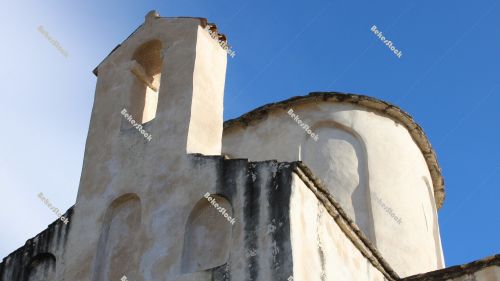
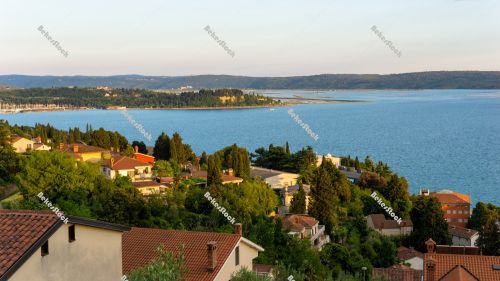
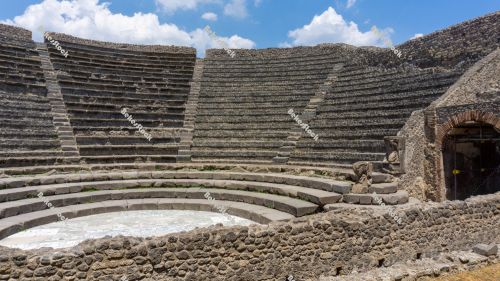

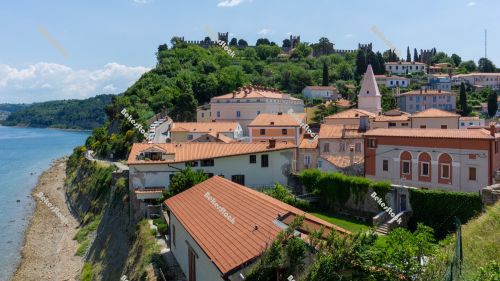

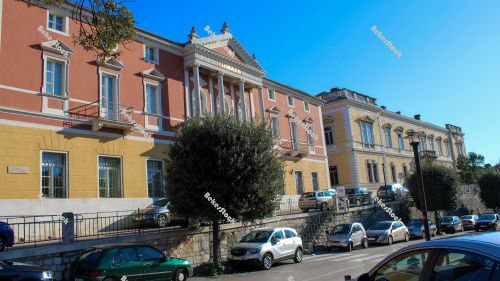

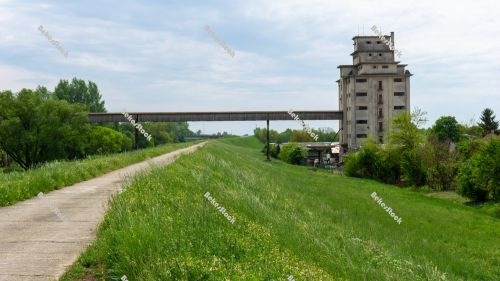
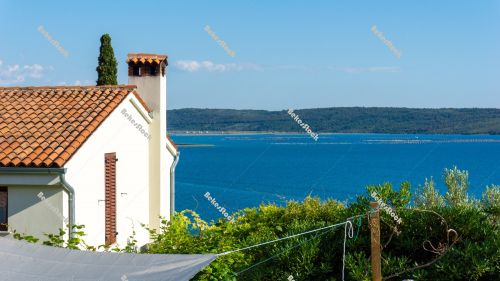
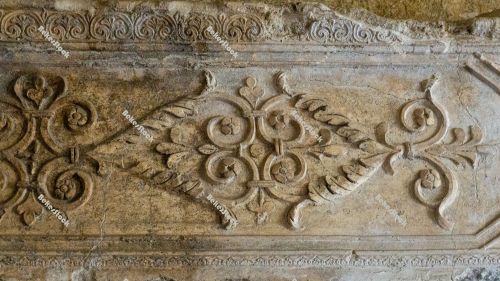
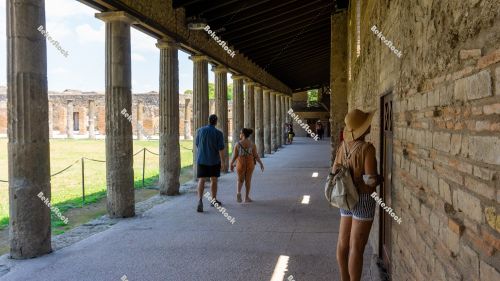

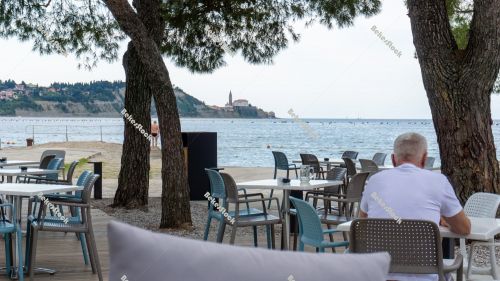
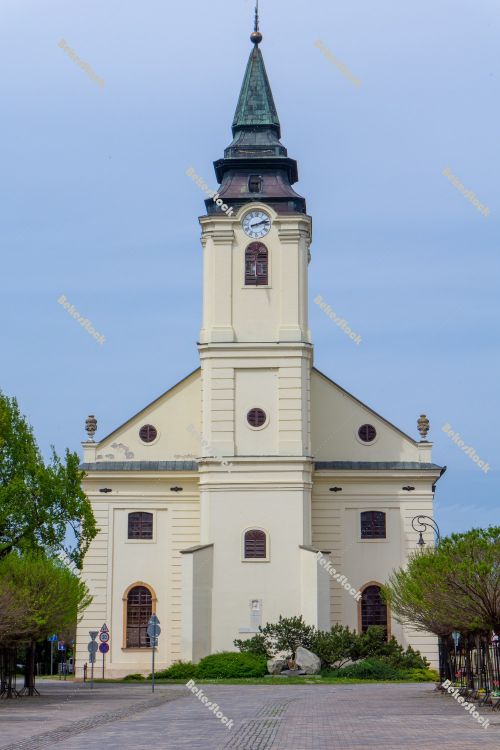
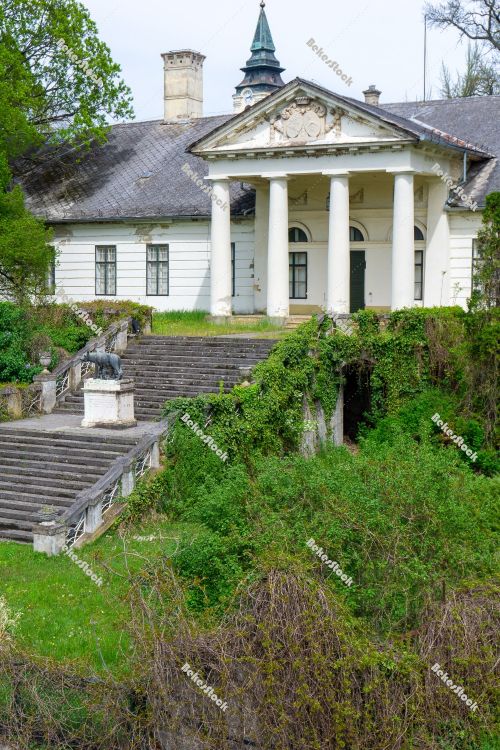
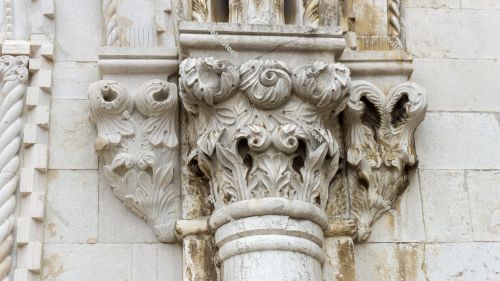
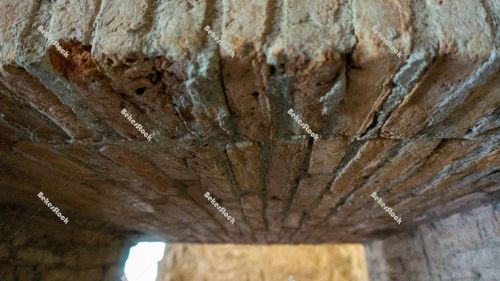
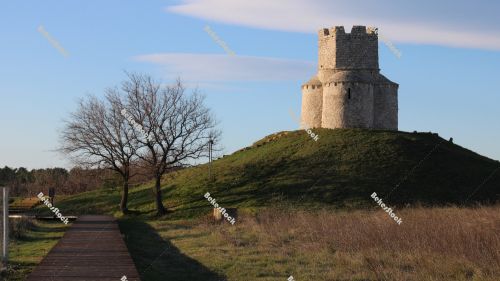
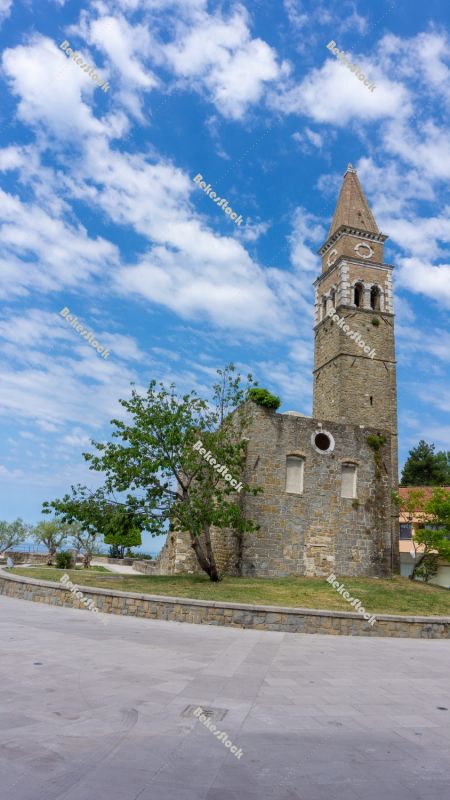
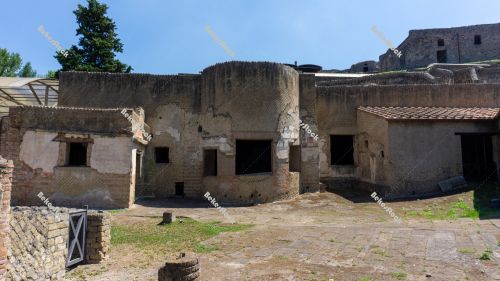
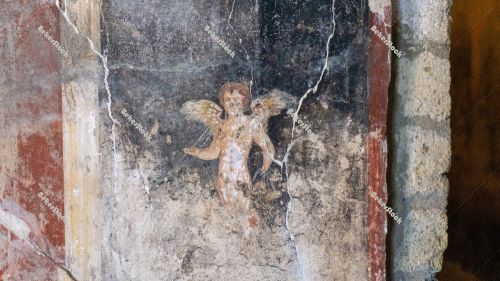
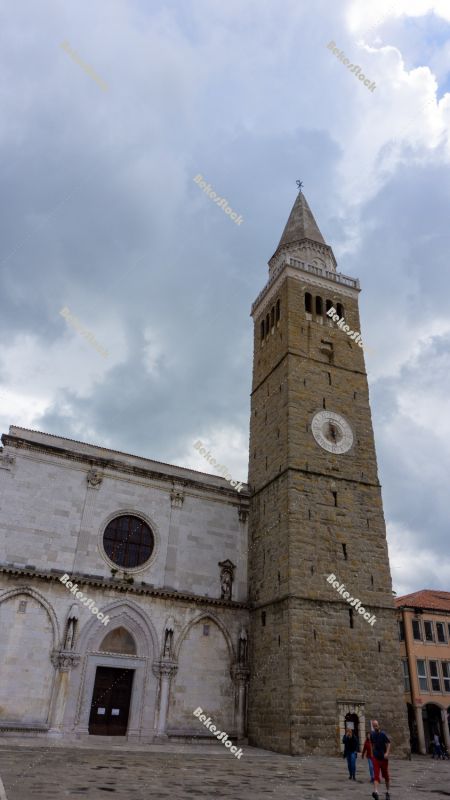
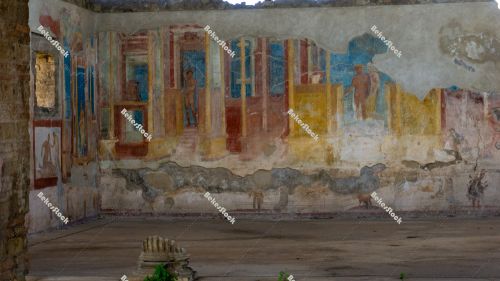
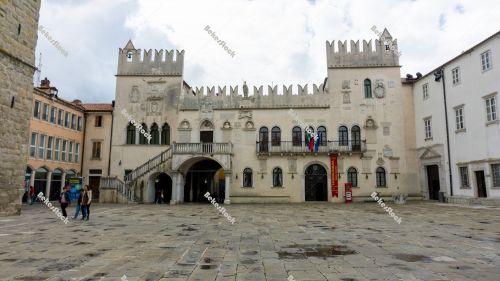
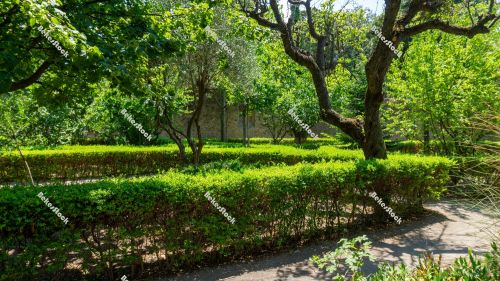

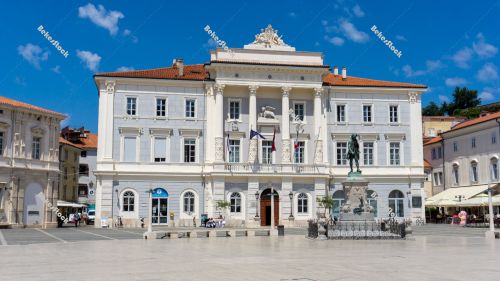
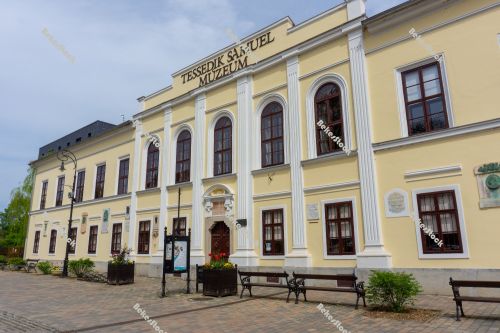

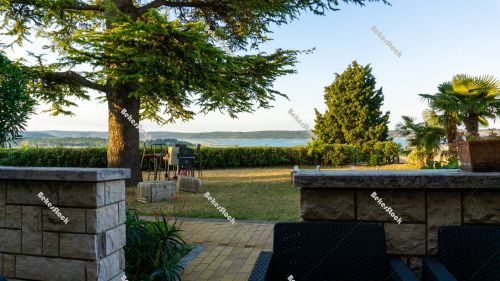
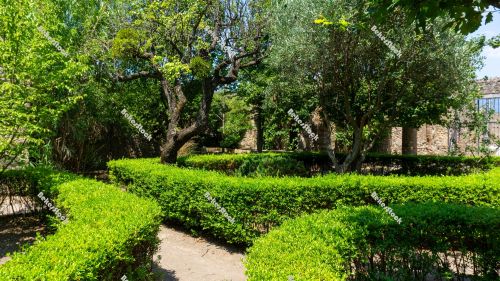


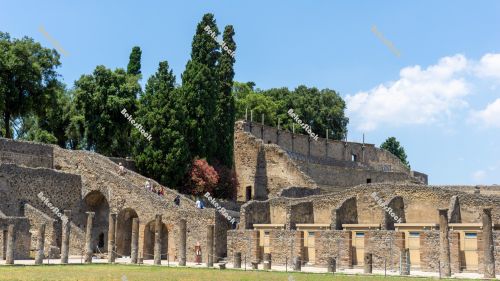

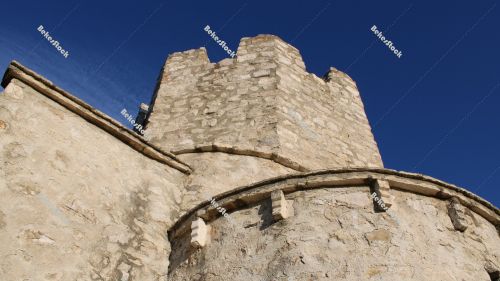
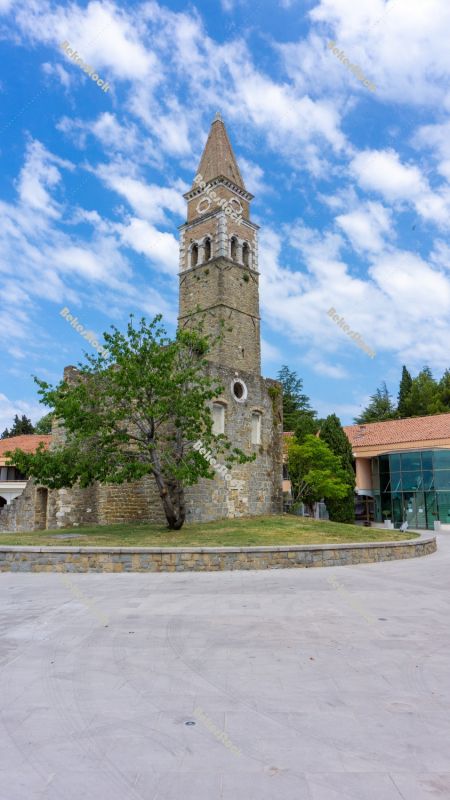
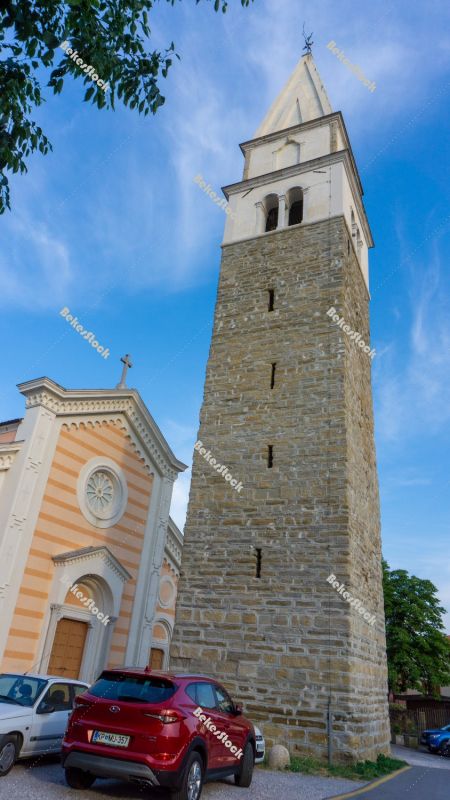
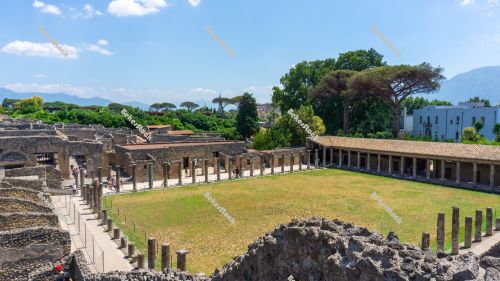

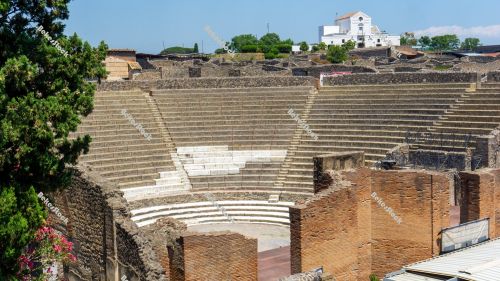
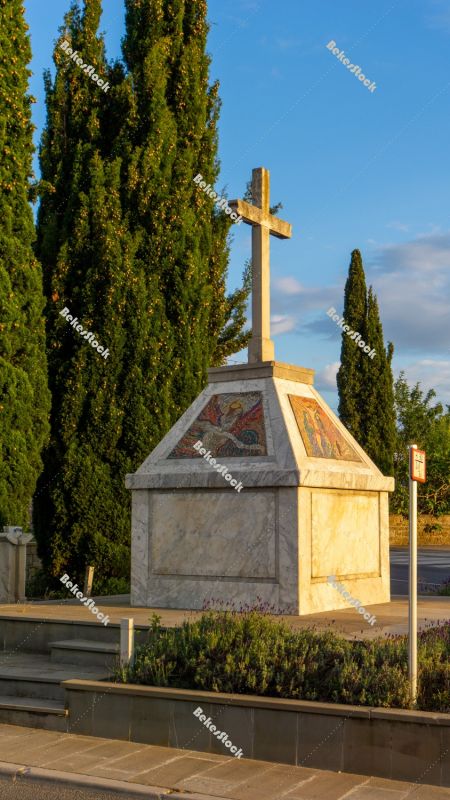
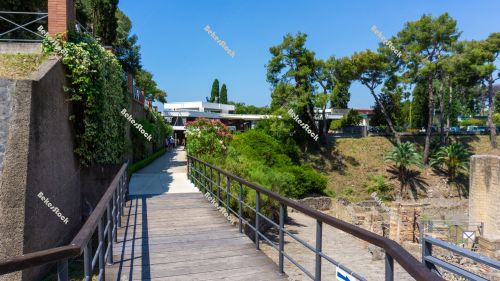
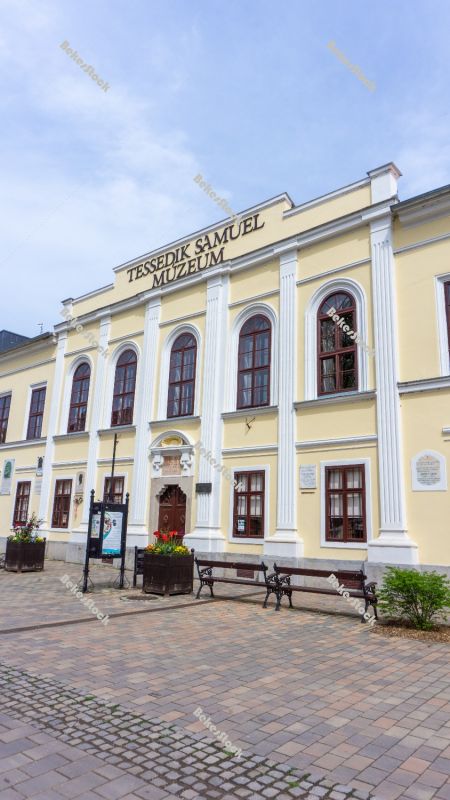
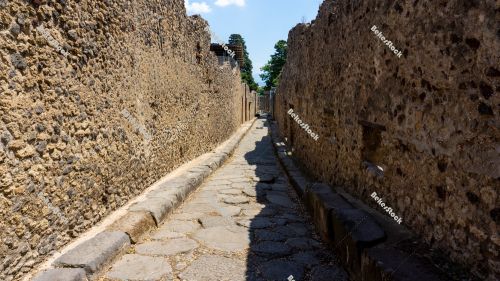

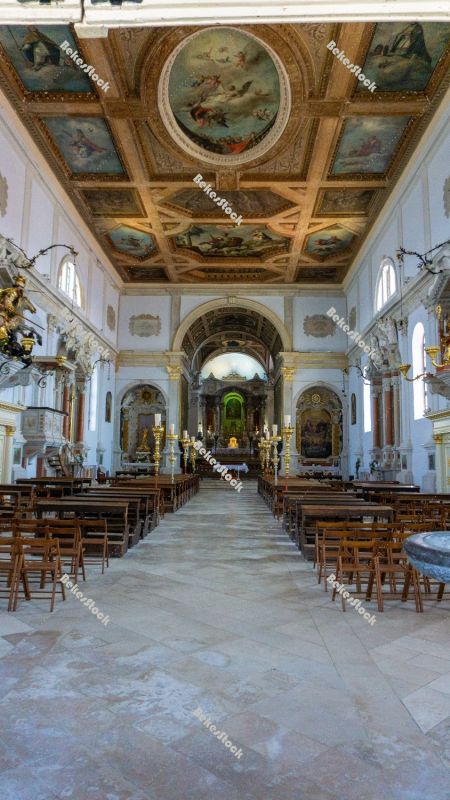
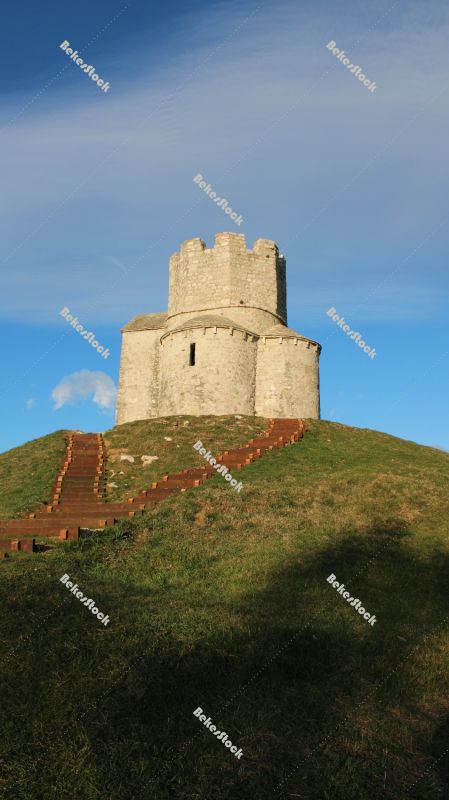
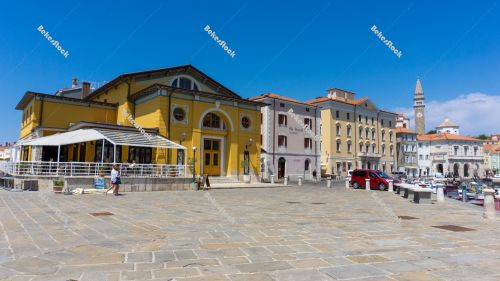
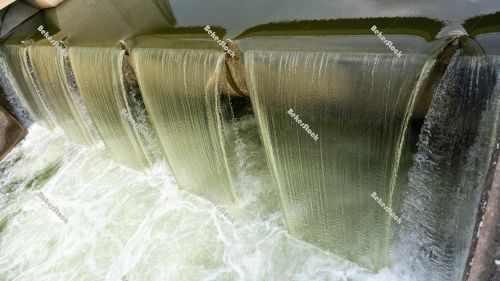


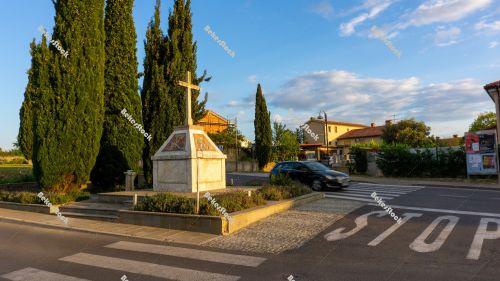
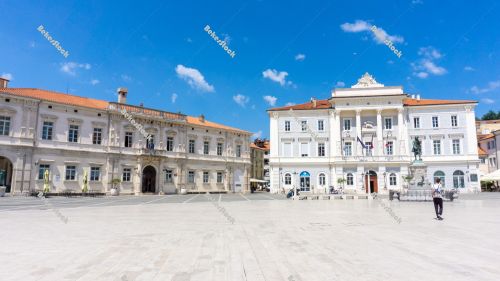
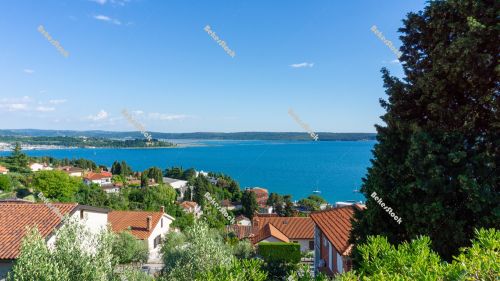

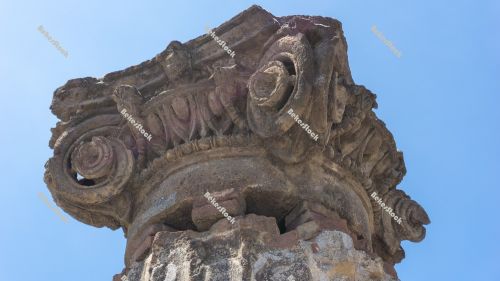

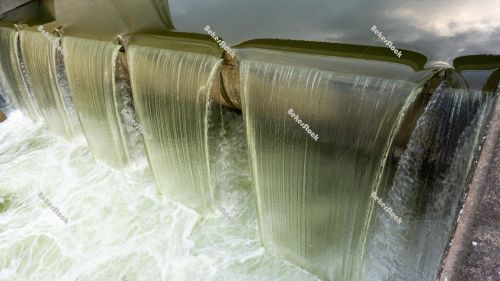
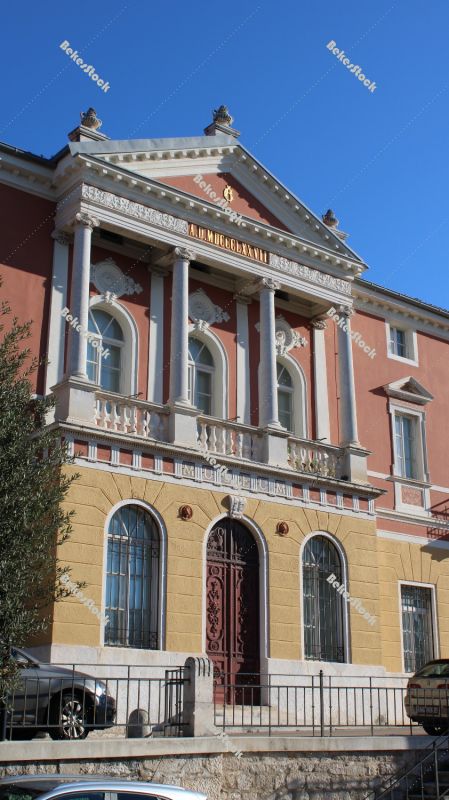


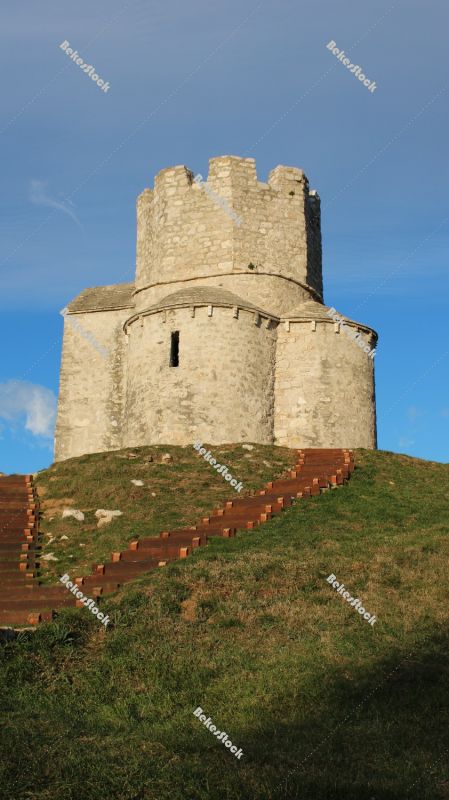
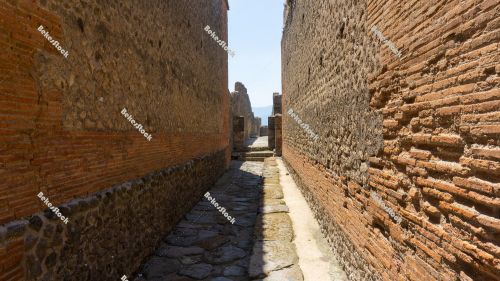



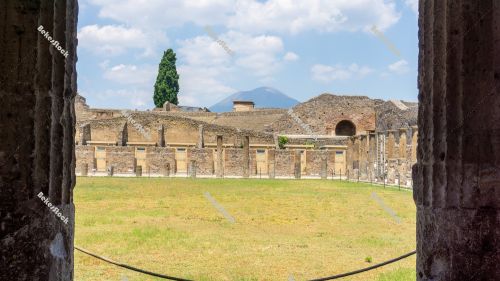
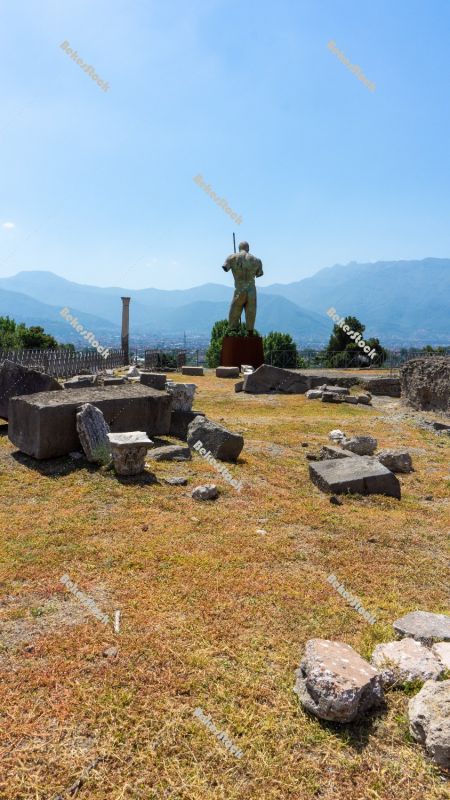

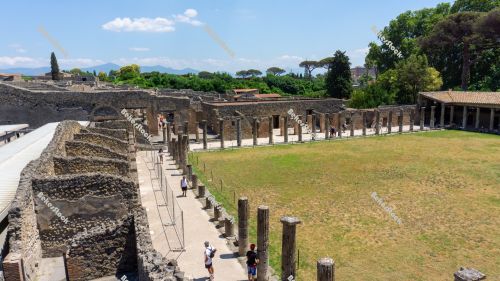

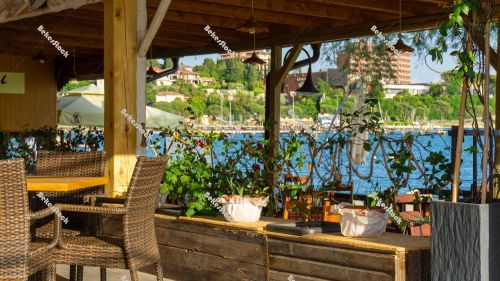
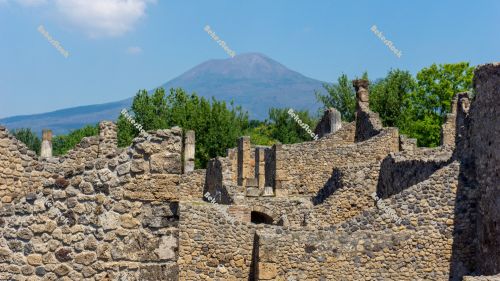
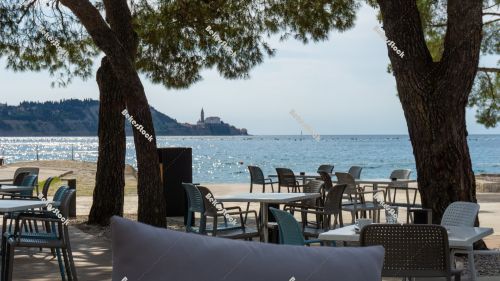
-
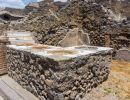 Ancient tavern (Thermopolium) in Pompeii. Pompei, Campania, Ital
Ancient tavern (Thermopolium) in Pompeii. Pompei, Campania, Ital -
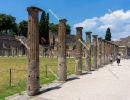 Cloister - QUADRIPORTICUS OF THE THEATRES OR GLADIATORS BARRACKS
Cloister - QUADRIPORTICUS OF THE THEATRES OR GLADIATORS BARRACKS -
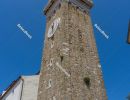 Bell Tower, `Zvonik Campanile`, Portoroz, Piran, Obalno-kraska,
Bell Tower, `Zvonik Campanile`, Portoroz, Piran, Obalno-kraska, -
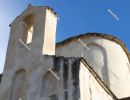 The Church of the Holy Cross - Nin
The Church of the Holy Cross - Nin -
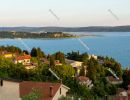 View from the terrace of Vila Toni at sunset, Portoroz, Piran, O
View from the terrace of Vila Toni at sunset, Portoroz, Piran, O -
 SMALL THEATRE – ODEON in Pompeii. Pompei, Campania, Italy, Jul
SMALL THEATRE – ODEON in Pompeii. Pompei, Campania, Italy, Jul -
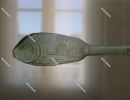 Glass fish - Museum of Ancient Glass, Zadar, Croatia, December 2019
Glass fish - Museum of Ancient Glass, Zadar, Croatia, December 2019 -
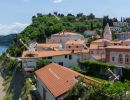 View of Piran Old Town from the tower of St. George's Cathedral,
View of Piran Old Town from the tower of St. George's Cathedral, -
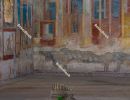 GYMNASIUM OF THE IUVENES. The entrance of the Gymnasium is locat
GYMNASIUM OF THE IUVENES. The entrance of the Gymnasium is locat -
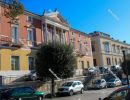 Museum of Ancient Glass (Muzej antičkog stakla u Zadru), Zadar,
Museum of Ancient Glass (Muzej antičkog stakla u Zadru), Zadar, -
 View from the terrace of Vila Toni at sunset, Portoroz, Piran, O
View from the terrace of Vila Toni at sunset, Portoroz, Piran, O -
 Grain silo on the Kettos-Koros river in Bekes - tarhaz, storehou
Grain silo on the Kettos-Koros river in Bekes - tarhaz, storehou -
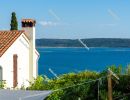 View from the mountain to the Adriatic Sea, Portoroz, Piran, Oba
View from the mountain to the Adriatic Sea, Portoroz, Piran, Oba -
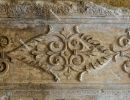 Wall decoration, stucco in the Suburban Baths in Pompeii. Pompei
Wall decoration, stucco in the Suburban Baths in Pompeii. Pompei -
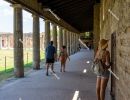 Cloister - QUADRIPORTICUS OF THE THEATRES OR GLADIATORS BARRACKS
Cloister - QUADRIPORTICUS OF THE THEATRES OR GLADIATORS BARRACKS -
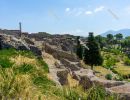 Bronze statue of Daedalus (`Dedalo`) on the terrace of the Sanct
Bronze statue of Daedalus (`Dedalo`) on the terrace of the Sanct -
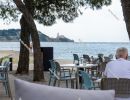 View of Piran from Strunjan, Piran, Obalno-kraska, Slovenia, Jun
View of Piran from Strunjan, Piran, Obalno-kraska, Slovenia, Jun -
 Lutheran Old Church (Evangelistic Old Church, `Evangélikus óte
Lutheran Old Church (Evangelistic Old Church, `Evangélikus óte -
 Bolza Castle (`Bolza-kastély`). Szarvas, Bekes County, Hungary
Bolza Castle (`Bolza-kastély`). Szarvas, Bekes County, Hungary -
 Column head - Cathedral of the Assumption of the Blessed Virgin
Column head - Cathedral of the Assumption of the Blessed Virgin -
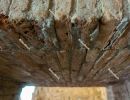 The door is a brick ceiling in the Suburban Baths in Pompeii. Po
The door is a brick ceiling in the Suburban Baths in Pompeii. Po -
 ST. NICHOLAS CHURCH - Nin
ST. NICHOLAS CHURCH - Nin -
 Church of St Bernardine - 'Cerkev sv. Bernardina', Portoroz, Pir
Church of St Bernardine - 'Cerkev sv. Bernardina', Portoroz, Pir -
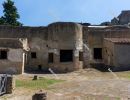 The Suburban Baths in Pompeii. Pompei, Campania, Italy, July 202
The Suburban Baths in Pompeii. Pompei, Campania, Italy, July 202 -
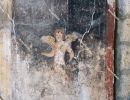 Detail of a fresco in the Suburban Baths in Pompeii. Pompei, Cam
Detail of a fresco in the Suburban Baths in Pompeii. Pompei, Cam -
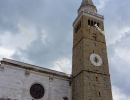 Cathedral of the Assumption of the Blessed Virgin Mary, Koper. C
Cathedral of the Assumption of the Blessed Virgin Mary, Koper. C -
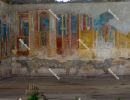 GYMNASIUM OF THE IUVENES. The entrance of the Gymnasium is locat
GYMNASIUM OF THE IUVENES. The entrance of the Gymnasium is locat -
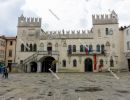 Praetorian Palace (Slovene: `Pretorska palača`, Italian: `palaz
Praetorian Palace (Slovene: `Pretorska palača`, Italian: `palaz -
 Botanical Garden (`Orto Botanico`) in Pompeii. Pompei, Campania,
Botanical Garden (`Orto Botanico`) in Pompeii. Pompei, Campania, -
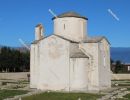 The Church of the Holy Cross - Nin
The Church of the Holy Cross - Nin -
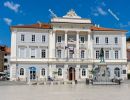 Piran Town Hall, 'Mestna hisa', Piran, Obalno-kraska, Slovenia,
Piran Town Hall, 'Mestna hisa', Piran, Obalno-kraska, Slovenia, -
 Sámuel Tessedik Museum (`Tessedik Sámuel Múzeum`). Szarvas, B
Sámuel Tessedik Museum (`Tessedik Sámuel Múzeum`). Szarvas, B -
 Old style lock and padlock on the blue wooden door - Portoroz, P
Old style lock and padlock on the blue wooden door - Portoroz, P -
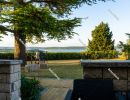 Dawn on the terrace of 'Vila Toni', Portoroz, Piran, Obalno-kras
Dawn on the terrace of 'Vila Toni', Portoroz, Piran, Obalno-kras -
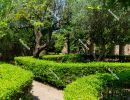 Botanical Garden (`Orto Botanico`) in Pompeii. Pompei, Campania,
Botanical Garden (`Orto Botanico`) in Pompeii. Pompei, Campania, -
 Old-fashioned, rusty lock and padlock on blue wooden door - Port
Old-fashioned, rusty lock and padlock on blue wooden door - Port -
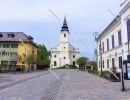 Lutheran Old Church (Evangelistic Old Church, `Evangélikus óte
Lutheran Old Church (Evangelistic Old Church, `Evangélikus óte -
 QUADRIPORTICUS OF THE THEATRES OR GLADIATORS BARRACKS in Pompeii
QUADRIPORTICUS OF THE THEATRES OR GLADIATORS BARRACKS in Pompeii -
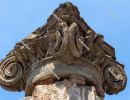 Ancient Roman column capital (head) with blue sky in the backgro
Ancient Roman column capital (head) with blue sky in the backgro -
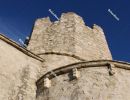 ST. NICHOLAS CHURCH - Nin
ST. NICHOLAS CHURCH - Nin -
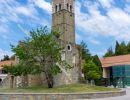 Church of St Bernardine - 'Cerkev sv. Bernardina', Portoroz, Pir
Church of St Bernardine - 'Cerkev sv. Bernardina', Portoroz, Pir -
 St. Maurus's Parish Church - `Župnijska cerkev sv. Mavra`, Izol
St. Maurus's Parish Church - `Župnijska cerkev sv. Mavra`, Izol -
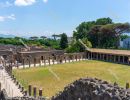 QUADRIPORTICUS OF THE THEATRES OR GLADIATORS BARRACKS in Pompeii
QUADRIPORTICUS OF THE THEATRES OR GLADIATORS BARRACKS in Pompeii -
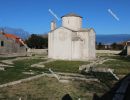 The Church of the Holy Cross - Nin
The Church of the Holy Cross - Nin -
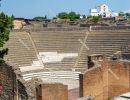 Large Theatre (`Teatro Grande`) in Pompeii. Pompei, Campania, It
Large Theatre (`Teatro Grande`) in Pompeii. Pompei, Campania, It -
 Column (cross) 'Beli Kriz' at sunset, Portoroz, Piran, Obalno-kr
Column (cross) 'Beli Kriz' at sunset, Portoroz, Piran, Obalno-kr -
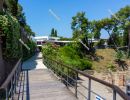 Ticket office in the Archaeological Park of Pompeii, photographe
Ticket office in the Archaeological Park of Pompeii, photographe -
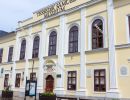 Sámuel Tessedik Museum (`Tessedik Sámuel Múzeum`). Szarvas, B
Sámuel Tessedik Museum (`Tessedik Sámuel Múzeum`). Szarvas, B -
 Street (`via`) in Pompeii. The narrow street is lined with stone
Street (`via`) in Pompeii. The narrow street is lined with stone -
 Mosaic decoration in the Suburban Baths in Pompeii. Pompei, Camp
Mosaic decoration in the Suburban Baths in Pompeii. Pompei, Camp -
 Inside St George's Cathedral, `Župnijska cerkev sv. Jurija`, Po
Inside St George's Cathedral, `Župnijska cerkev sv. Jurija`, Po -
![ST. NICHOLAS CHURCH - Nin ST. NICHOLAS CHURCH - Nin]() ST. NICHOLAS CHURCH - Nin
ST. NICHOLAS CHURCH - Nin -
![Tartini Theatre, `Gledališče Tartini`. Piran, Obalno-kraska, S Tartini Theatre, `Gledališče Tartini`. Piran, Obalno-kraska, S]() Tartini Theatre, `Gledališče Tartini`. Piran, Obalno-kraska, S
Tartini Theatre, `Gledališče Tartini`. Piran, Obalno-kraska, S -
![Dam on the Kettos-Koros River near Bekes - duzzaszto gat Dam on the Kettos-Koros River near Bekes - duzzaszto gat]() Dam on the Kettos-Koros River near Bekes - duzzaszto gat
Dam on the Kettos-Koros River near Bekes - duzzaszto gat -
![Church of St Bernardine - 'Cerkev sv. Bernardina', Portoroz, Pir Church of St Bernardine - 'Cerkev sv. Bernardina', Portoroz, Pir]() Church of St Bernardine - 'Cerkev sv. Bernardina', Portoroz, Pir
Church of St Bernardine - 'Cerkev sv. Bernardina', Portoroz, Pir -
![Guests are sitting on the terrace of the cafe, Piran, Obalno-kra Guests are sitting on the terrace of the cafe, Piran, Obalno-kra]() Guests are sitting on the terrace of the cafe, Piran, Obalno-kra
Guests are sitting on the terrace of the cafe, Piran, Obalno-kra -
![Column (cross) 'Beli Kriz' at sunset, Portoroz, Piran, Obalno-kr Column (cross) 'Beli Kriz' at sunset, Portoroz, Piran, Obalno-kr]() Column (cross) 'Beli Kriz' at sunset, Portoroz, Piran, Obalno-kr
Column (cross) 'Beli Kriz' at sunset, Portoroz, Piran, Obalno-kr -
![Piran Town Hall, 'Mestna hisa', Piran, Obalno-kraska, Slovenia, Piran Town Hall, 'Mestna hisa', Piran, Obalno-kraska, Slovenia,]() Piran Town Hall, 'Mestna hisa', Piran, Obalno-kraska, Slovenia,
Piran Town Hall, 'Mestna hisa', Piran, Obalno-kraska, Slovenia, -
![View from the balcony of Vila Toni, Portoroz, Piran, Obalno-kras View from the balcony of Vila Toni, Portoroz, Piran, Obalno-kras]() View from the balcony of Vila Toni, Portoroz, Piran, Obalno-kras
View from the balcony of Vila Toni, Portoroz, Piran, Obalno-kras -
![Courtyard of a building in Pompeii, with Lenader and the blue sk Courtyard of a building in Pompeii, with Lenader and the blue sk]() Courtyard of a building in Pompeii, with Lenader and the blue sk
Courtyard of a building in Pompeii, with Lenader and the blue sk -
![Ancient Roman column capital (head) with blue sky in the backgro Ancient Roman column capital (head) with blue sky in the backgro]() Ancient Roman column capital (head) with blue sky in the backgro
Ancient Roman column capital (head) with blue sky in the backgro -
![View of Piran Old Town from the tower of St. George's Cathedral, View of Piran Old Town from the tower of St. George's Cathedral,]() View of Piran Old Town from the tower of St. George's Cathedral,
View of Piran Old Town from the tower of St. George's Cathedral, -
![Dam on the Kettos-Koros River near Bekes - duzzaszto gat Dam on the Kettos-Koros River near Bekes - duzzaszto gat]() Dam on the Kettos-Koros River near Bekes - duzzaszto gat
Dam on the Kettos-Koros River near Bekes - duzzaszto gat -
![Museum of Ancient Glass (Muzej antičkog stakla u Zadru), Zadar, Museum of Ancient Glass (Muzej antičkog stakla u Zadru), Zadar,]() Museum of Ancient Glass (Muzej antičkog stakla u Zadru), Zadar,
Museum of Ancient Glass (Muzej antičkog stakla u Zadru), Zadar, -
![Dam on the Kettos-Koros River near Bekes - duzzaszto gat Dam on the Kettos-Koros River near Bekes - duzzaszto gat]() Dam on the Kettos-Koros River near Bekes - duzzaszto gat
Dam on the Kettos-Koros River near Bekes - duzzaszto gat -
![Civil Forum in Pompeii. The blue sky and Mount Vesuvius provide Civil Forum in Pompeii. The blue sky and Mount Vesuvius provide]() Civil Forum in Pompeii. The blue sky and Mount Vesuvius provide
Civil Forum in Pompeii. The blue sky and Mount Vesuvius provide -
![ST. NICHOLAS CHURCH - Nin ST. NICHOLAS CHURCH - Nin]() ST. NICHOLAS CHURCH - Nin
ST. NICHOLAS CHURCH - Nin -
![Alley way (`vicolo`) in Pompeii. The narrow street is lined with Alley way (`vicolo`) in Pompeii. The narrow street is lined with]() Alley way (`vicolo`) in Pompeii. The narrow street is lined with
Alley way (`vicolo`) in Pompeii. The narrow street is lined with -
![Museum of Ancient Glass (Muzej antičkog stakla u Zadru), Zadar, Museum of Ancient Glass (Muzej antičkog stakla u Zadru), Zadar,]() Museum of Ancient Glass (Muzej antičkog stakla u Zadru), Zadar,
Museum of Ancient Glass (Muzej antičkog stakla u Zadru), Zadar, -
![Bolza Castle (`Bolza-kastély`). Szarvas, Bekes County, Hungary Bolza Castle (`Bolza-kastély`). Szarvas, Bekes County, Hungary]() Bolza Castle (`Bolza-kastély`). Szarvas, Bekes County, Hungary
Bolza Castle (`Bolza-kastély`). Szarvas, Bekes County, Hungary -
![Detail of a graffiti in Pompeii. Pompei, Campania, Italy, July 2 Detail of a graffiti in Pompeii. Pompei, Campania, Italy, July 2]() Detail of a graffiti in Pompeii. Pompei, Campania, Italy, July 2
Detail of a graffiti in Pompeii. Pompei, Campania, Italy, July 2 -
![The view of Vesuvius from the Gladiators' Barracks. Pompei, Camp The view of Vesuvius from the Gladiators' Barracks. Pompei, Camp]() The view of Vesuvius from the Gladiators' Barracks. Pompei, Camp
The view of Vesuvius from the Gladiators' Barracks. Pompei, Camp -
![Sanctuary of Venus with bronze statue of Daedalus (`Dedalo`) in Sanctuary of Venus with bronze statue of Daedalus (`Dedalo`) in]() Sanctuary of Venus with bronze statue of Daedalus (`Dedalo`) in
Sanctuary of Venus with bronze statue of Daedalus (`Dedalo`) in -
![Fake cave, adorned with a mosaic in the Suburban Baths in Pompei Fake cave, adorned with a mosaic in the Suburban Baths in Pompei]() Fake cave, adorned with a mosaic in the Suburban Baths in Pompei
Fake cave, adorned with a mosaic in the Suburban Baths in Pompei -
![QUADRIPORTICUS OF THE THEATRES OR GLADIATORS BARRACKS in Pompeii QUADRIPORTICUS OF THE THEATRES OR GLADIATORS BARRACKS in Pompeii]() QUADRIPORTICUS OF THE THEATRES OR GLADIATORS BARRACKS in Pompeii
QUADRIPORTICUS OF THE THEATRES OR GLADIATORS BARRACKS in Pompeii -
![Wooden door of the Bell Tower, `Zvonik Campanile`, Portoroz, Pir Wooden door of the Bell Tower, `Zvonik Campanile`, Portoroz, Pir]() Wooden door of the Bell Tower, `Zvonik Campanile`, Portoroz, Pir
Wooden door of the Bell Tower, `Zvonik Campanile`, Portoroz, Pir -
![Bar terrace in Portoroz on the Adriatic coast, 'Cafe Bar Pri Pom Bar terrace in Portoroz on the Adriatic coast, 'Cafe Bar Pri Pom]() Bar terrace in Portoroz on the Adriatic coast, 'Cafe Bar Pri Pom
Bar terrace in Portoroz on the Adriatic coast, 'Cafe Bar Pri Pom -
![Ancient ruins of Pompeii, with Mount Vesuvius (`Vesuvio`) in the Ancient ruins of Pompeii, with Mount Vesuvius (`Vesuvio`) in the]() Ancient ruins of Pompeii, with Mount Vesuvius (`Vesuvio`) in the
Ancient ruins of Pompeii, with Mount Vesuvius (`Vesuvio`) in the -
![View of Piran from Strunjan, Piran, Obalno-kraska, Slovenia, Jun View of Piran from Strunjan, Piran, Obalno-kraska, Slovenia, Jun]() View of Piran from Strunjan, Piran, Obalno-kraska, Slovenia, Jun
View of Piran from Strunjan, Piran, Obalno-kraska, Slovenia, Jun

